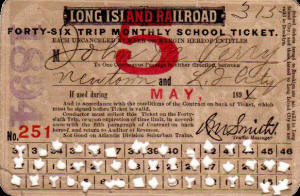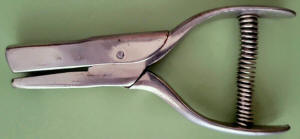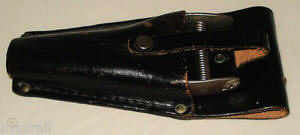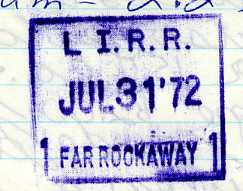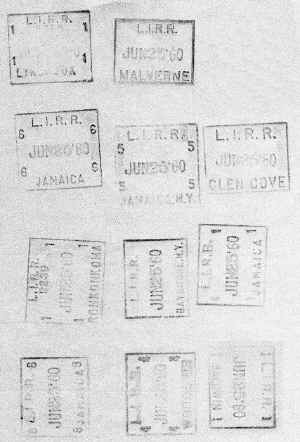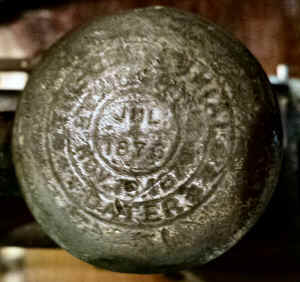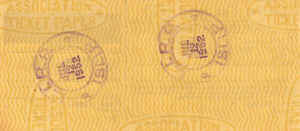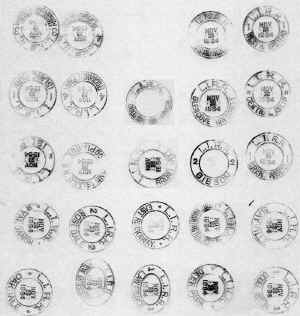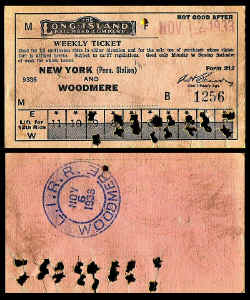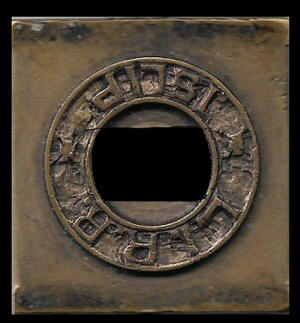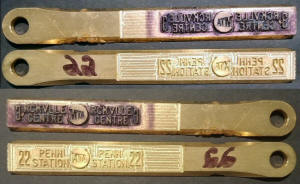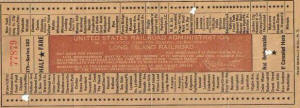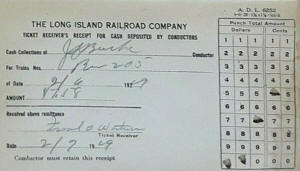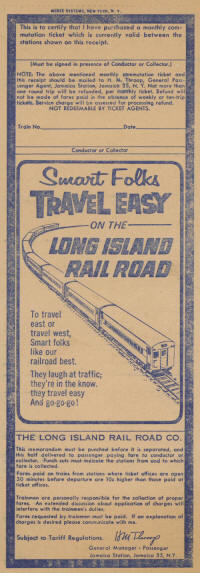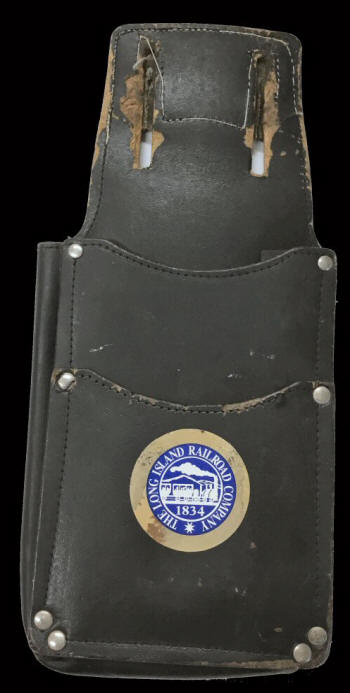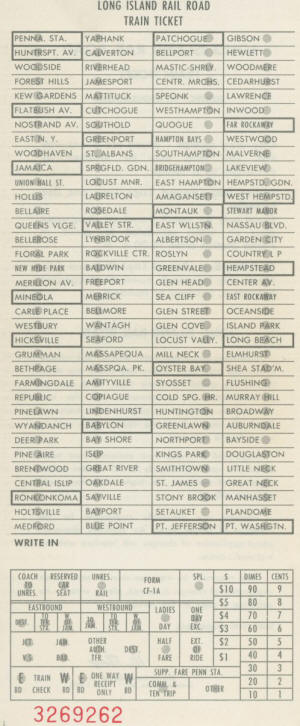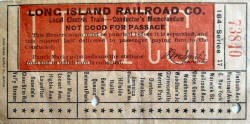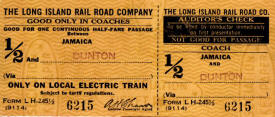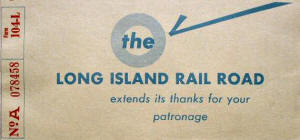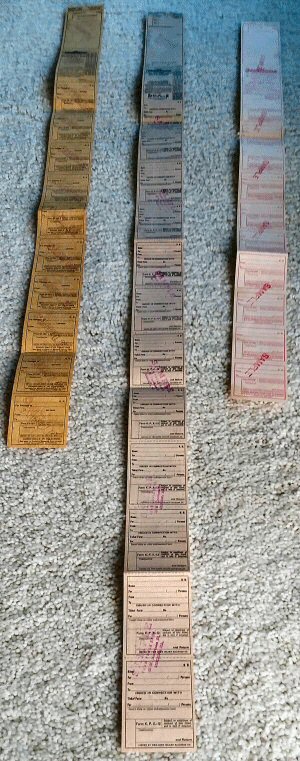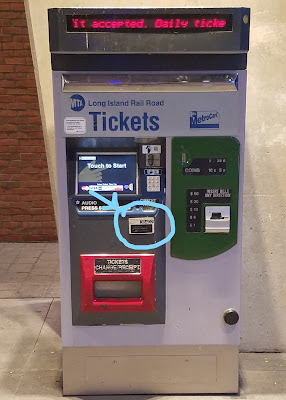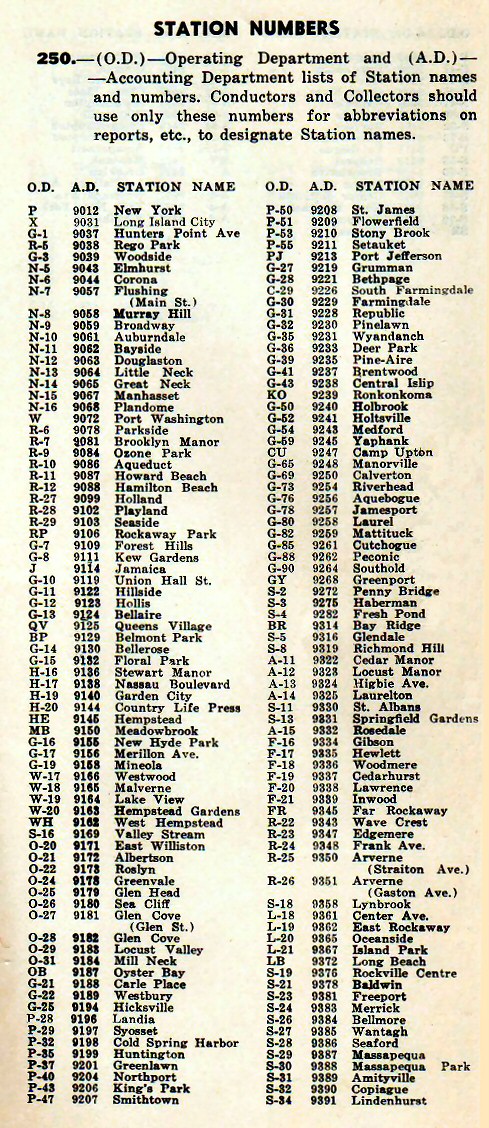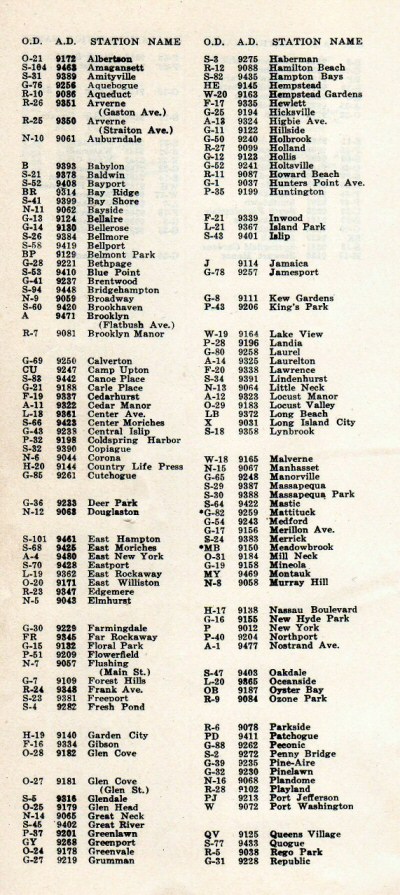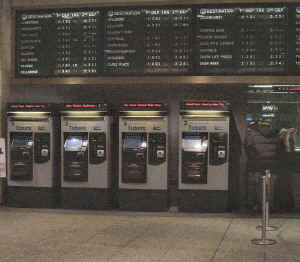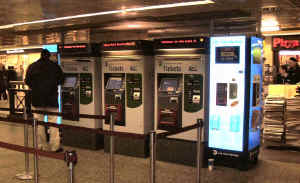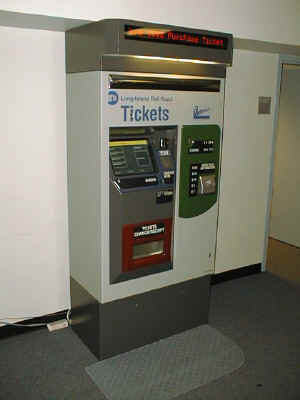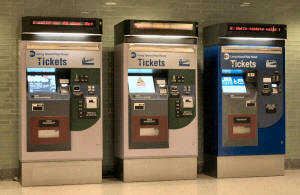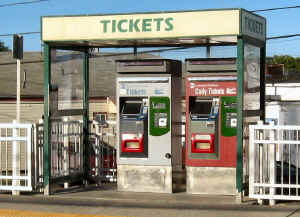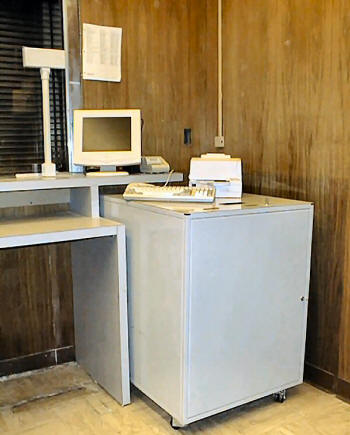| TICKETS, DATER DIES, AND TICKET VENDING MACHINES | |||||||||||
|
10 Trip 1H and 1-BH Beach Bus Cash Fare Receipts-CFR Clergy Coupon Booklets Dater Stampers Electric Lines Excursion Fare Cards Fare Lists Ferry General Passenger Agents (GPA) |
Grand Central Madison - Combo Group Party Half Fare Interline Magnetic Mail & Ride Metrocard Mileage Military-Furlough Monthly Monthly Flash One Way Parlor Photo |
Police-Fireman Race Track Reduced Rate Round Trip School Seat Checks Striped Supplemental Ticket Cases Ticket Punches TVM Tickets - Vending Machines (TVM) Weekly Zone Fare Zone Fare Charts |
|||||||||
|
|
|||||||||||
| EARLY LIRR TICKETS | |||||||||||
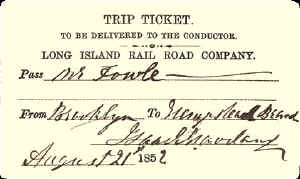 Long Island Rail Road Trip Ticket from Brooklyn to Hempstead Branch (Mineola) 8/21/1852 (Later renamed Mineola as of timetable 8/21/1852)
|
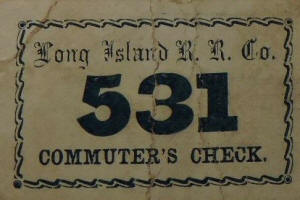 Commuter check #531 Brooklyn to Hempstead Station 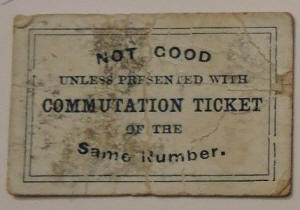 |
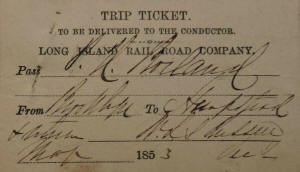 Long Island Rail Road Trip Ticket from Brooklyn to Hempstead Station 5/1853 |
|||||||||
|
Note: Use of apostrophe in Hunter's, later dropped. |
|
||||||||||
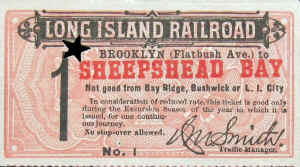 1890's LIRR Brooklyn (Flatbush Ave.) to Sheepshead Bay sample ticket No. 1. |
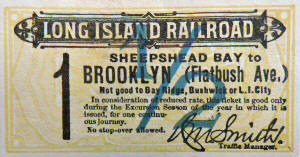 1890's LIRR Brooklyn (Flatbush Ave.) to Sheepshead Bay half fare ticket. |
||||||||||
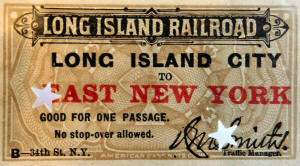 Ticket LI City to East New York c.1890's |
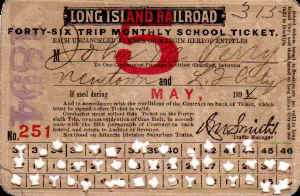 Forty-six trip monthly school commutation ticket: Newtown and LI City May 1894 Archive: Brad Phillips |
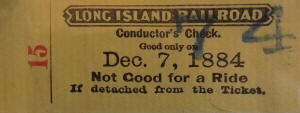 Conductor's Check - 12/07/1884 A conductor's check is part of a ticket. Similar to the auditor’s check on more modern tickets. Taken up by the trainman on first presentation by the passenger. Brad Phillips |
|||||||||
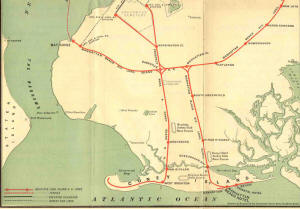 1894 map showing LIRR and subsidiary: Prospect Park & Coney Island Railroad Archive: Art Huneke |
Until Penn Station opened
in Sept., 1910, all traffic to NY, via the LIRR, |
|
|||||||||
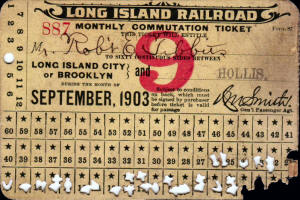 Monthly LI City or Brooklyn and Hollis 9/1903 GPA H. A. Smith - Archive: Brad Phillips |
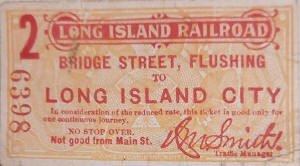 Bridge Street, Flushing to Long Island City - 5/22/1885 Traffic Mgr: H. M. Smith |
 Amagansett to Montauk -1890's -Traffic Mgr: Smith Archive: Richard Ryan |
|||||||||
 Manhattan Beach to East New York -1890's -Traffic Mgr: Smith Archive: Richard Ryan |
 Kouwenhoven to Manhattan Beach - 1890's - Traffic Mgr: Smith Archive: Richard Ryan |
 Manhattan Beach to Bay Ridge -1890's - Traffic Mgr: Smith Archive: Richard Ryan |
|||||||||
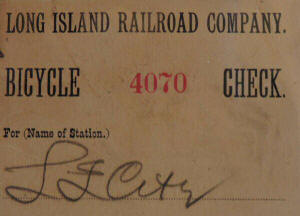 1890's bicycle claim check for LI City |
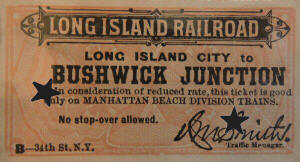 LI City to Bushwick Junction c.1890's
|
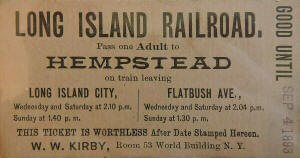 1893 LIRR realtor promo ticket - LI City or Flatbush Ave. to Hempstead |
|||||||||
|
Important Notes: When you see printed stock for some very odd-ball station stops such as Golf Grounds or Napeague Beach, you may get excited about them being some rarity, but then you see the serial numbers are missing so you know they're printer's samples, were never used for passage and were never issued at those stations. . . especially stations that never had an agency! A ticket with serial numbers but no dater die
impression on the back is still a valid ticket . . . it just was never
sold.
A ticket with serial numbers AND with a dater die impression on the back,
is a valid ticket that HAD been sold. All tickets have the General Passenger Agent's facsimile signature as they were never personally signed. That was only done in some very early tickets and on special trip passes; again only very early ones. Dave Keller Control numbers are serial numbers which are used to account for revenue. MOST tickets with numbers are valid (but not always, e.g. retired stock). Tickets without numbers are printers proofs or samples. Brad Phillips |
|||||||||||
|
|
|||||||||||
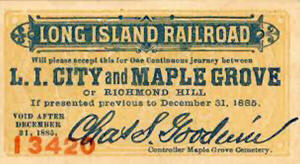 Ticket LI City to Maple Grove valid thru 12/31/1885 |
MAPLE GROVE : Opened: May/1879 as
flag stop for Maple Grove cemetery. Closed: 1882. reopened: 1883.
Removed in 1909 with realignment of tracks. moved approx. 600' south
alongside new site of Kew station (which opened 9/8/1910) and
perpendicular to tracks KEW: Opened: 9/8/1910 on re-aligned main line tracks south of ex-Maple Grove station site. Renamed "KEW GARDENS": 1912 Notice the realignment
"in-service" date matches the date of the first train run from Penn
Station. . . . . That historic train was probably the first to operate
"officially" along that realigned Main. Research: Dave Keller |
||||||||||
|
A rare LIRR ticket. Note the signature on the ticket is a cemetery official and not a LIRR General Passenger Agent. Also, the area that later became Kew Gardens was originally known as Richmond Hill. Hence, the 1950 LIRR horrible wreck at "Richmond Hill", which happened just east of the Kew Gardens station, was never called the Kew Gardens wreck but the Richmond Hill wreck. Richmond Hill was the name of the surrounding town, but Maple Grove was the name of the cemetery, and it had a depot for visitors to and from the cemetery. In 1910, the LIRR realigned its tracks, eliminating a wide sweeping curve of ROW through Maple Grove and thereby eliminating service to Maple Grove Cemetery, opening a new station south of that site called Kew, which later became Kew Gardens. The old depot at Maple Grove, no longer needed, was purchased by the realtor who was selling lots in Kew and was moved adjacent to the new Kew station (east side by the street overpass), set perpendicular to the north side of the tracks and used as a realty office for the land sales. Research: Dave Keller |
|||||||||||
|
|
|||||||||||
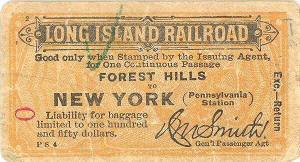 Opening Day Ticket September 8, 1910 Forest Hill to NY Penn Archive: Jerome Landsman 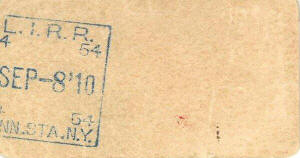 |
PART 5: PENN STATION OPENS AND A SUBURBAN COLOSSUS
EMERGES by George Chiasson, Jr. On September 8, 1910, electrified service was operated on the following complete routes, in general using MP-54 type steel Multiple-Unit equipment, and with a controversial 14 cents extra tacked onto each fare to cover a per train rental fee paid to the Pennsylvania Railroad: Hempstead Branch: Penn Station to Hempstead via
Jamaica and Floral Park. Stops at Woodside, Winfield,
|
||||||||||
|
|
|||||||||||
|
* Mar. 1, 1948 LIRR TT (timetable) appoints
Harry A. Weiss Traffic Manager to coordinate public relations to
counter the poor public image on Long Island. Research: Christopher T.
Baer Joe Sabina - 1971-1974 |
|||||||||||
|
|
|||||||||||
| FERRY TICKETS | |||||||||||
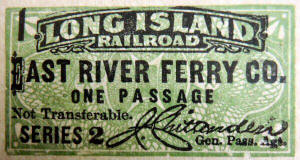 LIRR ticket East River Ferry -1879 |
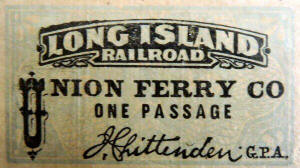 LIRR ticket - Union Ferry Co., Brooklyn 1879 |
 LIRR Commuter Ferry Check - One Foot Passenger LI City to James Slip or 34th St. 1879 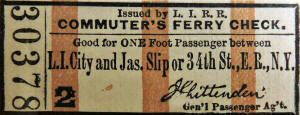 LIRR Issued Commuter Ferry Check - One Foot Passenger LI City to James Slip or 34th St., East River, N.Y. 1879 |
|||||||||
|
On September 25, 1874, the South Side R.R. of Long Island formally became a Poppenhusen subsidiary and was reorganized as The Southern Railroad Co. of Long Island. J. Chittenden, GPA of the Long Island Railroad and the Long Island and Southern Railroad, shows up in railway guides for 1877 as the GPA at the time. |
|||||||||||
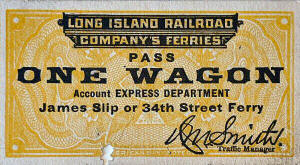 Long Island Railroad Company's Ferries - One Express Wagon ticket over James Slip Ferry, also good for 34th St. Ferry c.1890's. Howard Mapes Smith appointed LIRR Traffic Manager 4/2/1888 and later to GPA on 4/12/1901 Research: Brad Phillips |
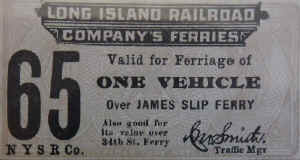 Long Island Railroad Company's Ferries - Vehicle ticket over James Slip Ferry, also good for 34th St. Ferry NYSR Co. 1899 |
 Form 124 Far Rockaway & NY Ex. - 34th-St. or James Slip Ferry c.1890's |
|||||||||
 Fire Island Excursion - LI Chautauqua Assembly Assoc. 1894-1898 c.1894 Archive: Brad Phillips Note: The printing on the left side of each ticket stub (“Exc.”) specifies “reduced rate” and specifies date limits. Usually, such language is associated with “excursion” tickets vs. regular fare tickets. Brad Phillips |
 Half fare (children) Fire Island Excursion c.1890's Archive: Brad Phillips |
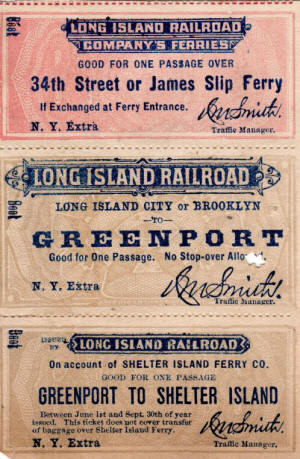 NY Extra - Greenport to Shelter Island c.1890's Archive: Brad Phillips
|
|||||||||
|
|
|||||||||||
| MILEAGE TICKETS | |||||||||||
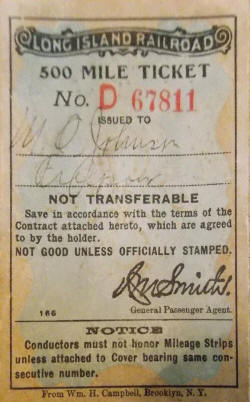 Form #166 - 500 Mile Ticket booklet - 1901+ GPA- H. M. Smith |
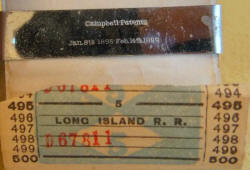 Mileage Ticket booklet coupon cutter and mileage coupons
|
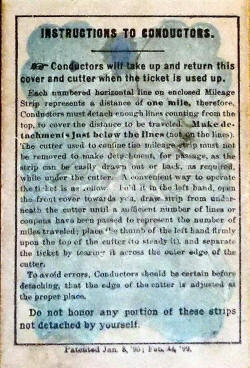 Form #166 - 500 Mile Ticket booklet back - 1901+ |
|||||||||
 |
 |
|
|||||||||
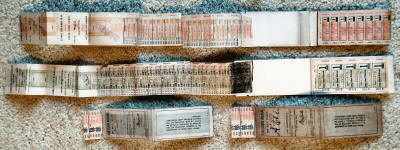 LIRR Mileage Tickets, the coupons stretch out for over 10 feet; seen here folded for the photo. Photo/Archive: Brad Phillips
500 mile tickets, and the like (referred to as mileage tickets), were issued by the railroads starting in the late 19th Century (e.g. MP 1897) and into the 20th Century (e.g. Maine Central 1917). Each state regulated how mileage tickets were issued and used. Perhaps an ICC directive, at some point, discontinued their usage. |
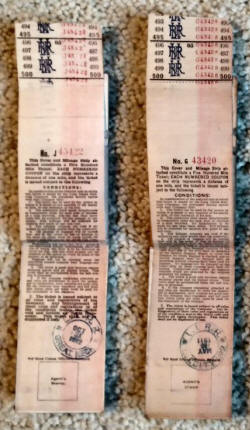 500 Mile Ticket Booklet 1911 and 1912 Photo/Archive: Brad Phillips |
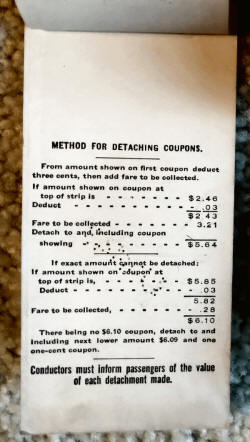 500 Mile Ticket Booklet - Conductor Coupon Detaching Instructions - Photo/Archive: Brad Phillips |
|||||||||
|
|
|||||||||||
|
EARLY ONE WAY TICKET VARIATION |
|||||||||||
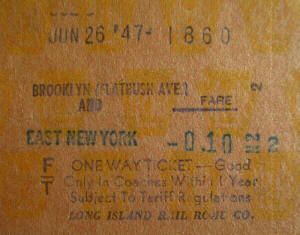 Ticket 10¢ One Way Brooklyn (Flatbush Ave.) and East New York 6/26/1947 |
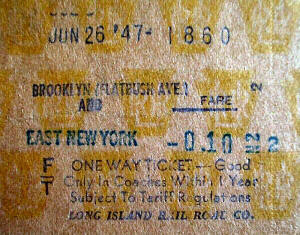 Ticket 10¢ One Way enhanced to show the LIRR Keystone watermarked paper. |
A short journey between two stations on the Atlantic Branch with a 10 cent fare. The IND subway line runs roughly parallel to the LIRR Atlantic Branch, a few blocks to the north. The Subway fare was still 5 cents in 1947. The LIRR would have been the quicker trip, for the cost of an additional nickel over the subway fare. John Deasy
Issued during the post WW II era of GPA Homer Bannard: 7/1/1946 -
12/1/1948 |
|||||||||
|
The photo is sharp enough to see the LIRR keystones on the paper stock for
authentication.. Perhaps cash register type machines were used at some
ticket offices back then? The date is June 26, 1947 with 1860 as the
control number. The ticket was probably printed at Flatbush Avenue, as the
East New York line on the ticket seems to be the one that was variable,
along with the price. That line looks to have been printed with a separate
ink ribbon. Each ticket would have a unique number, so 1861 would be next.
The date would be the date on which the ticket was issued.
The "1860" was printed by the machine that issued the ticket, along with the date. Generally, unprinted ticket stock would also carry a "control number," as the stock itself had value. The stock was further monetized and received a "ticket number" once it was printed. Without controls on the blank stock, it could be stolen or misused as there could be no accounting of it before it was printed. The only times a stock number wouldn't be employed would be the case of
limited-distribution materials, as in a trial or unique stock where the
distribution would be very limited to one or a few confidants. This may be
a rare LIRR ticket variation. Info: Mike McEnaney |
|||||||||||
|
|
|||||||||||
| COACH ONE WAY TICKETS | |||||||||||
 "First Class Passage" ticket Amagansett to Promised Land 12/25/1907 GPA: Smith - Archive: Richard F. Makse |
 "First Class Passage" ticket Water Mill to Bridgehampton GPA: Smith - Archive: Brad Phillips
Note: These three examples indicate good for
"First Class Passage". |
Note: HOWARD on the Rockaway Beach Branch 0.1 miles south of "WD"
Tower (west end of trestle) on ETT: #37 effective: 11/05/1905
|
|||||||||
 Form W 9-1 Whitestone to College Point c.1910+ GPA: Smith - Archive: Brad Phillips |
|
||||||||||
|
|
|
|
|||||||||
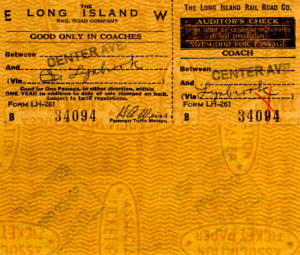 Ticket Form LH-261 between Center Ave. and Lynbrook 4/23/1962 Pass Traffic Mgr. Henry A. Weiss - Archive: Brad Phillips |
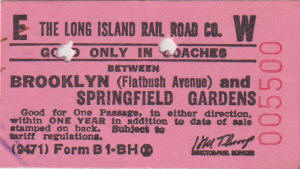 Ticket Form B1-BH coach one way Brooklyn (FBA) and Springfield Gardens 1969 Dir. Pass. Services: H. M. Throop Forms LH-233 Coach punch One Way and Form LH-238 Round Trip issued during the GPA: Shaw, Pennington, and Comer (1929?-1946) eras were discontinued. I’ve seen only 1 or 2 live examples. Perhaps it was just as easy to issue a LH-261, as it was to use one of these. - Info/Archive: Brad Phillips |
 Form LH-233 Coach punch one way from NY Penn c.1943 - GPA E. R. Comer |
|||||||||
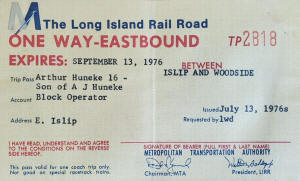 One Way-Eastbound - Islip and Woodside - 9/13/1976 |
|||||||||||
|
|
|||||||||||
| COACH ROUND TRIP TICKETS | |||||||||||
 Form 2 N 8-2 30 Day Round Trip - Bayside to Flushing 9/16/1939 Archive: Brad Phillips |
 Form 2 N 8-2 30 Day Round Trip - Bayside to Flushing Dater die reverse 9/16/1939 Archive: Brad Phillips |
||||||||||
|
Round trip
forms (2-HY and 2-BHY) were needed due to the Federal Transportation
Tax. In many cases, two one-way tickets cost 1¢ more than the round
trip, therefore they needed this form so customers |
|||||||||||
 Form 2-BH 60 Day Round Trip - Islip to Jamaica GPA: A. H. Shaw Archive: Brad Phillips |
 Form LH-360 60 Day Round Trip sample GPA: A. H. Shaw Archive: Brad Phillips |
 Form L-346 Round Trip blank (open form) GPA: C. G. Pennington Archive: Brad Phillips |
|||||||||
|
Note: The Jamaica ticket 60
day return trip is using the same form number |
Note: The 60 day blank tickets have Shaw signature on both portions and do not have a space for the fare on the agent stub. The open date ticket, issued later under Pennington, has a fare block, but signature on only the return portion; perhaps they were experimenting with different approaches. |
||||||||||
 Form 2½-HY Half Fare Round Trip coach - Far Rockaway and Woodside GPA: C. G. Pennington 1941-43 - Archive: Brad Phillips |
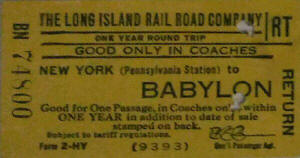 Form 2-HY Coach Round Trip - NY Penn to Babylon GPA: E. R. Comer 1943-46 - Archive: Brad Phillips |
 Form 2-HY Coach Round Trip - NY Penn and Wantagh Pass. Traffic Manager: H. A. Weiss 1953-64 Archive: Brad Phillips |
|||||||||
 Form 2-B H Round Trip coach - NY Penn and Far Rockaway Branch Stations - GPA A. H. Shaw - Archive: Brad Phillips  Form-2-B H Round Trip coach good for One Year NY Penn and Rockville Centre GPA A. H. Shaw - Archive: Brad Phillips |
 Form LH-238 Round Trip coach punch ticket from Jamaica GPA: Shaw - Archive: Brad Phillips |
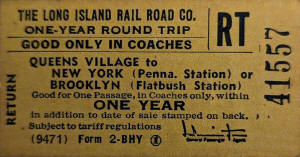 Form 2-BHY - Coach Round Trip good for One Year Queens Village to NY Penn or Brooklyn Flatbush GPA: C. G. Pennington 1941-43 |
|||||||||
 Form LH-234 Round Trip coach punch ticket from NY Penn - GPA: Pennington - Archive: Brad Phillips |
 Form 2-BHY Round Trip coach - NY Penn and Kew Gardens GPA E. R. Comer - Archive: Brad Phillips 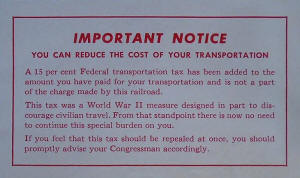 Federal Transportation Tax notice c.1955 Archive: Brad Phillips The Federal Transportation Tax started at 15% in 1941, reduced |
 Form 2-BHY Round Trip coach - NY Penn and Baldwin GPA H. A. Weiss - Archive: Brad Phillips
|
|||||||||
|
|
|||||||||||
| FIFTY TRIP FAMILY TICKET | |||||||||||
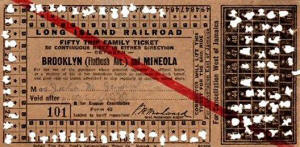 Form 40 - 50 Trip Family - Brooklyn and Mineola single-stripe 1920's GPA Woodward Archive: Brad Phillips |
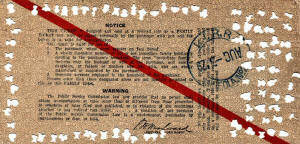 Form 40 - 50 Trip Family reverse 8/1929 Archive: Brad Phillips |
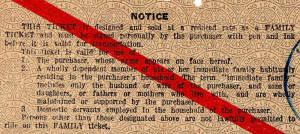 Family Ticket reverse NOTICE close-up. Note: Valid for transportation Item no.3: Domestic servants employed in the household of the purchaser. Archive: Brad Phillips |
|||||||||
|
|
|||||||||||
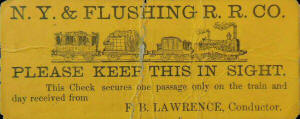 |
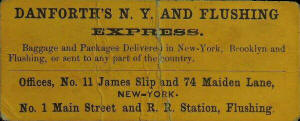 |
The New York & Flushing Railroad dates
back to 1859 and sold to the LIRR in 1865. It appears the express
service indicated on the back of the seat check was simply the advertising
of a local express firm with relationships to other, long-distance
carriers as stated: ". . . or sent to any part of the country." Dave
Keller |
|||||||||
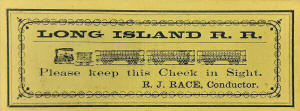 LIRR seat check from Hunterspoint Ave c.1867 |
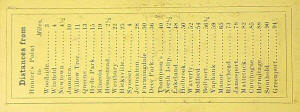 LIRR seat check reverse- Hunterspoint Ave c.1867 |
Conductors had regular runs back then as the Conductor's name is actually printed on this type of form. Also, note the distances are clocked from Hunterspoint Ave. and not the LI. City terminal which is about 6/10ths of a mile west of Hunterspoint Ave. Research: Dave Keller
|
|||||||||
 Seat check - 6/23/1942 |
 Seat check -8/10/1942 |
Seat checks were used by trainmen to indicate that a passenger’s ticket was lifted (or punched). Mostly they were used westbound to Jamaica, but individual trainmen would improvise, as necessary, to keep track of which passengers had paid on eastbounds as well. It seems every trainman had his/her (never saw a female trainman during my days on the line, c.1970-73) method of using them. Brad Phillips Note: the form numbers on the seat checks. Checks with form numbers starting with “AD” meant Accounting Department of the PRR. “ADL” meant the Accounting Department of the LIRR. AD-form seat checks were never used on the LIRR. Brad Phillips 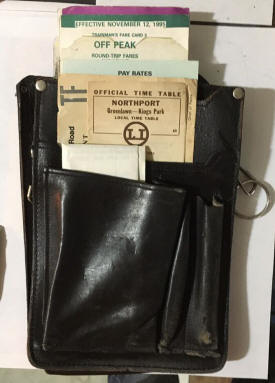 A conductors pouch; the large section is for fare cards, timetables and ticket stock. The small section in front is for seat checks. |
|||||||||
|
|
|||||||||||
|
The yellow ticket form 1-BH is the companion to the
larger form 1H. The smaller tickets were sold at NYP, FBA, Nostrand
Avenue, Jamaica and (strangely) Laurelton. These ticket forms,
printed on Association Ticket Paper (to prevent fraud), were initiated in
the 30’s with the “Pennsylvania Railroad-ization” of the LIRR. I surmise the
smaller format was due to the fact that terminal stations had so many
destinations and there were printed tickets for almost every station. Of
course, Laurelton, East NY, Woodside, etc. were exceptions. The
smaller “Edmondson” size accommodated the multitude of destinations sold
at terminal stations. The ticket cases were huge and a seller really had
to know his stations. Pre-1960 terminal stations had printed tickets to
almost every single station regardless of volume (e.g., Peconic). Both
ticket forms were instituted at the same time (1930’s) with A.H. Shaw
signature. Info: Brad Phillips |
|||||||||||
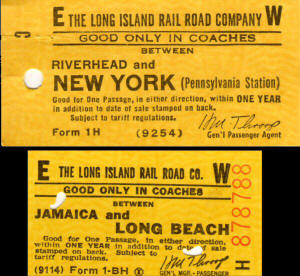 Form 1H and 1-BH ticket size comparison. |
Ticket sizes: The larger form size 1H -
2 ¾” x 1 7/16” The Edmondson railway ticket was a system for recording the payment of railway fares and accounting for the revenue raised and came into general use with the creation of the Railway Clearing House in 1842. Previously, railway companies had used handwritten tickets, as was the practice for stagecoaches, but it was laborious for a ticket clerk to write out a ticket for each passenger and long queues were common at busy stations. A faster means of issuing pre-printed tickets was needed. There was also a need to provide accountability by serial-numbering each ticket to prevent unscrupulous clerks from pocketing the fares, who now had to reconcile the takings against the serial numbers of the unsold tickets at the end of each day. Wiki |
||||||||||
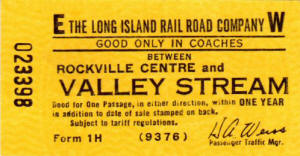 Form 1H ticket Rockville Centre-Valley Stream |
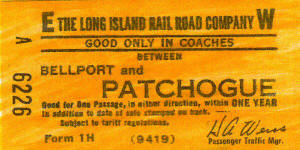 Form 1H ticket Bellport-Patchogue |
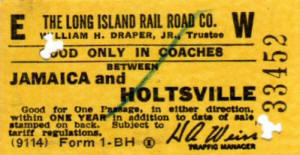 Form 1-BH ticket Jamaica-Holtsville |
|||||||||
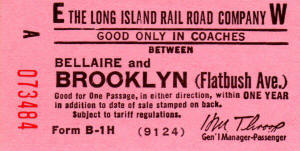 Form B-1H ticket Bellaire-Brooklyn (FBA) |
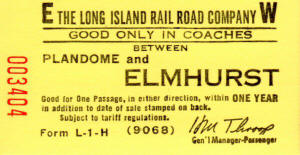 Form L-1-H ticket Plandome-Elmhurst |
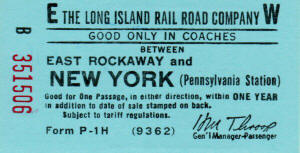 Form P-1H ticket East Rockaway-NY (Penn) |
|||||||||
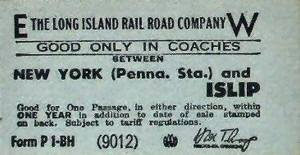 Form P 1-BH blue ticket Penn-Islip |
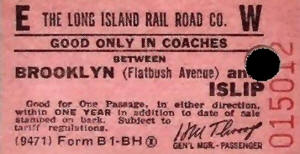 Form B 1-BH red ticket Flatbush-Islip |
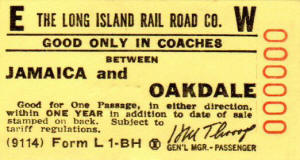 Form L 1-BH Jamaica-Oakdale |
|||||||||
|
In 1966, the railroad started using the blue NY Penn, pink Flatbush Ave, yellow Local scheme for one way tickets (these colors were already being used for commutation tickets). At the same time, they stopped using the expensive Association Ticket Paper and switched to cheap colored card stock. With the new colors for one ways (and printed half fare tickets as well) came a modification to the form numbers as noted above. Prefix P for NY Penn, B for Flatbush Ave, and L for “local”. Note the typefaces are different between NYP and FBA. Rand McNally printed the NYP tickets. International printed the small tickets for everything else. Their logos are printed at the bottom of each ticket. Photos/Archive/Info: Brad Phillips |
|||||||||||
|
|
|||||||||||
| HALF FARE TICKETS | |||||||||||
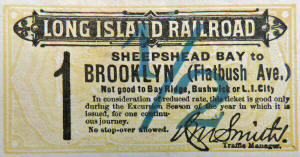 Ticket half fare - Sheepshead Bay-Brooklyn (FBA-Flatbush Ave.) c.1890s
|
 Form LH-362 Half Fare 60 Day Round Trip sample c. 1930's - GPA: A. H. Shaw
Tickets Archive: Brad Phillips, unless noted |
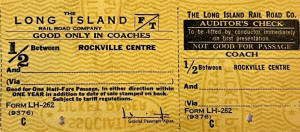 Ticket Half Fare - Form-LH-262 sample 3/02/1942 GPA C. G. Pennington Archive: Jerome Landesman 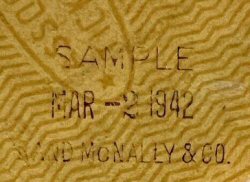 |
|||||||||
|
|
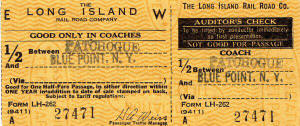 Ticket half fare - Patchogue-Blue Point - Form LH-262 Passenger Traffic Mgr. H. A. Weiss
|
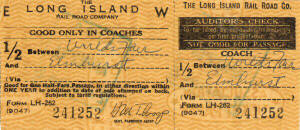 Ticket half fare - World's Fair-Elmhurst - Form LH-262 General Pass. Agent H. M. Throop - c.1964  Ticket half fare - Jamaica-Haberman - Form LH-262 Director Pass. Services H. M. Throop - c.1970 Archive: Richard Ryan |
|||||||||
|
IWhen a printed half fare ticket was not available, the LH-262 form was used. Many stations did not have LH-262 forms, so the LH-261 form was used and marked half fare (above). In the big scheme of things, there were not many half fare tickets issued, particularly for line station to line station vs. NY Penn or Brooklyn FBA. Info: Brad Phillips |
|||||||||||
|
12 and up – full fare From the MTA/LIRR website: Child Fare
(5-11 years old ) I always had to deal with the parents who tried to get
half fare even though it was obvious that the kid was 12 or over. Most
times they got away with it (I couldn’t ask for their birth certificate!),
but if they didn’t know the rule I “got ‘em” when they answered honestly
that the kid was 12 or 13 or whatever. You know how they answered the
next time! Info: Brad Phillips |
|||||||||||
|
|
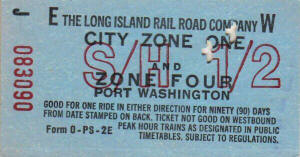 Form O-PS-2E - Senior/Handicapped half fare NY Penn Zone 1 and Zone 4 Manhasset - 5/20/1985 |
These tickets originally began sale during the 1970s labeled E/H for "Elderly-Handicapped"
|
|||||||||
|
|
|||||||||||
| MILITARY FURLOUGH TICKETS | |||||||||||
|
Military tickets are for service folks traveling in uniform and must be in uniform. Railroads allowed employees to keep their position and seniority date per Federal law. Each railroad would issue a rate order upon request from another road. Note: Relatives were allowed the discount as well. |
|||||||||||
|
|
In 1970, while a clerk on military furlough, when stationed at the Navy Supply Corps School in Athens, GA, the half fare/military fare on the L&N Atlanta to Chattanooga is illustrated, for example. In this case, I completed a request form and submitted it to accounting in Jamaica, NY. They then sent it to the requested railroad who then issued the rate order (a serial numbered paper certificate, LEFT), returning it to the LIRR who then sent it to me by mail, as I was stationed in different places during my Navy service. The Half Rate Order is exchanged for a One-Way ticket as well as the certificate on the rear of each ticket. Info: Brad Phillips |
||||||||||
|
|
|||||||||||
| REDUCED RATE | |||||||||||
| Each railroad offered the employee rate to employees of other roads usually half fare, but there could have been other discounts on other roads. Each railroad chose how to label the fare (i.e., half rate, reduced rate, etc.). | |||||||||||
  LIRR Form 204 - Employe Excursion Archive: Brad Phillips |
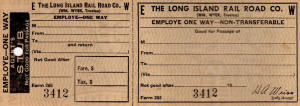 Ticket Form 265 LIRR Employe One Way Archive: Brad Phillips |
 LIRR Form 204 Employee Excursion Ticket Archive: Brad Phillips |
|||||||||
|
|
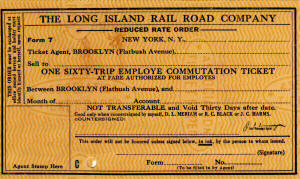 LIRR Reduced Rate Order Form 7 - 60 Trip Employee Commutation Agent issued in Brooklyn GPA: J.F. Finnegan c. 12/01/1948+ Archive: Brad Phillips |
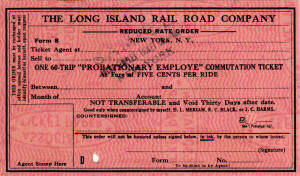 LIRR Reduced Rate Order sample Form 8 - 60 Trip Probationary Employe Commutation Archive: Brad Phillips |
|||||||||
|
This is a LIRR order Form 1 (above) issued based on a request by an employee of the REA (Railway Express Agency). Railroads offered the discounts to employees of affiliated companies. The REA employee requested a trip on the LIRR. The REA then requested the LIRR to issue the order and issued the document to the REA employee. When presented to the agent at Massapequa, he was issued the employee discounted ticket. Orders must be exchanged for the employee ticket and will not be honored on the train. Agent stamp was affixed at the ticket office when the employee ticket was issued. The “cancelled” order was then sent to accounting with the ticket agent stub. Info: Brad Phillip |
|||||||||||
|
|
|||||||||||
| 10 TRIP TICKETS | |||||||||||
|
|
|||||||||||
 10 Trip ticket Form 210-H Penn-Forest Hills
|
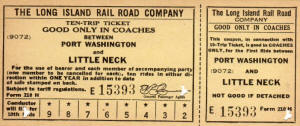 10 Trip ticket Form 210-H Port Washington-Little Neck |
 10 Trip ticket - Form 211-H |
|||||||||
|
Series 2 - In the late 1950’s the
railroad changed the color from yellow to blue. Again, blue for all
regardless of origin and destination stations. The form numbers remained
the same. However, the contract was changed to allow only the bearer to
use the ticket. Accompanying passengers had to buy their own ticket. In
1963 they changed the contract back to allow bearer and accompanying
passengers to use the ticket, probably due to customer complaints.
Archive/Info: Brad Phillips |
|||||||||||
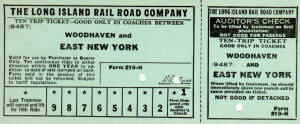 10 Trip ticket Form 210-H Woodhaven-East New York  10 Trip ticket Form 210-H Far Rockaway |
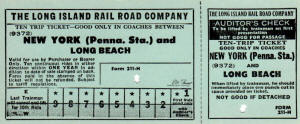 10 Trip ticket Form 211-H Penn-Long Beach
|
 10 Trip ticket - Form 211-H New Hyde Park
Note: All forms with no destination are sample tickets prior to use. Usually rubber stamps were used but handwriting could also be used to indicate paid destination. |
|||||||||
|
Series 3 - Also in 1963, they changed the colors to be consistent with the blue/pink/yellow scheme used system-wide for weekly and monthly tickets. all tickets.
Note: the blue/pink/yellow color scheme originated
with weekly and monthly tickets back in the 50’s. But that’s a story for
another day, as follows: In 1968 (maybe late 67?) the LIRR decided
to discontinue 10 trip tickets. Many commuters from “close-in” stations
(i.e., close to NYP or FBA, e.g., Port Washington branch, stations west of
Valley Stream or Floral Park, etc.) used 10 trips vs. weeklies or
monthlies as the cost was less and the tickets were good for a year vs.
only a week. Discontinuing the 10 trips forced these folks to use
weeklies or monthlies. A HUGE furor arose due to this action. I don’t
believe there was any community input solicited. They just did it. |
|||||||||||
|
Series 4 - In 1970 the railroad relented and brought the 10 trips back. The only changes from Series 3 are the font and layout. I have no idea why they made only a cosmetic change. Archive/Info: Brad Phillips |
|||||||||||
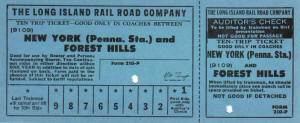 10 Trip ticket Form 210-P Penn-Forest-Hills |
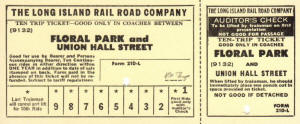 10 Trip ticket Form 210-L Floral Park-Union Hall St. |
 10 Trip ticket Form 210-B Brooklyn |
|||||||||
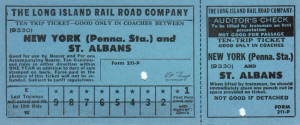 10 Trip ticket Form 211-P Penn-St. Albans |
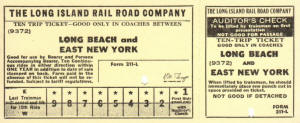 10 Trip ticket Form 211-L Long Beach-East NY |
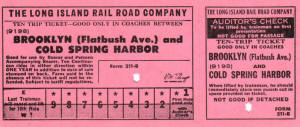 10 Trip ticket Form 211-B Brooklyn-Cold Spring Harbor |
|||||||||
|
Additional Font and Layout Modifications Archive/Info: Brad Phillips |
|||||||||||
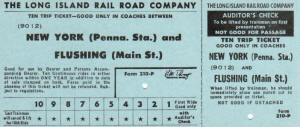 10 Trip ticket Form 210-P Penn-Flushing (Main St.) |
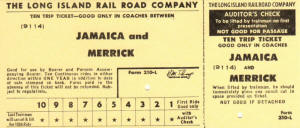 10 Trip ticket Form 210-L Jamaica-Merrick |
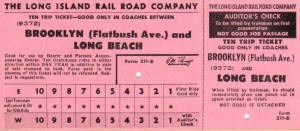 10 Trip ticket Form 211-B Brooklyn-Long Beach |
|||||||||
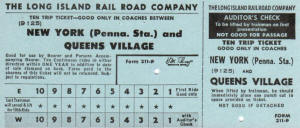 10 Trip ticket Form 211-P Penn-Queens Village
|
 10 Trip ticket Form 211-L Baldwin Refunds were (1970)
calculated as follows: |
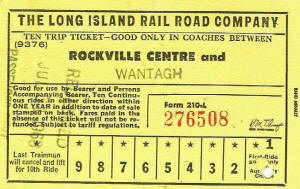 10 Trip ticket Form 210-L Rockville Centre-Wantagh Refund 7/01/1968 |
|||||||||
|
From my research 10 trip tickets were eliminated with the January 29, 1972 fare increase - and then brought back - 10 ride off peak - April 1, 1990. The price was the equivalent of 9 off peak one way tickets and was at first not transferable - I believe a change to make them useable for more than one rider was made with the 2003 fare increase. Info: Mike McEnaney |
|||||||||||
|
|
|||||||||||
| WEEKLY TICKETS - PRR ERA | |||||||||||
 |
|||||||||||
 Ticket Weekly 12 trip Form 312 - Brooklyn and Amityville GPA A. H. Shaw - 11/05/1933 |
 Ticket Weekly 12 trip Form 412 - New York and World's Fair 3/11/1939 - GPA Shaw All tickets and research Brad Phillips, unless noted.
|
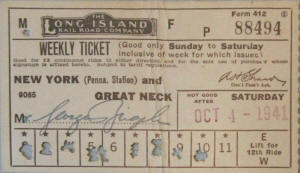 Ticket Weekly 12 trip Form 412 - NY Penn and Great Neck - GPA A. H. Shaw - 9/27/1941 |
|||||||||
|
|
 Ticket Weekly 12 trip Form 412 - NY Penn and Little Neck GPA C. G. Pennington - 11/22/1941 |
 Ticket Weekly 12 trip Form 412 - NY Penn and Great Neck - GPA Homer Bannard - 8/21/1948 |
|||||||||
|
|
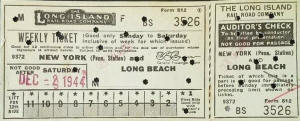 Ticket Weekly 12 trip Form 512 - NY Penn to Long Beach GPA E. R. Comer - 11/28/1943 |
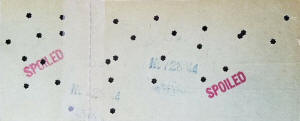 SPOILED means the ticket was issued in error and the agent “spoiled” or voided it. The voided ticket is then sent back to Jamaica accounting along with the monthly ticket sales reports. When I voided a ticket (which was rare), I just wrote “VOID” on the front and back! Brad Phillips |
|||||||||
 Ticket Weekly 12 trip Form 512 - New York and Center Avenue GPA A. H. Shaw Note: " Expire Date Field location position |
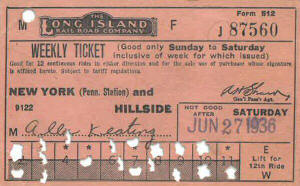 Ticket Weekly 12 trip Form 512 - New York and Hillside GPA A. H. Shaw - 6/27/1936 |
 Ticket Weekly 12 trip Form 512 - New York and Rockville Centre - GPA C. G. Pennington - 7/15/1944 |
|||||||||
 Ticket Weekly 12 trip Form 612 Brooklyn and Seaside GPA Comer |
 Ticket Weekly 12 trip Form 612 New York and Malverne GPA Bannard - 2/19/1949 |
 Ticket Weekly 12 trip Form 612 New York and Arverne GPA Shaw - 8/30/1941 |
|||||||||
 Ticket Weekly 12 trip Form 612 sample Brooklyn and blank GPA Shaw |
 Ticket Weekly 12 trip Form 612 sample New York and blank GPA Comer |
 Ticket Weekly 12 trip Form 612 New York and Long Beach GPA Comer - 12/02/1944 Source: eBay |
|||||||||
 Ticket Weekly 12 trip Form 712 - Brooklyn and Medford GPA A. H. Shaw - 10/27/1934  Ticket Weekly 12 trip Form 712 - Brooklyn and Riverhead GPA A. H. Shaw - 9/17/1938 |
 Ticket Weekly 12 trip Form 712 - Brooklyn (FBA) and Center Avenue 8/29/1942 GPA C. G. Pennington |
 Ticket Weekly 12 trip Form 712 - Brooklyn and Lynbrook GPA J. P. Finnegan - 7/16/1949 |
|||||||||
 Ticket Weekly 12 trip Form 712 - Brooklyn and Center Avenue GPA Pennington - 8/29/1942 |
 Ticket Weekly 12 trip Form 712 - Brooklyn and Rockville Centre GPA Comer - 1/12/1946 |
 Ticket Weekly 12 trip Form 712 sample - Brooklyn and Springfield Gardens GPA Comer |
|||||||||
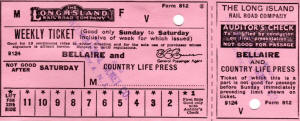 Ticket Weekly 12 trip Form 812 - Bellaire to Country Life Press GPA E. R. Comer - c.1943 |
 Ticket Weekly 12 trip Form 812 blank sample GPA Comer |
 Ticket Weekly 12 trip Form 812 sample Jamaica and Hempstead GPA Pennington |
|||||||||
 Ticket Weekly 12 trip Form 812 -Jamaica and Republic GPA Homer Bannard - 12/27/1947 |
 Ticket Weekly Form 912 sample Forest Hills and blank |
 Ticket Weekly Form 912 Woodside and Long Beach 12 trip - GPA E. R. Comer 5/21/1949 |
|||||||||
| Weekly 12 trip TICKET COUPON BOOKLETS | |||||||||||
 Ticket Weekly 12 trip Form 516 C - New York and Malvern 6/1948 GPA Homer Bannard  |
 |
 Ticket Weekly 12 trip Form 516 C - New York and Rockville Centre 10/1948 GPA Homer Bannard
|
|||||||||
|
These booklets were used for a very short time, apparently in 1948 between the PRR style and the implementation of the photo ID style. The only signature I have on these books is Bannard (see above) and the photo style tickets have Eckfeldt and Weiss, the successor GPA’s. The next generation of weeklies were the punch type WP, WB and WL series which lasted (with variations) until the flash tickets came along in 1968. As these books were in use for just a short time, different size books were used, perhaps as experiments. The small book form number appears to follow on from my chart of the PRR style tickets. The large book starts a new form series and the coupon 713 C, above, has even a different series. Brad Phillips |
|||||||||||
|
|
|||||||||||
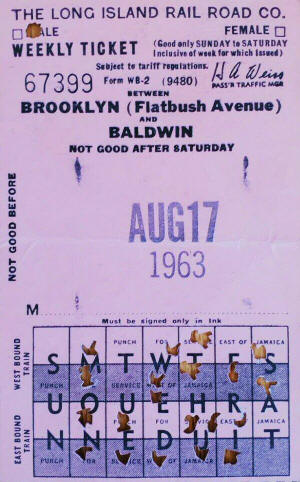 Weekly Ticket Form WB-2 - FBA and Baldwin - 8/17/1963 |
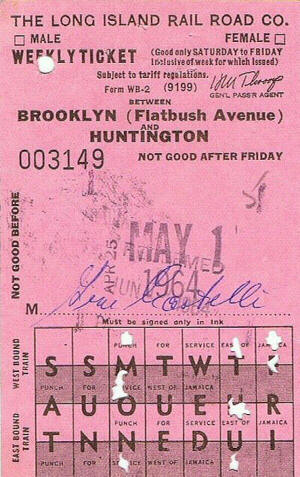 Weekly Ticket Form WB-2 - FBA and Huntington - 5/01/1964 |
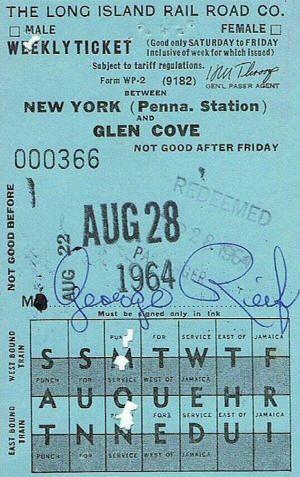 Weekly Ticket Form WP-2 with selling agent "L punch" NY Penn and Glen Cove 8/28/1964 |
|||||||||
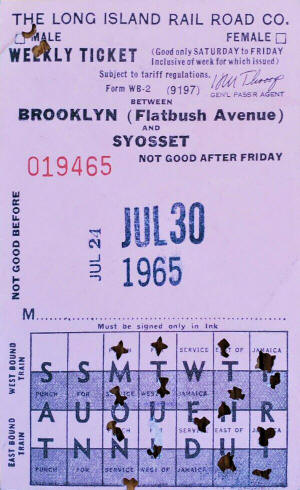 Weekly Ticket Form WB-2 FBA and Syosset - 7/30/1965 |
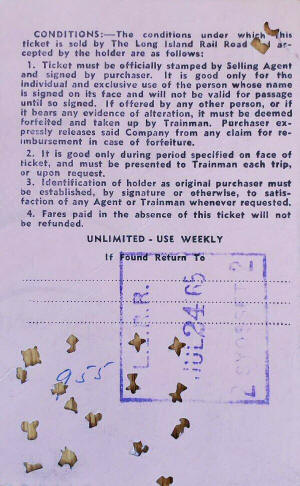 Weekly Ticket Form WB-2 back FBA and Syosset - 7/30/1965 |
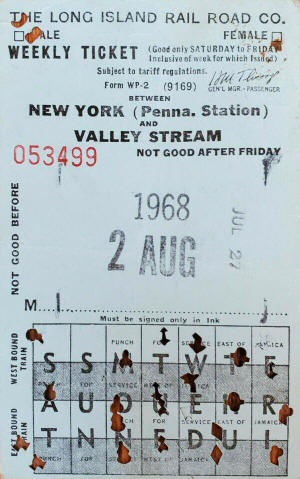 Weekly Ticket Form WP-2 NY Penn and Valley Stream 8/02/1968 |
|||||||||
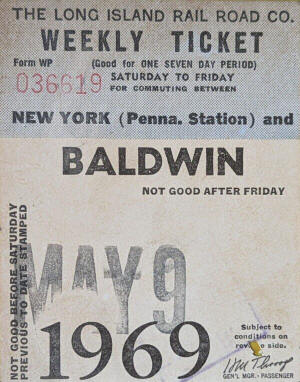 Weekly Ticket Form WP NY Penn and Baldwin 5/09/1969 |
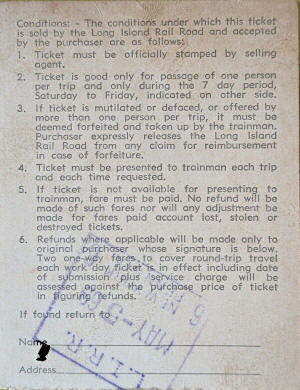 Weekly Ticket Form WP back NY Penn and Baldwin 5/09/1969 |
 Weekly Ticket Form WPL-2 - 5/1971 |
|||||||||
|
Form WP-2 means weekly from NY Penn. Form WB-2 means weekly, FBA (Flatbush Avenue or Brooklyn), through Jamaica (2 punch blocks per trip, one for east and the other for west of Jamaica). Pink was always FBA. Nostrand Avenue, for example, would have a yellow form. |
|||||||||||
|
|
|||||||||||
| MONTHLY COMMUTATION TICKETS | |||||||||||
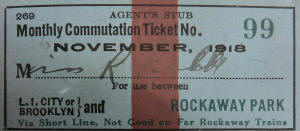 Form 269 Monthly Ticket Agents Stub - LI City or Brooklyn and Rockaway Park 11/1918
|
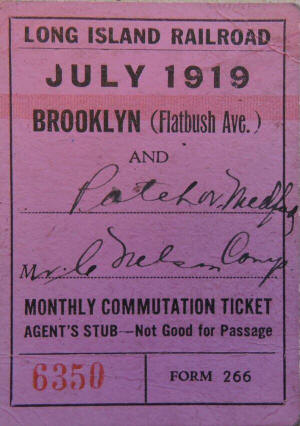 Form 266 Monthly Ticket Agents Stub - Brooklyn (FBA) and Patchogue 7/07/1919 |
 60 Ride Commutation Ticket Hempstead and LI City or Brooklyn 1898 Archive: Brad Phillips
|
|||||||||
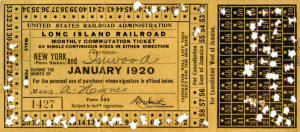 USRA Form 263 Monthly - NY and Inwood 1/1920 Archive: Brad Phillips |
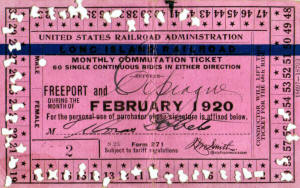 USRA Form 271 Monthly - Freeport and Copiague 2/1920 Archive: Brad Phillips |
||||||||||
 Form 263 Monthly color change Commuter 1926 - NY Penn to Central Park or Seaford General Passenger Agent (GPA) P.H. Woodward Archive: Brad Phillips |
|||||||||||
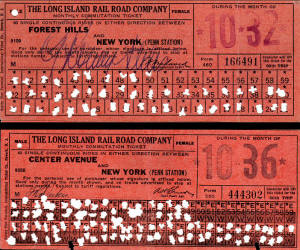 Monthly Form 460 single punch Forest Hills and NY Penn 10/1932 Form 560 double punch - Center Avenue and NY Penn thru Jamaica 10/1936 Archive: Brad Phillips
|
|
||||||||||
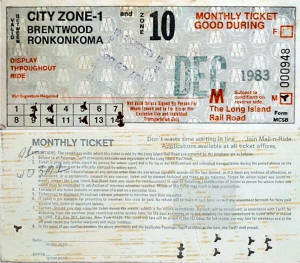 Form MCSB City Zone1 to Zone10 12/1983 |
|||||||||||
|
|
|||||||||||
| MONTHLY AND A HALF COMMUTATION TICKETS | |||||||||||
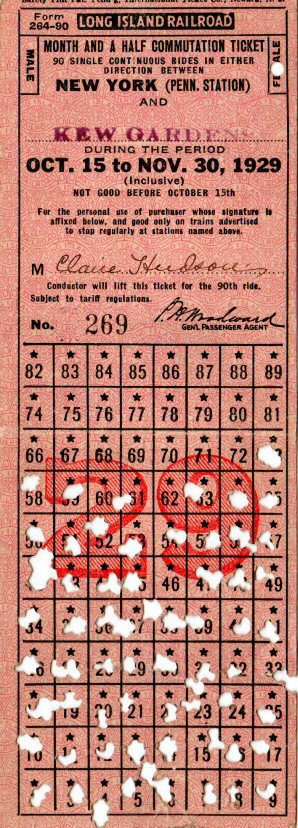 |
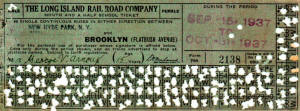 Form 769 School - Month And A Half New Hyde Park and Brooklyn 9/15/1937 Archive: Brad Phillips
Form 264-90 Month And A Half |
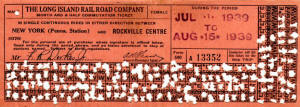 Form 590 Month And A Half NY Penn and Rockville Centre 8/01/1939 Archive: Brad Phillips |
|||||||||
|
|
|||||||||||
| STRIPED TICKETS | |||||||||||
|
Preceding the implementation of PRR style tickets (early 1930’s), Round Trip Tickets had a single stripe on the going portion and a double stripe on the return (see below). It didn’t matter what the origin or destination was. One way tickets had no stripe. Commutation Tickets were a little more complex. 10 Trip and Weekly Tickets did not have stripes. (Footnote: while I have examples of pre-PRR 10-trips, I’ve never seen any weekly tickets from that era. Perhaps weeklies only came about through the PRR influence.) As for Monthly Tickets: In the pre-PRR era, it seems that only Brooklyn tickets had the red stripe (below left) and New York tickets had none. But, it looks like tickets between intermediate stations had a blue stripe (below center). I can only guess that the colored stripes made it easier for trainmen to identify destination. When the PRR style tickets came into being, colors were all over the place (I have green, white, orange and yellow). I haven’t taken the time to lay out the date sequence (I have many examples), but no stripes were used. (See section below) |
|||||||||||
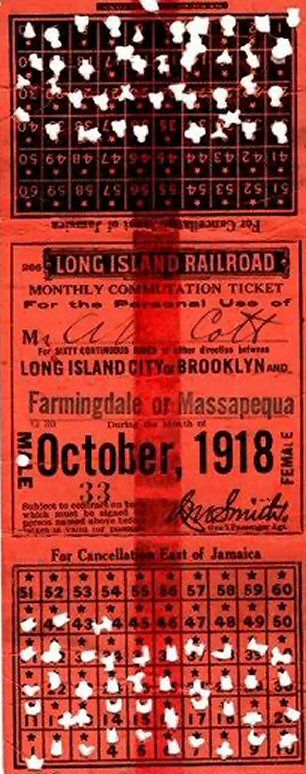 Monthly single stripe - LI City or Brooklyn to Farmingdale or Massapequa 10/1918 Archive: Brad Phillips |
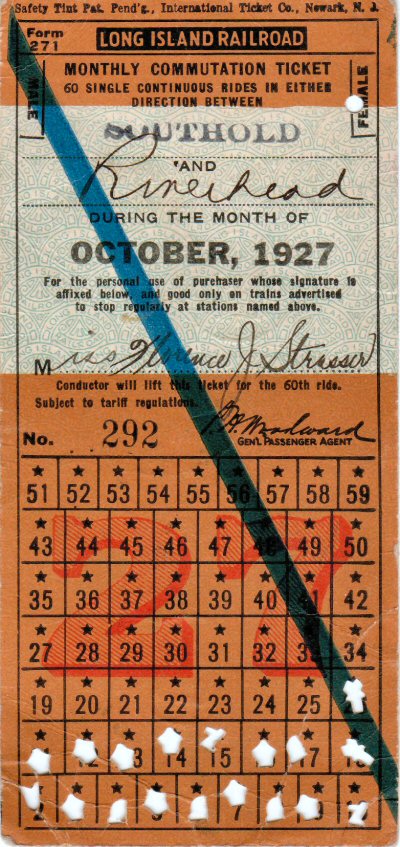 Monthly Form 271 Southold to Riverhead 10/1927 Archive: Brad Phillips |
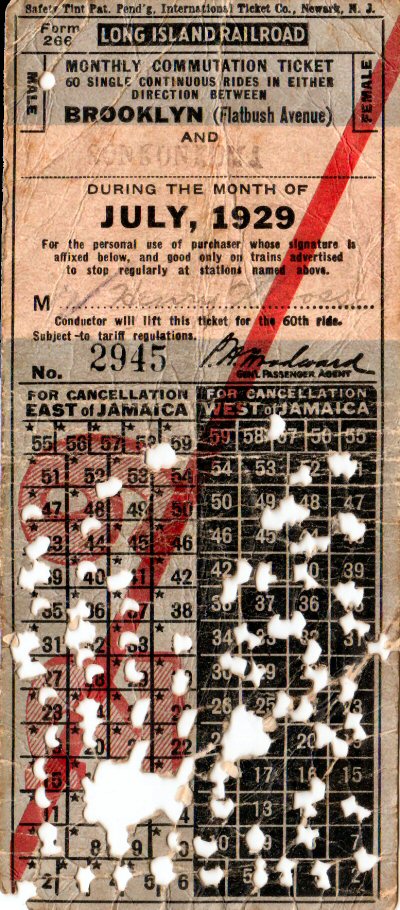 Monthly Form 266 Brooklyn to Ronkonkoma 7/1929 Archive: Brad Phillips |
|||||||||
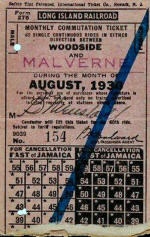 Form 275 - Monthly Woodside and Malverne August, 1930 utilizing GPS P.H. Woodward remaining stock Archive: Brad Phillips |
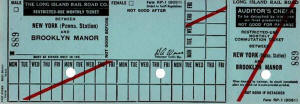 Form RP-1 Monthly Red single stripe NY Penn to Brooklyn Manor  Form RP-4 Monthly Red double stripe NY Penn to open |
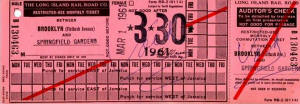 Form RB-2 Monthly - Red single stripe Brooklyn to Springfield Gardens 3/01/1961
Archive: Brad Phillips |
|||||||||
|
|
|||||||||||
| COUPON BOOKLETS | |||||||||||
|
In 1948, coupon booklets were used (a possible experiment?). There were 2 sizes and the colors were NY-Blue, Form 516-C 12 Trip weekly, and Brooklyn-White, Form 760-C 60 Trip Monthly. There were also booklets for the Penn Station supplemental tickets Form L-593-C. Brad Phillips |
|||||||||||
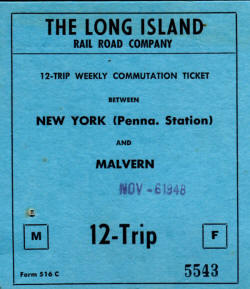 Form 516-C - 12 Trip Weekly NY Penn and Malvern 11/06/1948 |
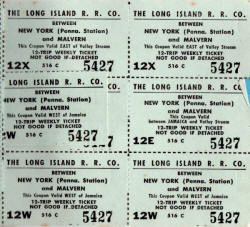 Form 516-C - 12 Trip Weekly Coupons NY Penn and Malvern |
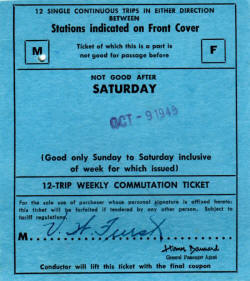 Form 516-C - 12 Trip Weekly back cover 10/09/1948 |
|||||||||
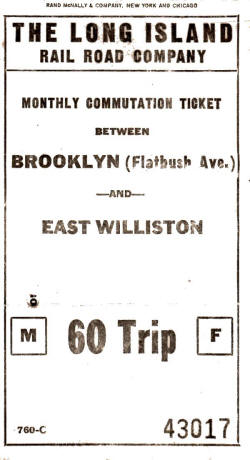 Form 760-C - 60 Trip Monthly between Brooklyn and East Williston |
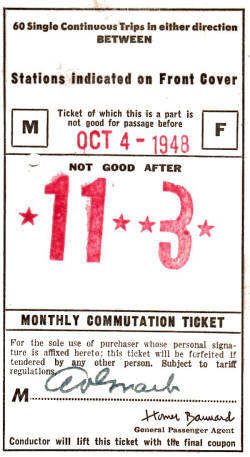 Form 760-C - 60 Trip Monthly back cover between Brooklyn and East Williston back cover 10/04/1948
|
Archive: Brad Phillips |
|||||||||
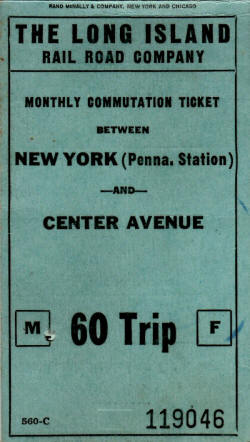 Form 560-C - 60 Trip Monthly cover between NY Penn and Center Ave. back cover 10/04/1948 |
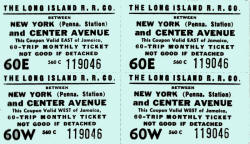 Form 560-C - 60 Trip Monthly Coupons between NY Penn and Center Ave. |
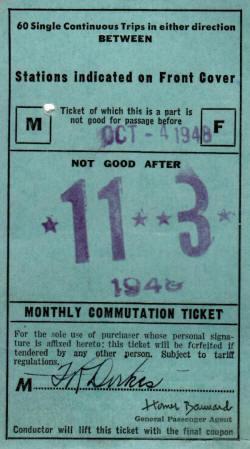 Form 560-C - 60 Trip Monthly back cover between NY Penn and Center Ave. back cover 10/04/1948 |
|||||||||
|
|
|||||||||||
| supplemental TICKETS | |||||||||||
|
For commuters using commutation tickets (only), the LIRR sold 10 trip (Form L-593) and 20 trip (Form L-594) supplemental tickets so cash would not need to be collected on board trains. The 20 trip ticket was eliminated at some point early on, leaving just the 10 trip version which was still in use when I left the LIRR in 1973. These tickets were given the title “Penn Station Supplemental Tickets.” They sold for $1.50, 15 cents per trip with no discount. |
|||||||||||
 Form L-593 10 Trip Supplemental Fare - GPA: Bannard |
 Form L-593 10 Trip Supplemental Fare - GPA: Weiss |
 Form-L-594 20 Trip Supplemental Fare - GPA: Shaw |
|||||||||
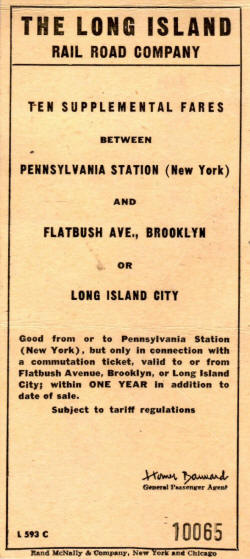 Form L 593 C - Ten Trip Supplemental Fares - NY-Penn and Brooklyn or LI City 10/02/1948 - GPA: Bannard |
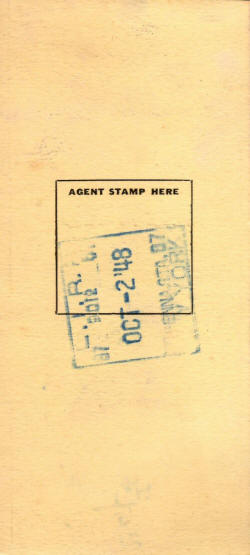 Form L 593 C - Ten Trip Supplemental Fares back cover NY Penn and Brooklyn or LI City 10/02/1948 |
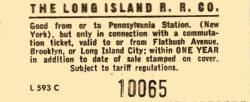 Form L 593 C - Ten Trip Supplemental Fares Coupon 10/02/1948 - GPA: Bannard
Archive: Brad Phillips
|
|||||||||
|
|
|||||||||||
|
|
|||||||||||
| PHOTO TICKETS | |||||||||||
|
The coupon booklets were phased out (?) in 1949 based on the examples
I have, and the Photo Identification Cards
with stick-on tickets came into use for both weekly and monthly
tickets. Three colors were used for the stick-on tickets (NY-Blue,
Brooklyn-Gray later changed to Pink, Local-Yellow) and stripes were
used as follows: |
|||||||||||
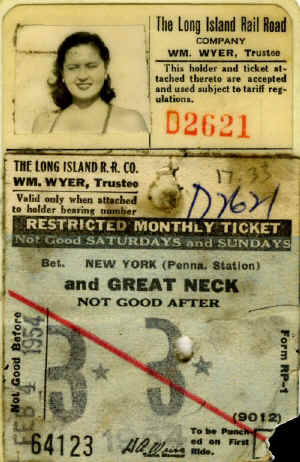 Restricted Monthly photo ticket - Form RP-1 between NY Penn and Great Neck 2/1954 Archive: Dave Morrison 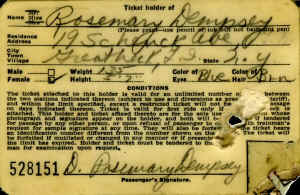
WB = Weekly - Brooklyn |
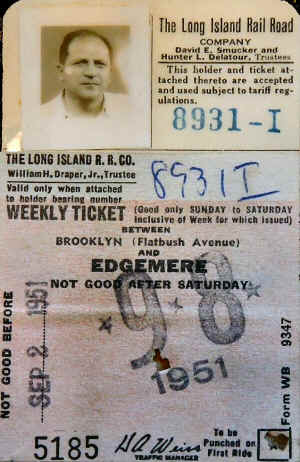 Weekly Photo ticket - Form WB between Brooklyn and Edgemere 9/1951
|
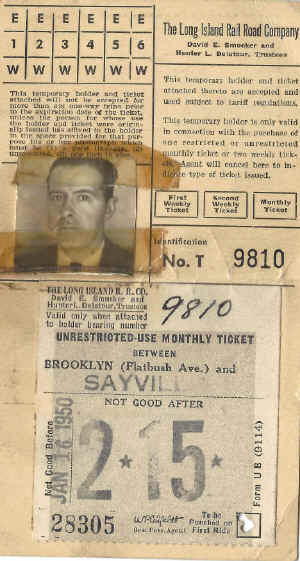
Restricted Monthly photo ticket - Form UB between Brooklyn and Sayville 1/1950
|
|||||||||
|
The standard monthly photo commute ticket of that era was a plastic card with your photo attached (see
above right - Form UB = Unrestricted Monthly Brooklyn). You would
purchase the sticker each month, the agent would peel off the old one and stick on the new noting the card ID number on the sticker to prevent fraud.
In this case #9810. The same card used for weeklies and monthlies. This particular paper ticket backer was issued for temporary use while the permanent plastic card was being made for you.
Note: (9114) is the Jamaica station number as indicated in the Station
Numbers section previously. All unique-to-a-station tickets had the station number printed. My home, Amityville, was 9389. Even some open form tickets were printed with the station number that ordered them.
Info: Brad Phillips |
|||||||||||
|
|
|||||||||||
| MONTHLY COMMUTATION TICKETS - FLASH TYPE | |||||||||||
|
1.
The commuter received the ticket with auditor’s check
attached. The first trainman honoring the ticket removed the auditor's
check and turned it in with other ticket collections to the ticket
receiver. I have no idea exactly what the Accounting Dept. did with
them. The Flash tickets came before mail orders. Of interest, the
follow-on versions went back to being punch-type. Too much abuse,
perhaps. Brad Phillips |
|||||||||||
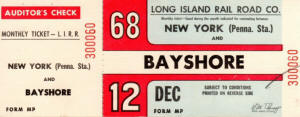 Form MP - PENN-Bay Shore with Auditor's Check 12/1968 Archive: Brad Phillips |
 Form MPL - PENN with blank destination - Agent's Stub and Auditor's Check 12/1968 Archive: Brad Phillips |
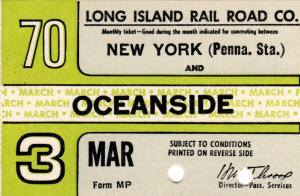 Form MP - PENN-Oceanside 3/1970 Archive: Brad Phillips |
|||||||||
|
|
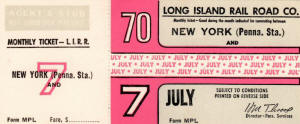 Form MPL - PENN with blank destination - Agent's Stub 7/1970 Archive: Brad Phillips MPL and MBL with blank destinations used as it was too expensive to have printed tickets (Form MB) to every station. E.g., not many sold from Speonk or Southampton. |
||||||||||
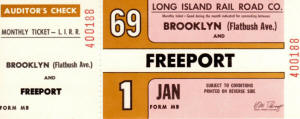 Form MB - Brooklyn-Freeport with Auditor's Check 1/1969 Archive: Brad Phillips |
 Form MBL - Brooklyn with blank destination - Agent's Stub and Auditor's Check 6/1969 Archive: Brad Phillips |
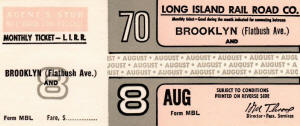 Form MBL - Brooklyn with blank destination - Agent's Stub 8/1970 Archive: Brad Phillips |
|||||||||
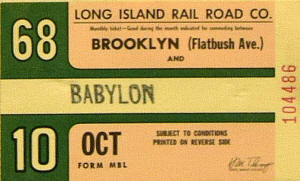 Form MBL - Brooklyn with destination stamped Babylon 10/1968 |
 Form MB - Brooklyn-Lynbrook 11/1968 |
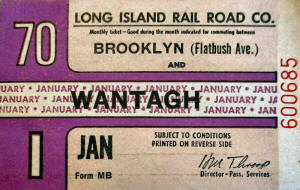 Form MB - Brooklyn-Wantagh 1/1970 |
|||||||||
 Form MLL - Blank with Agent's Stub and Auditor's Check 5/1969 Archive: Brad Phillips |
Form MLL used for other than NY Penn or Brooklyn Flatbush Ave. E.g., a monthly from Amityville to Jamaica or Woodside was too expensive to print fixed origins or destinations due to volume. |
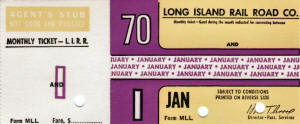 Form MLL - Blank with Agent's Stub 1/1970 Archive: Brad Phillips |
|||||||||
|
With the January 29, 1972 fare increase the LIRR
introduced new Weekly and Monthly tickets that limited their use to one
round trip per day replacing the "flash" type tickets allowing unlimited
use that were subjects of fare abuse. Weekly tickets were valid for
14 rides and Monthly tickets for 62 rides (31 day month) maximum - which
were used until October 1980. |
|||||||||||
|
|
|||||||||||
| MONTHLY COMMUTATION ZONE FARE TICKETS - PUNCH AND MAIL-N-RIDE | |||||||||||
| Examples of punch style tickets sold at stations and punch-type ticket sold by mail (MNR = mail-n-ride). Most of the time, the conductor would just get the flash, but periodically they would ask for the ticket and punch one of the blocks. I have no idea why they started this specific procedure or the criteria were for ticket punching vs. flashing. Older versions identified male or female and were restricted to a single individual use. | |||||||||||
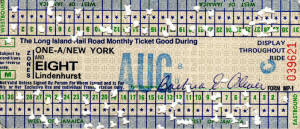 Form MP-1 Monthly PENN Zone 1 to Lindenhurst Zone 8 8/1980 Photo/Archive: Brad Phillips |
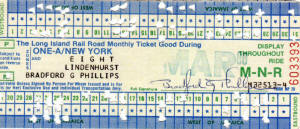 Form MP20 Monthly PENN Zone 1 to Lindenhurst Zone 8 3/1980 Photo/Archive: Brad Phillips |
|
|||||||||
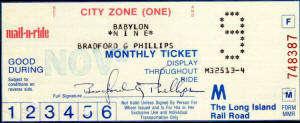 Form MMR Monthly mail-n-ride PENN Zone 1 to Babylon Zone 9 11/1980 Photo/Archive: Brad Phillips |
Redesigned monthly "Display" tickets. |
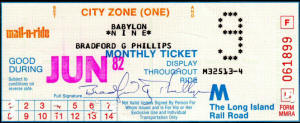 Form MMRA Monthly mail-n-ride PENN Zone 1 to Babylon Zone 9 6/1982 Photo/Archive: Brad Phillips |
|||||||||
|
|
|||||||||||
| FARE TARIFF LISTS | |||||||||||
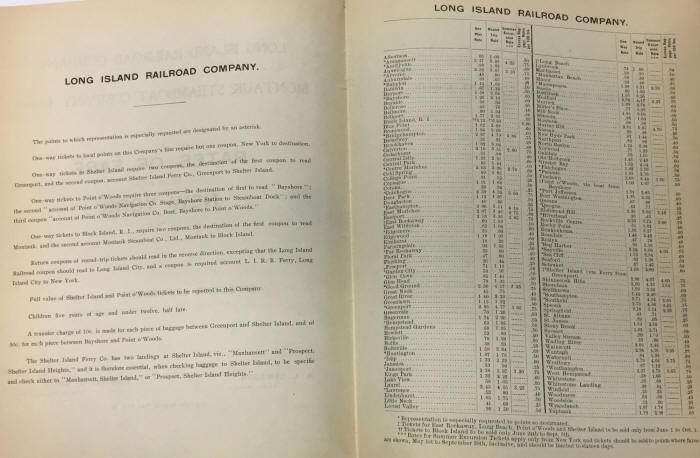 LIRR Fares 8/01/1897 - LIRR Traffic Manager H. M. Smith Archive: RMLI |
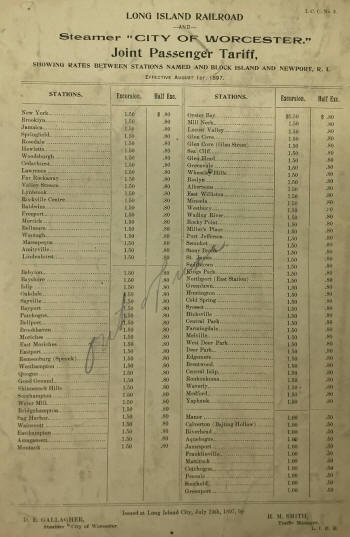 Joint Passenger Tariff LIRR and Steamer "City of Worcester" 8/01/1897 Archive: RMLI |
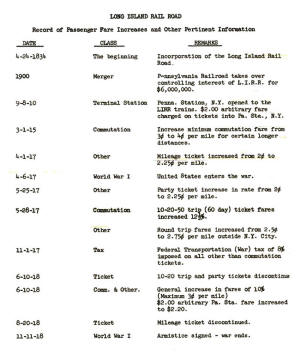 Passenger Fare Increases and Significant Date Events Archive: Brad Phillips |
|||||||||
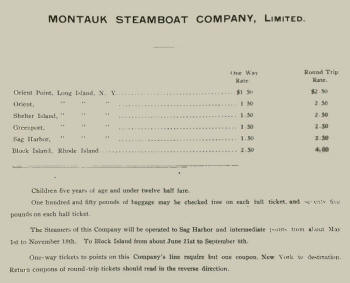 Montauk Steamboat Company, Ltd. - One Way and Round Trip rates Steamer "City of Worcester" - 8/01/1897 Archive: RMLI |
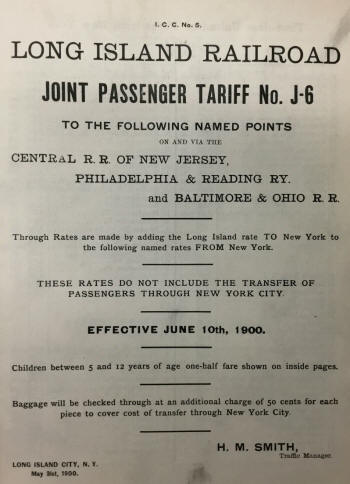 LIRR Joint Passenger Tariff No. J-6 - 6/10/1900 Archive: RMLI |
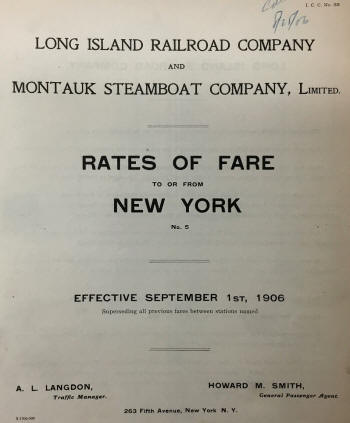 LIRR Rates of Fare no.5 To or From New York Montauk Steamboat Company, Ltd. 9/01/1906 Archive: RMLI |
|||||||||
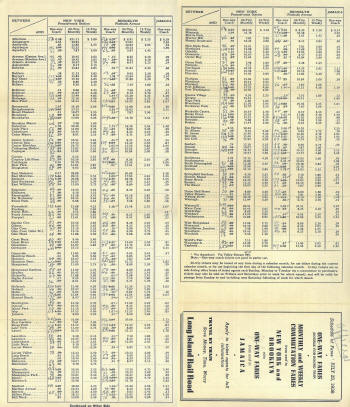 Fares NY Penn - Brooklyn - Jamaica - 7/25/1938 |
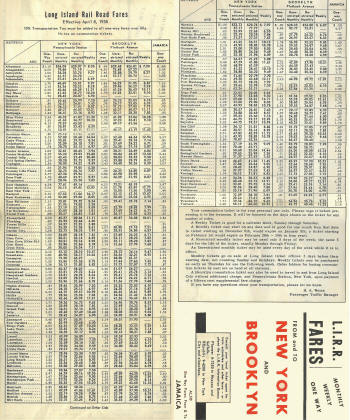 Fares NY Penn - Brooklyn - Jamaica - 4/08/1958 |
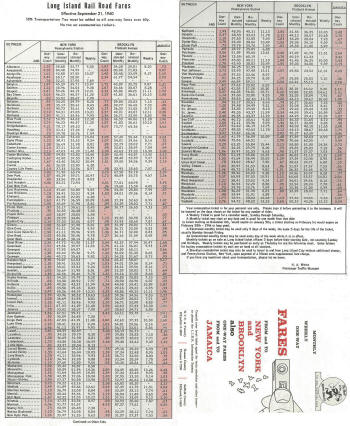 Fares NY Penn - Brooklyn - Jamaica - 9/21/1960 |
|||||||||
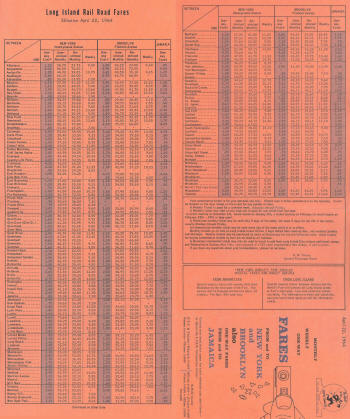 Fares NY Penn - Brooklyn - Jamaica - 4/221964 |
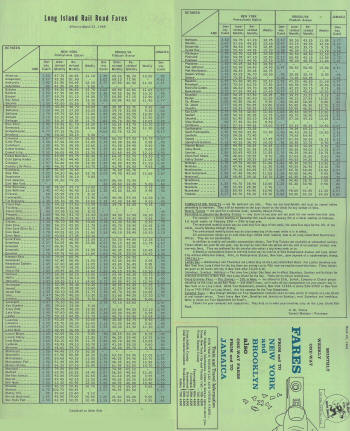 Fares NY Penn - Brooklyn - Jamaica - 3/22/1968 |
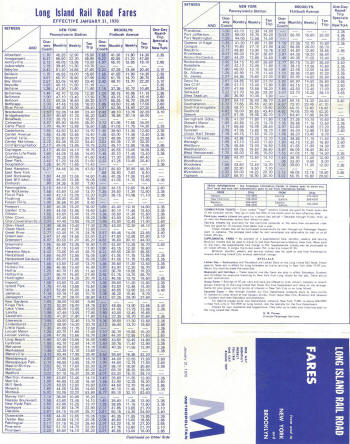 Fares NY Penn - Brooklyn - Jamaica - 1/31/1970 |
|||||||||
| Fare Lists - Archive: Brad Phillips | |||||||||||
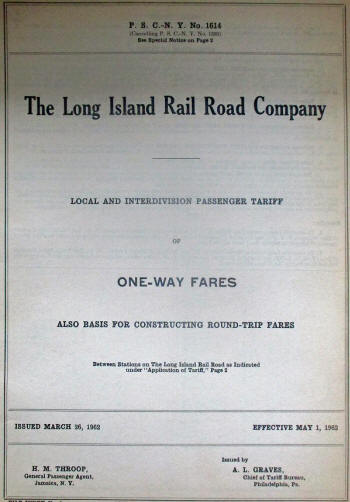 One-Way Fares Tariff listing - Eff. 5/01/1962 Archive: Dave Morrison |
They were available on request to the ticket seller,
not left out in timetable racks, etc.
Usually, when a Trainmen had a set of “fare cards” which provided
fares between all stations on the railroad. There was a
|
||||||||||
|
|
|||||||||||
| FARE CARDS | |||||||||||

|
 |
 |
|||||||||
 |
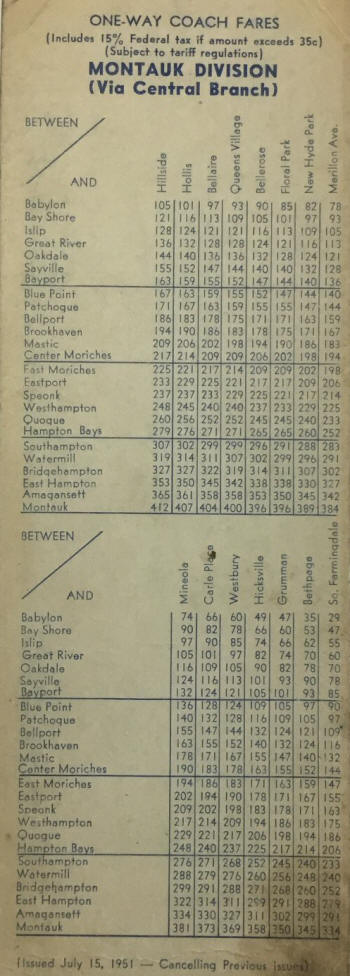
Trainman's Fare Cards |
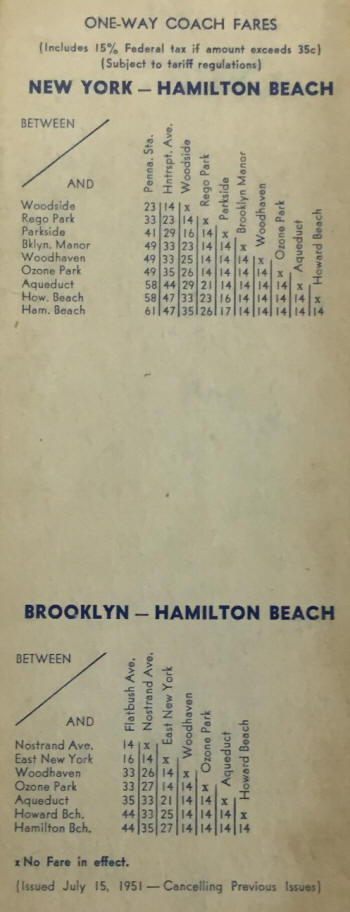 |
|||||||||
|
|
|||||||||||
 |
 Trainman's Fare Cards 9/21/1960 Archive: Railroad Museum of Long Island Note: Includes 10% Federal tax if amount exceeds 35¢ |
 |
|||||||||
|
|
|||||||||||
 One-Way Coach Fares - Babylon Branch 1/31/1970 Archive: RMLI |
 One-Way Coach Fares - Hempstead/West Hempstead Branches 1/31/1970 Archive: RMLI Note: Federal tax eliminated in the 1960's |
 One Way Coach Fares - Hempstead/West Hempstead Branches 9/21/1960 Archive: RMLI |
|||||||||
 |
 |
The fare cards were sized 3.25" x 10.5". |
|||||||||
| Trainmen's Fare Card 1/29/1972 - The 15 LIRR fare zones were first introduced January 29, 1972 (See below) Archive: RMLI | |||||||||||
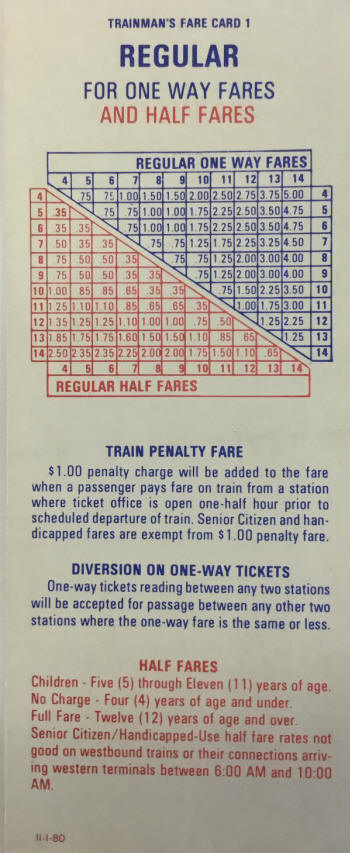 One Way and Half Fares - Trainman's Fare Card 1 11/01/1980 Archive: RMLI Note: Fare Zone Consolidation occurred as of July 1, 1980 (See below) |
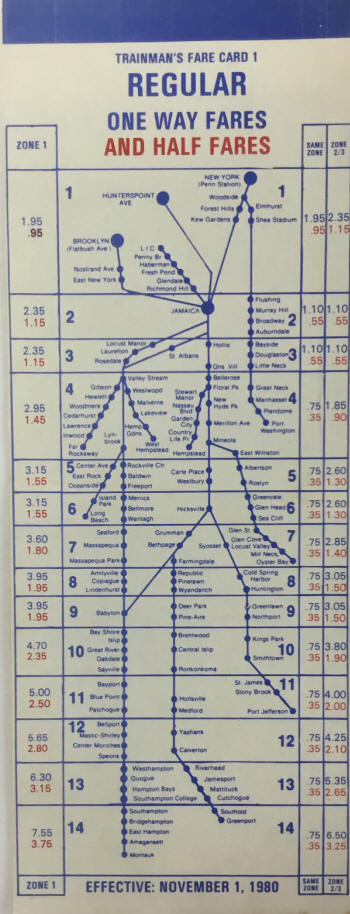 |
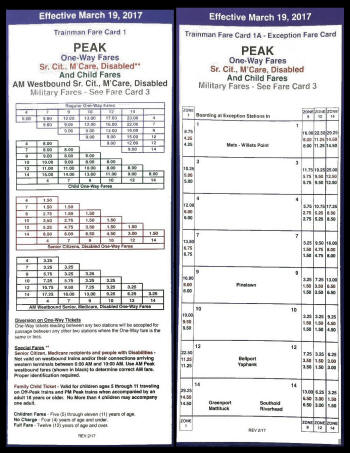 Trainman Fare Cards - Rate Increase - 3/19/2017 Archive: Derek Stadler RMLI |
|||||||||
|
|
|||||||||||
| ZONE FARE CHARTS | |||||||||||
|
The 15 LIRR fare zones were first introduced January 29, 1972 (left). With the January 29, 1972 fare increase the LIRR introduced new Weekly and Monthly tickets that limited their use to one round trip per day replacing the "flash" type tickets allowing unlimited use that were subjects of fare abuse. Weekly tickets were valid for 14 rides and Monthly tickets for 62 rides (31 day month) maximum - which were used until October 1980. From my research 10 trip tickets were eliminated with the
January 29, 1972 fare increase - and then brought back - 10 ride off peak
- April 1, 1990. The price was the equivalent of 9 off peak one way
tickets and was at first not transferable - I believe a change to make
them useable for more than one rider was made with the 2003 fare increase. The November 1980 Monthly Mail N' Ride
ticket (above) was a first issue and a good example of redesigned
"Display" tickets. |
|||||||||||
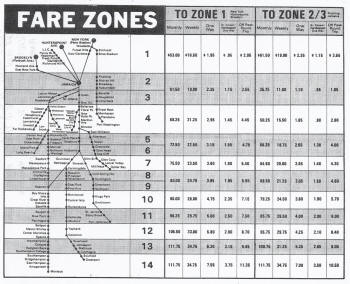 Fare Zone Consolidations July 1, 1980 Zone 1A (NYK/WDD/FHL/KGN/EH2/SSM) and zone 1B (ATL/NAV/ENY/VHW/LIC/HPA/PBG/HBM/FPD/GDL/RHL)
were combined into zone 1 sometime earlier, probably around 1970. OFF-Peak Round Trip Tickets begin with tickets valid from 30 days to 90 days. Penalty fare of $1.00 begins August 1, 1980 Research: Mike McEnaney
|
|||||||||||
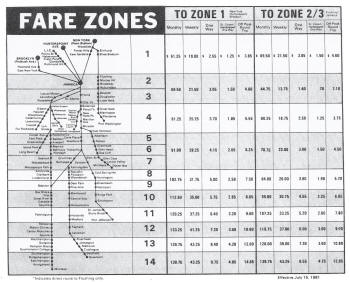 |
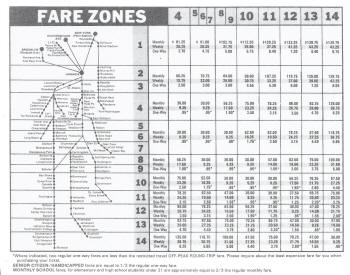 |
Fare Zone Consolidation - Zones 5-7 July 15, 1981 |
|||||||||
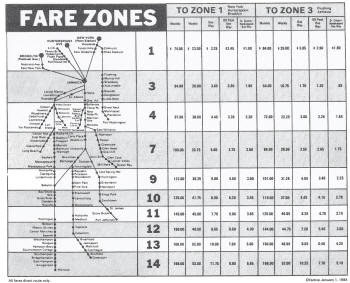 |
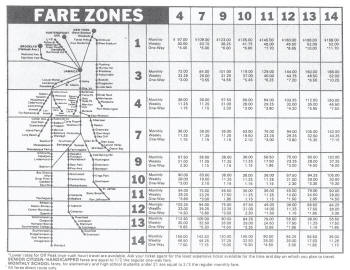 |
Fare Zones One Way Tickets return valid for 90 days from date of sale. January 1, 1984 |
|||||||||
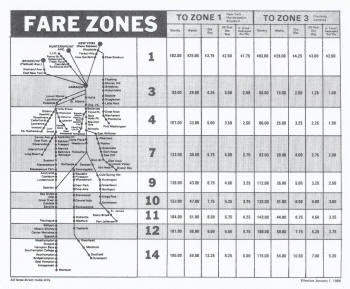 Fare Zones Lower rates for Off Peak (non-rush hour) available. January 1, 1986 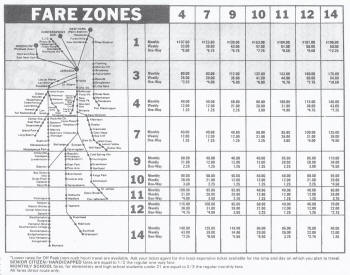 |
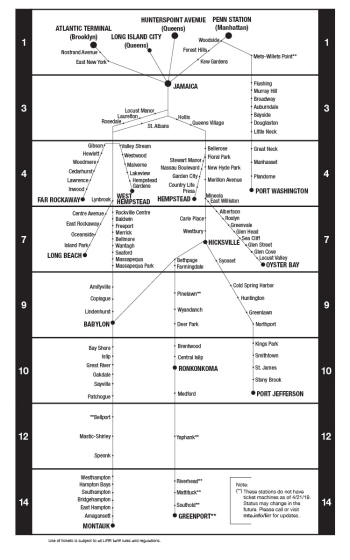 Fare Zone Chart 2019 with no Zone changes from 5/01/2003 |
|
|||||||||
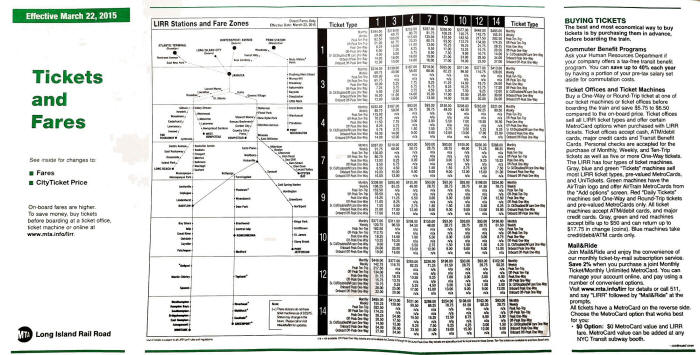 Tariff/Fare Zones - 3/22/2015 Archive: Kevin Wong 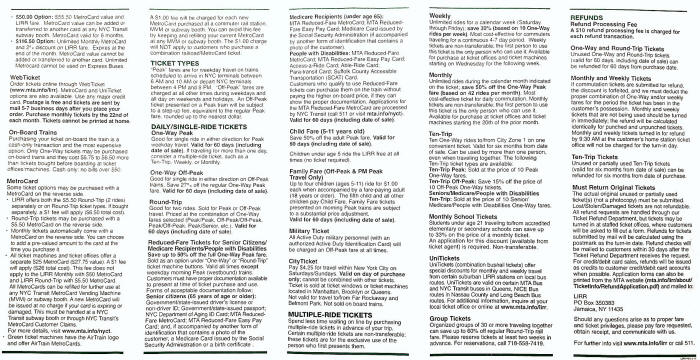 |
|||||||||||
 LIRR Fare Zone - Route Map -2/27/2023 Source: MTA/LIRR |
|||||||||||
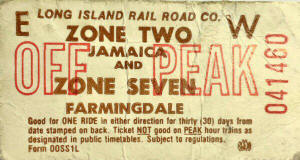 Ticket Form OOSS1L OFF-Peak - Zone2-Zone7 8/02/1979 |
This is a 2 inch by 1 inch "small" ticket sold at Jamaica - Printed by Rand McNally (logo at lower right) good on Off Peak trains. Form OOSS1L tickets were used between September 1975 (when Off-Peak fares were first introduced) and April 1980... May 1980 is when Off Peak One Way fares were discontinued...Peak hours weekdays were trains arriving westbound at City terminals between 6 AM and 10 AM - Eastbound trains departing City terminals between 4 PM and 7 PM...Off Peak tickets were valid at any other time of day including at all times on weekends and holidays. Beginning in July 1980 Off Peak Round Trip tickets valid only on the day of sale during the same designated off-peak hours were sold. Off Peak One Way tickets were brought back to stay with the January 1, 1984 fare increase. Mike McEnaney |
||||||||||
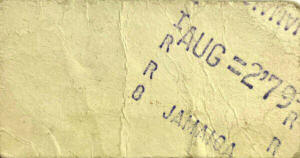 Ticket Form OOSS1L OFF-Peak back - Zone2-Zone7 8/02/1979 |
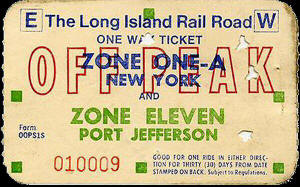 Ticket Form OOPS1S OFF-Peak - Zone1-Zone11 |
||||||||||
|
|
|||||||||||
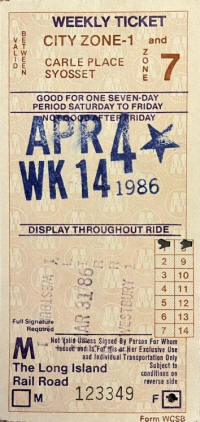 Ticket Form WCSB Weekly Zone1-Zone7 Carle Place-Syosset 4/04/1986 |
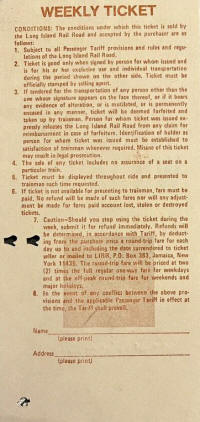 Ticket Form WCSB Weekly Zone1-Zone7 Carle Place-Syosset 4/04/1986 |
||||||||||
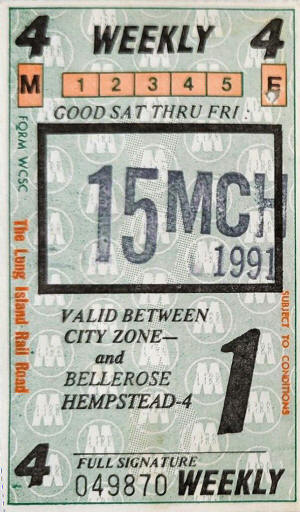 Ticket Form WCSC Weekly City Zone1-Zone4 Bellerose-Hempstead 3/15/1991
|
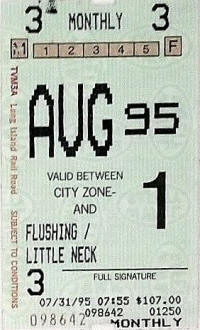 Form TVM3A Monthly Zone1-Zone3 Flushing/Little Neck 8/1995 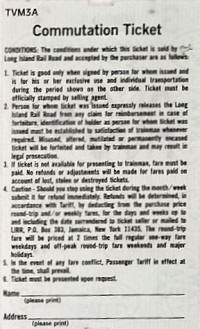 |
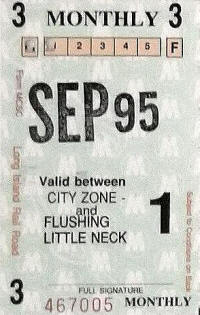 Form MCSC Monthly Zone1-Zone3 City-Zone to Flushing/Little Neck 9 /1995 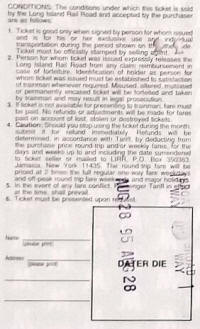 |
|||||||||
|
|
|||||||||||
| TICKET CASES | |||||||||||
_small.jpg) Flatbush Ave Ticket Office - Track Level 6/1972 Photo/Archive: Dave Keller |
_small.jpg) Farmingdale Ticket Office - 6/1972 Photo/Archive: Dave Keller |
_small.jpg) Long Beach Ticket Office - 7/12/1972 Photo/Archive: Dave Keller |
|||||||||
%20(1)_small.jpg) Montauk Ticket Office - 1/21/1972 Photo/Archive: Dave Keller Note: Last Day of the Year Round Agency |
%201_small.jpg) Southampton Ticket Office - 1/1972 Photo/Archive: Dave Keller
|
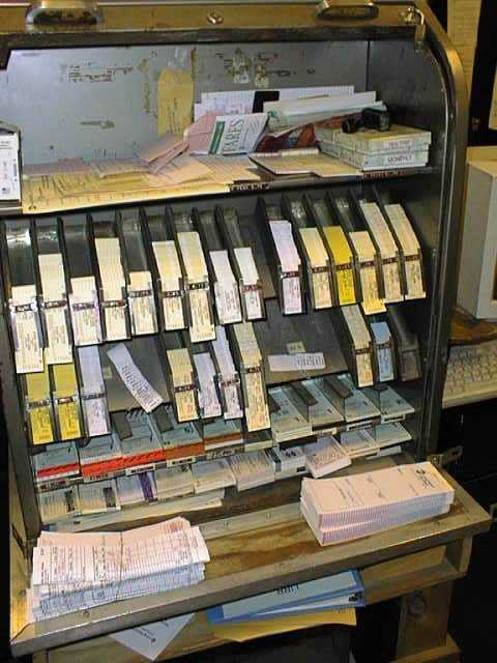 Babylon Ticket case 2001 Photo/Archive: Kevin Fehn |
|||||||||
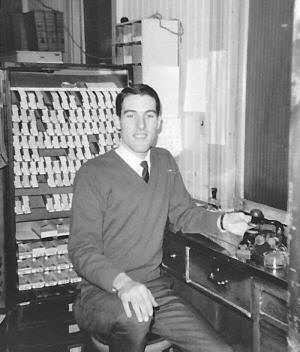 Jamaica Station Ticket case - Extra Ticket Agent Brad Phillips Fall 1969 Photo: Jim Gillin Archive: Brad Phillips |
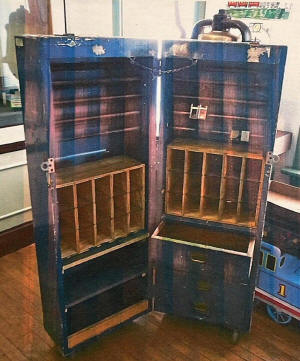 NY Penn Station ticket case 1970's. Photo: Richie Schuman Archive: Jerry Landesman |
||||||||||
|
This is a standard terminal
ticket case of the 1970's. It’s mounted on wheels so it can be easily
moved around the office from window to window and to storage. Each ticket
clerk was assigned a case and a |
|||||||||||
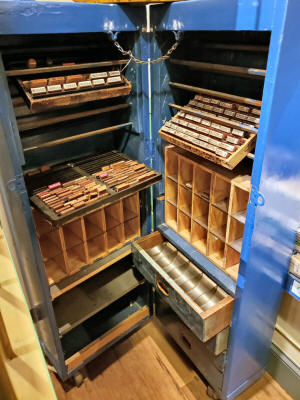 NY Penn ticket case restored at RMLI-Greenport Richie Schulman assembled the station stamps and holders. Ray Franke the paint restoration on the cart. |
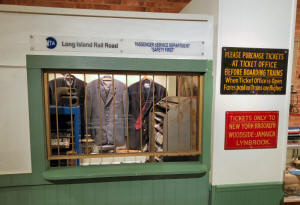 LIRR "Ticket Office" - RMLI-Greenport Photo/Archive: RMLI-Greenport |
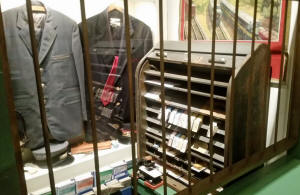 LIRR Ticket Case, ex-Northport Station via Bob Myers. Richie Schulman populated RMLI tickets and timetables Photo/Archive: RMLI-Greenport |
|||||||||
|
|
|||||||||||
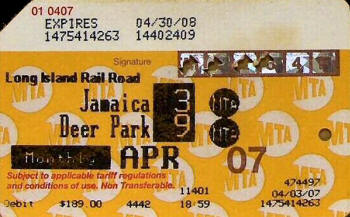 Monthly Jamaica zone 3 to Deer Park zone 9 4/03/2007 |
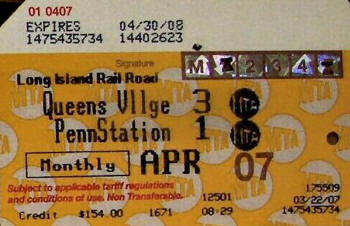 Monthly Queens Village zone 3 to Penn zone 1 3/22/2007 |
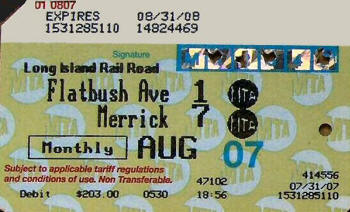 Monthly Flatbush Ave zone 1 to Merrick zone 7 7/31/2007 |
|||||||||
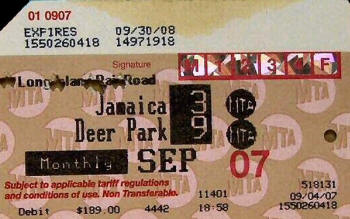 Monthly Jamaica zone 3 to Deer Park zone 9 9/04/2007 |
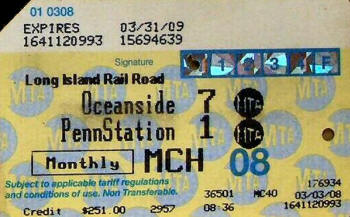 Monthly Oceanside zone 7 to Penn zone 1 3/03/2008 |
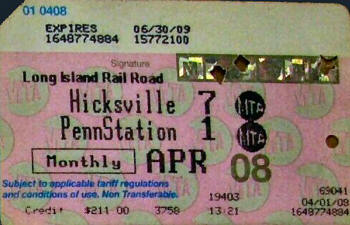 Monthly Hicksville zone 7 to Penn zone 1 4/01/2008 |
|||||||||
| MAIL & RIDE TICKETS | |||||||||||
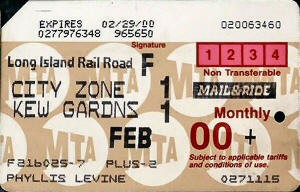 Monthly Mail & Ride City Zone 1 to Kew Gardens 2/2000 Expires in same month |
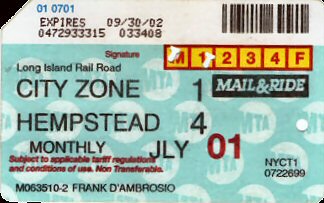 Monthly Mail & Ride City Zone 1 to Hempstead Zone 4 7/2001 Expires in 14 months |
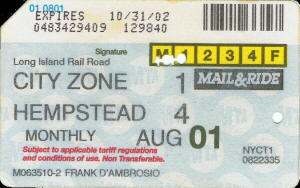 Monthly Mail & Ride City Zone 1 to Hempstead Zone 4 8/2001 Expires in 14 months |
|||||||||
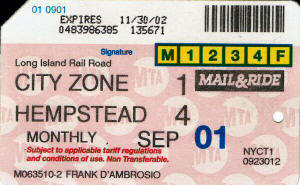 Monthly Mail & Ride City Zone 1 to Hempstead Zone 4 9/01/2001 Expires 14 months |
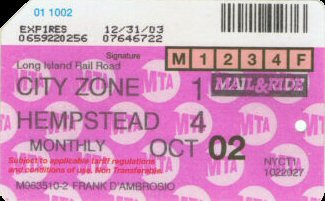 Monthly Mail & Ride City Zone 1 to Hempstead Zone 4 10/2002 Expires in 14 months |
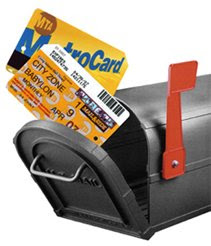 Mail & Ride - MTA |
|||||||||
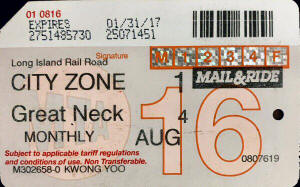 Monthly Mail & Ride City Zone 1 to Great Neck Zone 4 - 8/2016 |
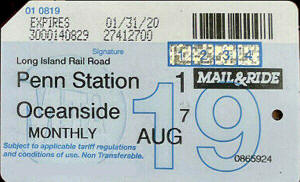 Monthly - Penn-Station Zone 1 to Oceanside Zone - 7 8/2019 |
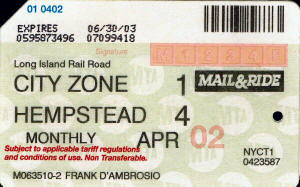 Monthly Mail & Ride City Zone 1 to Hempstead Zone 4 4/01/2002 Expires in 15 months |
|||||||||
|
The current LIRR (and for that matter Metro-North which
uses basically the same TVMs) ticket sales system was introduced 20 years
ago in 2001. The LIRR and Metro-North have eliminated their convenient Mail & Ride program at the end of September 2021. The online interface and everyone's accounts technically still exist, but from the month of October 2021, the MTA has taken the "Mail" out of Mail & Ride and no longer delivers paper monthly tickets to riders through the mail, and now only delivers them electronically to eTix. Source: The LIRR Today |
|||||||||||
|
|
|||||||||||
| METROCARD TICKETS | |||||||||||
|
Monthly tickets have four numbered 1-2-3-4 punch blocks that are serviced on random "punch days". When crews called for orders and messages they were told to "punch block 2" or whatever. It was never announced before time. The intent was to force crews to actually handle "flash" tickets to assure careful examination, and to prevent one ticket from being used by many different people on a single day. Most forgeries back then were photographs, and the paper would be felt by the trainman. The practice also prevented passengers from handing a ticket from one to another on the same train. In later years, the policy was corrupted when "punch days" were announced in advance. Current One Way and Round Trip tickets have a strip of seven orange punch blocks across the upper right numbered 1-2-3-4-5-6-7. These tickets are serviced in this manner: Eastbound 1-2-3; Westbound 7-6-5. 1-Establishes East Direction; 2-Junction Point (Jamaica, Etc.) 3-Destination (cancels ride or ticket) 7-Establishes West Direction 6-Junction Point (Jamaica, Etc.) 5-Destination (cancels ride or ticket), and the 4 block is not used. Mike McEnaney |
|||||||||||
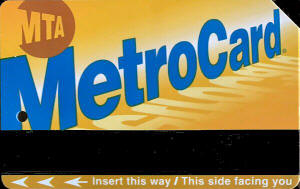 MetroCard front scan side |
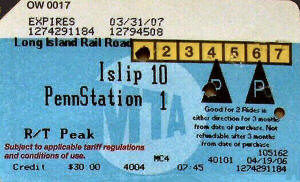 Round Trip Peak - Islip Zone 10 to Penn Zone 1 4/19/2006 |
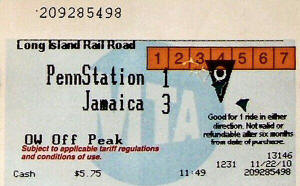 One Way Off Peak - Penn Station Zone 1 to Jamaica Zone 3 11/22/2010 |
|||||||||
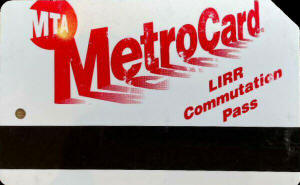 MTA LIRR MetroCard Commutation Pass scan side Expired: 4/30/2019 |
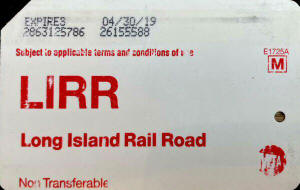 MTA LIRR MetroCard Commutation Pass back Expired: 4/30/2019 |
This Metro Card was issued every 2 years to LIRR TWU employees as a commutation pass. No longer issued; now the regular ID card indicates which railroad you have commutation privileges on with an M (MetroNorth) or L (LIRR). You get one or the other, not both, and it has to be in your union contract. Managers, for example, do not get issued a card. Info: Barry Johnson |
|||||||||
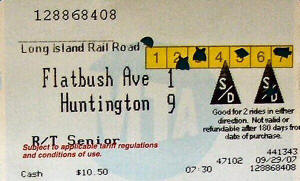 Round Trip Senior -Flatbush Ave Zone 1 to Huntington Zone 9 9/29/2007 |
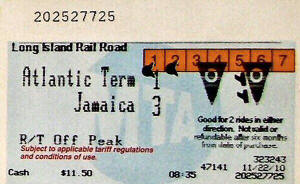 Round Trip OFF Peak - Atlantic Terminal Zone 1 to Jamaica Zone 3 11/22/2010 |
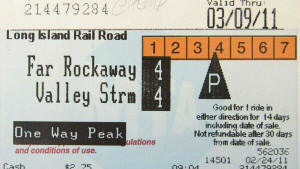 One Way Peak - Far Rockaway Zone 4 to Valley Stream Zone 4 2/24/2011 |
|||||||||
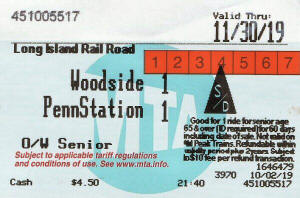 One Way Senior - Woodside Zone 1 to Penn Zone 1 10/02/2019 |
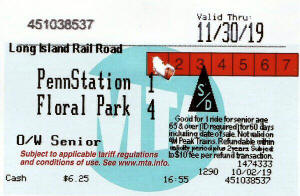 One Way Senior - Penn Zone 1 to Floral Park Zone 4 10/02/2019 |
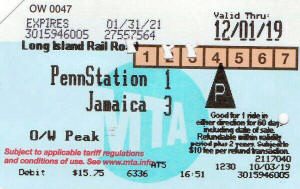 One Way Peak - Penn Zone 1 to Jamaica Zone 3 10/03/2019 |
|||||||||
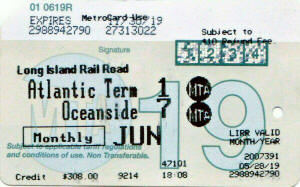 Monthly MetroCard - Atlantic Terminal Zone 1 to Oceanside Zone 7 - 6/2019 |
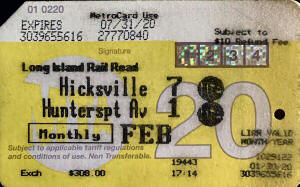 Monthly MetroCard - Hicksville Zone 7 to Hunterspoint Ave Zone 1 2/2020 |
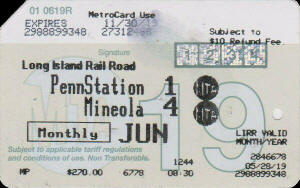 Monthly MetroCard - Penn Station Zone 1 to Mineola Zone 4 6/2019 |
|||||||||
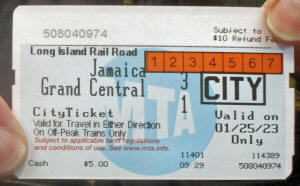 Opening Day City Ticket to Grand Central Madison (GSM) from Jamaica 1/25/2023Attendee/Collection: Dave Morrison |
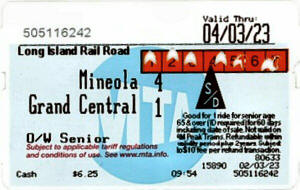 Ticket One Way Senior Mineola to GSM 2/03/2023 Photo/Archive: John Ciesla |
||||||||||
|
|
|||||||||||
| eTIX TICKETS | |||||||||||
MTA eTix Ticketing App Available on LIRR & Metro-NorthJuly 5th, 2016 MTA eTix, a free MTA app that allows Long Island Rail Road and Metro-North Railroad customers to purchase train tickets anytime, anywhere with their mobile devices, is available on all of Metro-North's Lines as well as all of LIRR's branches. The app, which was scheduled for completion by the end of 2016, will now be available to all riders of both railroads under an accelerated timetable made in response to a request from NY Governor Andrew M. Cuomo.The app first rolled out on June 30 on Long Island Rail Road's Port Washington Branch and Metro-North's Hudson Line. Metro-North then made the app available on the Harlem Line on July 25. Customers who prefer paper tickets will be unaffected by the new app. |
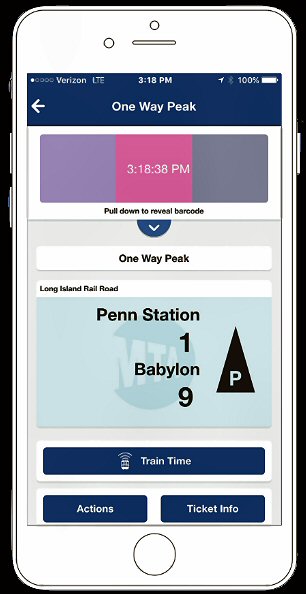 eTix One Way Peak Penn 1-Babylon 9 - 2021 |
||||||||||
|
|
|||||||||||
| GRAND CENTRAL MADISON | |||||||||||
MTA eTix
Combo Ticketing Available on LIRR & Metro-North
|
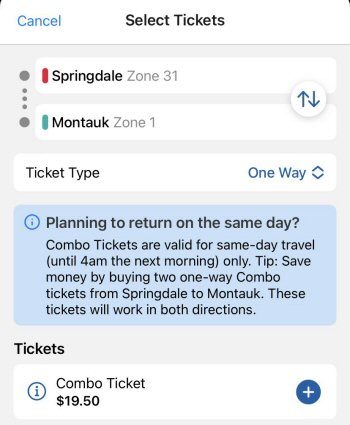 |
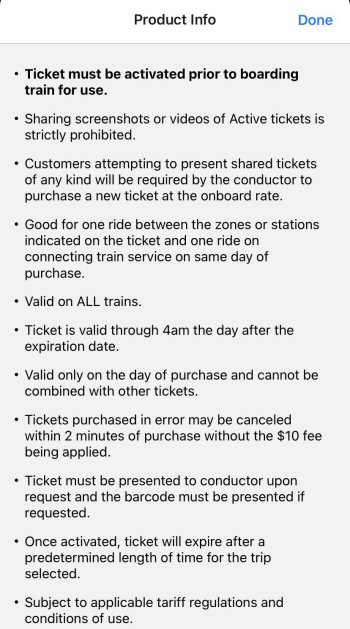 |
|||||||||
|
|
|||||||||||
| TRAINTIME DIGITAL APP | |||||||||||
|
Long Island Rail Road and Metro-North's TrainTime apps,
along with eTix, will soon be combined into one seamless app experience.
MTA Updated August 3, 2022 1:00 p.m. |
|||||||||||
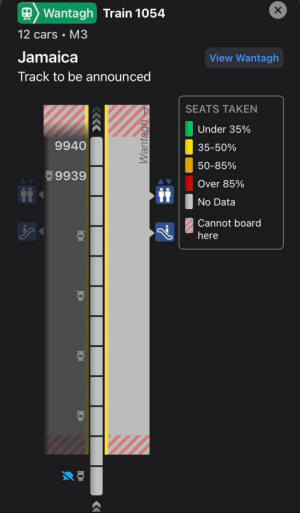 TrainTime App M3s Train 1054 First run testing - Wantagh Station 8/01/2022 Archive: Thomas Farmer |
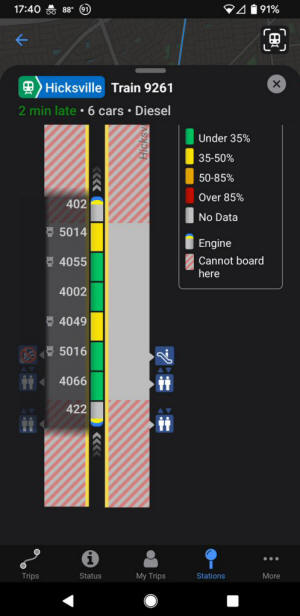 TrainTime App - Hicksville Train 9261 7/21/2022 |
||||||||||
|
|
|||||||||||
| SUPPLEMENTAL FARE TICKETS | |||||||||||
|
Note it has an agent’s stub
which indicates it was in general |
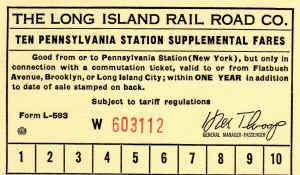 Supplemental Fare Ticket - Form L-593 sold on 10/16/66 at Amityville. |
|
|||||||||
|
The commutation (i.e., weekly and monthly, but NOT ten-trip) fares to the western terminals were the same EXCEPT there was a surcharge (i.e., a supplemental fare) required to travel to Penn Station (to pay for the tunnels, as I
recall. Many commuters who went to Flushing, Brooklyn or LI City and also Penn would need to pay the supplemental fare. On board the train, trainmen would issue a standard cash fare receipt for (in the 60’s) 15 cents. Up until
c.1966 only a ten trip supplemental ticket was available (see above) which was convenient for both riders and trainmen. The fare was $1.50 (15 cents times 10 rides). |
|||||||||||
|
|
|||||||||||
| EXCURSION TICKETS | |||||||||||
|
Railroads issued excursion tickets for many reasons; to get more traffic of course, but also to serve the public in enabling reasonable (cheap) fares to popular places and events (beaches, amusement parks, flower shows, etc.). There almost always a round trip and have a limited life (one day, weekend, etc.). Often, special trains were run in addition to regularly scheduled service. Of course, the LIRR offered many excursions over the years, the more famous being Race Track trains and Fishermen's Specials. Info/Photos/Archive: Brad Phillips |
|||||||||||
 LIRR - Canoe Place Excursion 1946 |
 Ticket souvenir ERA (Electric Railroader's Association) 3/22/1980 |
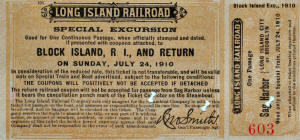 Round trip excursion to Block Island 7/24/1910 |
|||||||||
|
|
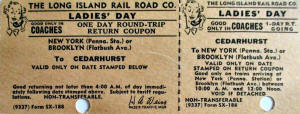 Ladies Day One Day Round Trip- Sample |
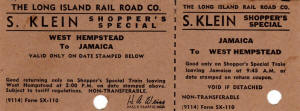 Excursion - S. Klein Shopper's Special - Jamaica to West Hempstead |
|||||||||
| BEACH EXCURSIONS | |||||||||||
|
Long Beach tickets in use until c.2005, when the TVM station sales machines were entirely deployed. Round trip rail fare to/from Long Beach and admission to the pay-entrance Long Beach City beachfront. Mike McEnaney
|
 Form SX 133 NY Penn Zone 1 to Long Beach Zone 7 with Ocean Beach Park beach pass |
 Form SX 233 Jamaica Zone 3 to Long Beach Zone 7 with Ocean Beach Park beach pass |
|||||||||
|
The LIRR sold similar tickets for Jones Beach in season - a round trip LIRR fare to Freeport along with round trip bus fare on LI BUS (now NICE Bus) from Freeport Station. Mike McEnaney More: |
 Form SX 123 NY Penn Zone 1 to Freeport Zone 7 Jones Beach Bus - Archive: Kevin Fehn |
 Form SX 223 Jamaica Zone 3 to Freeport Zone 7 Jones Beach Bus - Archive: Kevin Fehn |
|||||||||
|
|
|||||||||||
| RACE TRACK TICKETS | |||||||||||
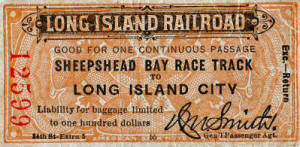 Ticket Sheepshead Bay Race track to LI City c.1905 General Passenger Agent: H.M. Smith |
 SPL EXC 1464 Belmont Park to NY Penn Going/Return Sample - c.1930's GPA-Shaw |
 SPL EXC 1465 Metropolitan Jockey Club to NY Penn Going/Return Sample c.1930's GPA-Shaw |
|||||||||
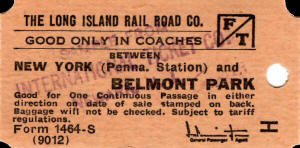 Form 1464-S NY Penn-Belmont Park c.1943 GPA-Pennington |
 Form 86-D Woodside-Belmont Park 9/1943 GPA- E .R. Comer appointed 10/16/43 - 1946; not a common ticket! Each portion is good in either direction and works as a round trip. Perhaps done for selling agent convenience (similar to the standard 1-BHY yellow paper round trip tickets). Brad Phillips |
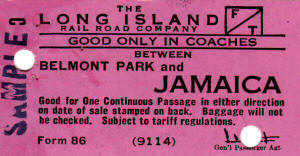 Form 86 Belmont Park-Jamaica c.1943 Sample - GPA-Pennington |
|||||||||
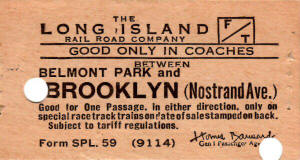 Form SPL 59 Belmont Park-Brooklyn 1947 GPA: Homer Bannard |
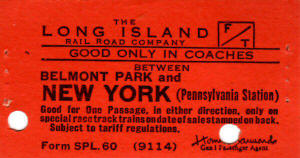 Form SPL 60 Belmont Park-NY Penn 1947 GPA: Homer Bannard |
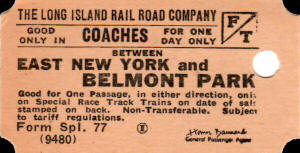 Form Spl 77 East New York-Belmont Park c.1947 GPA: Homer Bannard |
|||||||||
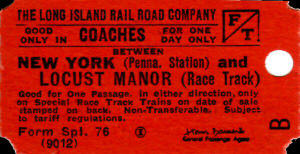 Form Spl 76 NY Penn-Locust Manor c.1947 GPA: Homer Bannard |
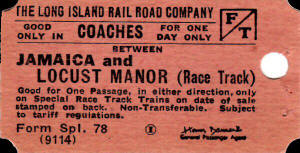 Form Spl 78 Jamaica-Locust Manor (Race Track) c.1947 GPA: Homer Bannard |
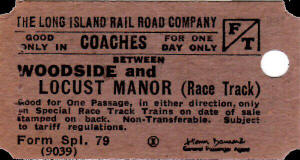 Form Spl 79 Woodside-Locust Manor (Race Track) c.1947 GPA: Homer Bannard |
|||||||||
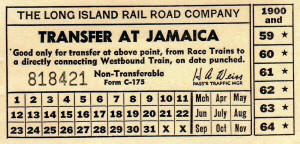 Belmont Park transfer ticket C-175 1959 Archive: Brad Phillips |
 Form SX-131 Meadowbrook-NY Penn c.1953+ Passenger Traffic Manager: H. A. Weiss Info//Tickets Archive: Brad Phillips
More: |
||||||||||
|
|
|||||||||||
| CHRISTMAS TICKETS | |||||||||||
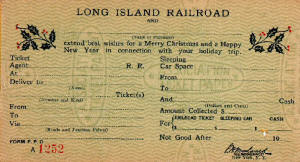 Form P.P.O. LIRR Christmas prepaid ticket order - you could prepay for a trip, either on the LIRR or a foreign road, and send to a recipient as a gift (e.g., pay for the kids to come home for the holidays). Signed LIRR Gen. Passenger Agent P.H. Woodward c.1920's |
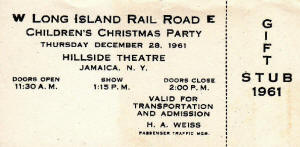 LIRR passage and admission ticket for Children's Christmas Party, Hillside Theatre, Jamaica 12/28/1961 |
Info//Tickets Archive: Brad Phillips
|
|||||||||
|
|
|||||||||||
| GROUP PARTY TICKETS | |||||||||||
|
1. The group travels only one way – a one way party ticket is issued. Form
LH-267 |
|||||||||||
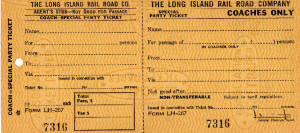 Form LH-267 Coach Special Party One Way |
 Form LH-363 Coach Round Trip Party ticket has an open expiration date (good until __ ) |
 Form LH-364 Group Special Coach Party Round Trip good only on the date of sale
|
|||||||||
|
|
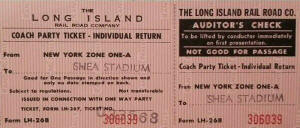 Form LH-268 Coach Party - Individual Return ticket New York Zone A - Penn to Shea Stadium 4/23/1982 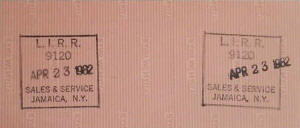 |
 Form 107-9 Special Transportation Order Plainville High School, Hicksville to New York
Tickets Archive: Brad Phillips |
|||||||||
 Form 107-11 Main Line Special Excursion ticket |
 Form 107-10 East End Special Excursion ticket |
 Form 107-Y Bridgeport Ferry Special Excursion ticket |
|||||||||
|
Note: Specific trips indicated by the number/letter following the
Form 107-nn Tickets Archive: Brad Phillips |
|||||||||||

 11/12/1995 - LIRR Group Travel Rates - 3/19/217 - Archive: Kevin Wong |
LIRR Group Travel Rates - One-Day Round
Trip Group Fares to Penn Station One-day round trip group rates are valid for 30 persons or more traveling together on select trains. The youth fare applies for students 18 years of age or under. The adult fare applies for all groups using individual return tickets. Reservations should be made at least two weeks prior to the trip to reserve space on trains. Group rates are subject to change and space is based upon availability. LIRR Group excursions offer the lowest round trip rate fares for groups and parties of 30 or more on one train. LIRR no longer publishes excursion fares, as groups now must submit a reservation online and receive a quote. Once a reservation is confirmed, the confirmation can be printed and used to purchase the group fare at a ticket office. Kevin Wong - Historian
|
||||||||||
|
|
|||||||||||
| BUS TICKETS | |||||||||||
 Bus Ticket Form P1BRH - 1971-75 4/29/1975 |
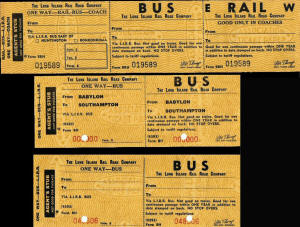 Western terminal stations and those served by the busses issued the combination rail and bus tickets. Bus-only tickets (left) were sold there as well. Brad Phillips |
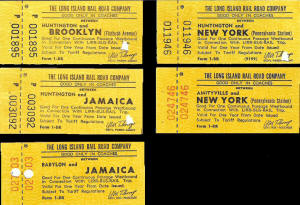 For passengers boarding busses at non-rail stations, the bus drivers sold rail tickets to Jamaica, Brooklyn and New York (only) from pads clipped to the dash; no date validation was made. Brad Phillips |
|||||||||
|
|
|||||||||||
| SCHOOL TICKETS | |||||||||||
|
From the MTA/LIRR website: Discount of up to one-third off the price of a regular Monthly ticket. Complete application and bring to a ticket office. Applications must be signed by a school official and have the school seal affixed. Non-transferable.
|
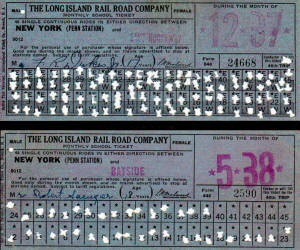 School Form 546 double punch NY to East Rockaway thru Jamaica 12/1937 - Ticket Form 446 single punch NY to Bayside 5/1938 Archive/Info: Brad Phillips
|
||||||||||
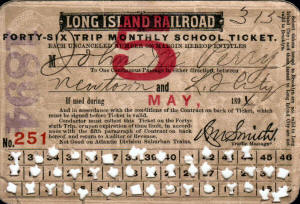 School Monthly 46 Trip - Newtown and LI City 5/1894 - GPA H.M. Smith Archive: Brad Phillips
|
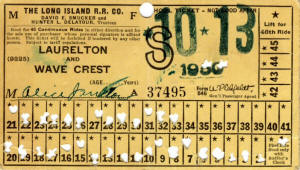 Form 846 Wave Crest and Laurelton School Ticket 10/13/1950 Archive: Brad Phillips 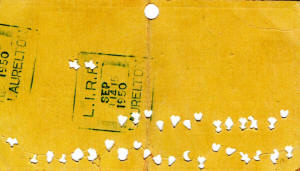 |
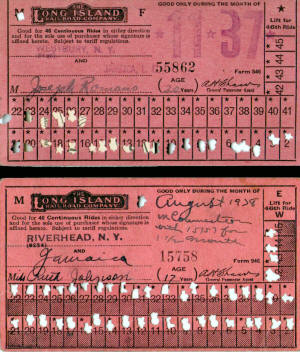 School Form 846 Westbury and Jamaica 11/1937 - Ticket Form 946 Riverhead and Jamaica 8/1938 Archive/Info: Brad Phillips |
|||||||||
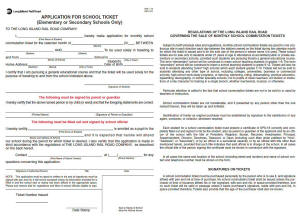 Application for School Ticket - LIRR Form SPS-18 REV. 4/11 |
|||||||||||
|
|
|||||||||||
| CLERGY TICKETS | |||||||||||
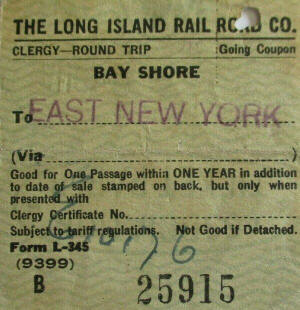 Ticket Clergy Round Trip - Bay Shore to East New York Form L-345 8/09/1943 |
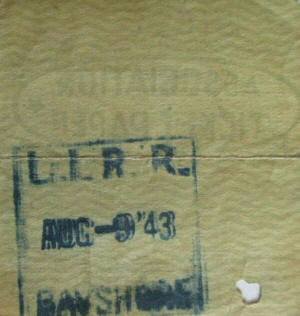 Ticket Clergy Round Trip back - Bay Shore to East New York Form L-345 8/09/1943 |
||||||||||
 Ticket Clergy Round trip - East NY-Brentwood Form L-128 C.1948 signed: GPA W. P. Eckfeldt Note: Brentwood had the Sisters of St. Joseph, hence the tickets to Brentwood. Dave Keller info. |
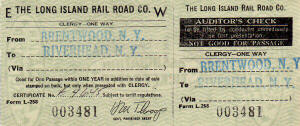 Ticket Clergy - Brentwood-Riverhead Form L-258 c.mid-1960's signed: GPA Harold Throop |
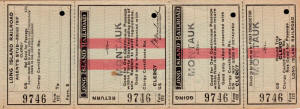 Ticket Clergy Round trip Open-Montauk Form 122 c.1925 signed GPA P.H. Woodward |
|||||||||
|
|
|||||||||||
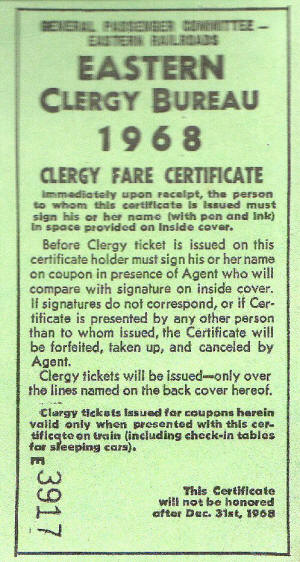 |
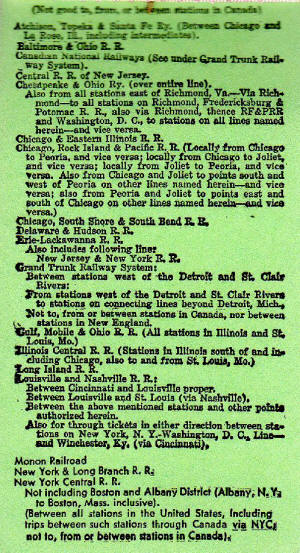 |
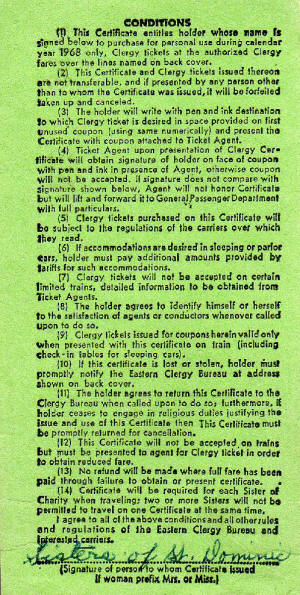 |
|||||||||
|
Note: These are not LIRR forms. The certificates are (were) issued by clergy bureaus who are the independent agencies which authenticate applications for the reduced fare. There are (were) several around the country. Example: From the Catholic Courier Journal, 11/24/67: “Clergy Rate Still Goes on RR Lines in New York - Railroads will continue to offer reduced first-class fares to clergy during the year 1968 it was announced recently by the Clergy Bureaus of Eastern Railroads. Fifty per cent reductions in railroad first class passenger fares have been available for years to ordained and licensed ministers, missionaries, theological students and many other categories of religious workers who obtain a certification coupon book from the railroad bureaus. Reduced clergy fare tickets are honored on all eastern railroad trains without exception. Mr. Winkler said that applications for the 1968 books were now being accepted at the Clergy Bureaus of Eastern Railroads, One Park Avenue, New York, N.Y. 10016. The cost of the 50 trip book issued by the Eastern Clergy Bureau is $14 and $11 for the book issued by the New England Clergy Bureau.” The Sisters of St. Dominic resided at the Catholic Church in Amityville and the certificates were used by whatever nun had to travel; as evidenced in the signed certificate above right. The bureaus were non-denominational, all clergy and
religious workers were eligible. In all my years of ticket selling, clergy
tickets were rare. Amityville had quite a few, relatively speaking, due
to the large religious community (mostly Catholic). In the terminal
stations I’d get one every now and then. As I recall, many stations did
not have the clergy forms; you’d just use standard LH-261 blank forms and
mark them clergy with the certificate number. The coupon from the
certificate book would be stapled to the agent stub. Research: Brad
Phillips |
|||||||||||
| POLICE-FIREMAN TICKETS | |||||||||||
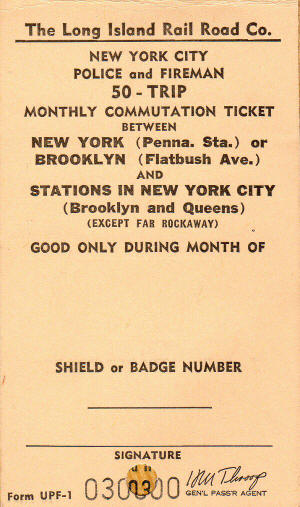 Ticket Police-Fireman NY City all stations - 50 Trip Monthly Form UPF-1 |
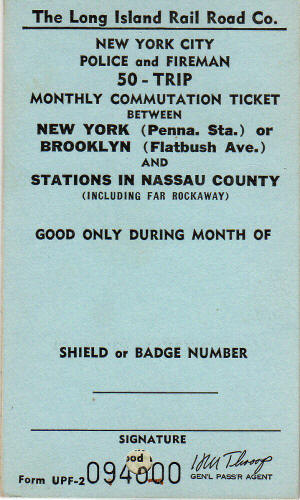 Ticket Police-Fireman NY City-Nassau County - 50 Trip Monthly - Form UPF-2 |
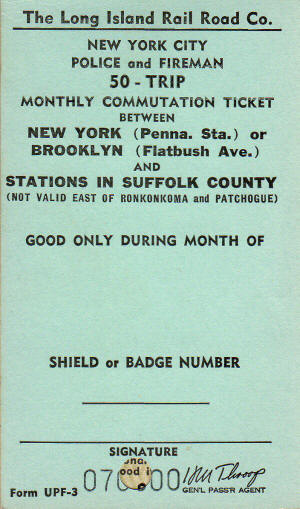 Ticket Police-Fireman NY City-Suffolk County - 50 Trip Monthly - Form UPF-3 |
|||||||||
 Ticket Police-Fireman NY City all stations - 50 Trip Monthly Form UPF4 |
 Ticket Police-Fireman NY City-Nassau County - 50 Trip Monthly Form UPF5 |
 Ticket Police-Fireman NY City-Suffolk County - 50 Trip Monthly Form UPF6 |
|||||||||
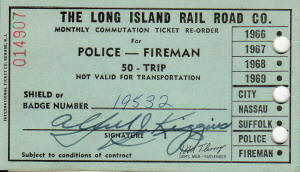 Cover of the 12 month coupon book to be presented to the ticket seller. 50 Trip NY City Police 1967 |
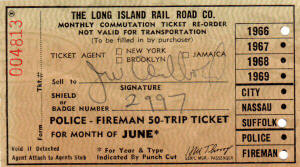 Coupon from the book which is given to the ticket seller when purchasing the ticket. Monthly 50 Trip Suffolk County Fireman 1966 |
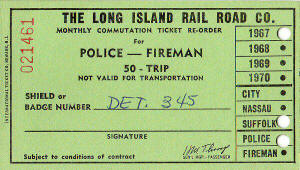 Cover of the 12 month coupon book to be presented to the ticket seller. 50 Trip Suffolk County Police 1967 |
|||||||||
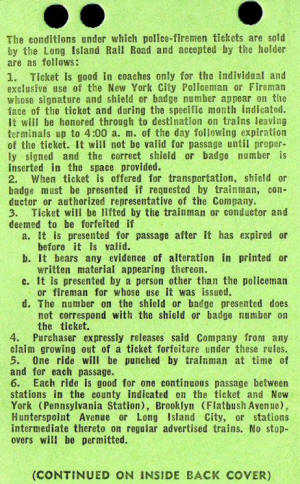 |
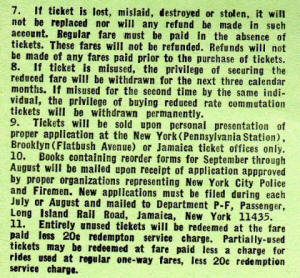 Police Ticket conditions details how the books were authorized and issued. |
||||||||||
|
Police – Fireman tickets were sold at a discount to active
employees (e.g., they had to have an ID and shield [badge]). There were 3
forms: NY City (UPF-1), Nassau County (UPF-2), and Suffolk County (UPF-3).
I’m not familiar with how the books were issued; probably something
similar to school tickets where a certification form would be required.
|
|||||||||||
|
|
|||||||||||
| PARLOR TICKETS, CHECKS & CERTIFICATES | |||||||||||
|
Parlor cars were a first class space, so you needed a first class ticket along with a space ticket. The standard LIRR parlor ticket had all that built in. As I recall, you also needed a first class ticket for transportation of remains so this form would be used for that. If you already had a coach ticket and wanted to step up to parlor, there was a step up ticket for the coach to first class fare and another form for the parlor space only. |
|||||||||||
 Parlor Ticket One Way - Form LP-261 - Jamaica-Richmond Hill - GPA Shaw c.1930's Archive: Richard Ryan
|
|||||||||||
 Parlor First Class Round Trip Ticket - Form LP-343 blank - GPA Comer |
|||||||||||
|
|
|||||||||||
| “Back in the day”, before zone tickets ( first introduced January 29, 1972 ), if you had a coach ticket and wanted to ride in the parlor, you’d need to buy a “step-up” ticket for the difference between coach and first-class fares and then pay the seat charge (Parlor and Sleeping Car space required a first-class fare). I did a few of those when selling parlor tickets at NY Penn, but it took time and the line of impatient customers would grow. The easiest path was to refund the passenger’s coach ticket and sell the special parlor ticket which took all the above into account. Also, you could tell the customer to pay the difference on the train (if they had a reservation), but I’d never do that as the trainmen had enough on their plate; collecting tickets and dealing with other issues. Brad Phillips | |||||||||||
|
|
 Parlor/Sleeping Car Certificate - Form 1 BH Hunterspoint Ave to Montauk Passenger Traffic Mgr. H. A. Weiss
Tickets & Checks Photos and Research: |
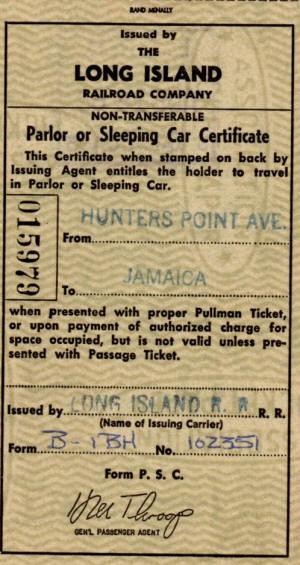 Parlor Certificate - Form P.S.C. B-1BH Hunterspoint Ave to Jamaica GPA Throop 8/16/1968
This ticket is for the Step Up fare to allow riding in the parlor.
The handwritten data refers to the underlying coach ticket, in this case a
Brooklyn to Jamaica one way (the B in form B-1BH designates a Brooklyn
ticket printed on pink paper; NYP tickets were blue and all others
yellow). A Brooklyn ticket had the same fare as Hunterspoint and
there were no Hunterspoint printed tickets as Hunterspoint did not have a
ticket office. Info: Brad Phillips |
|||||||||
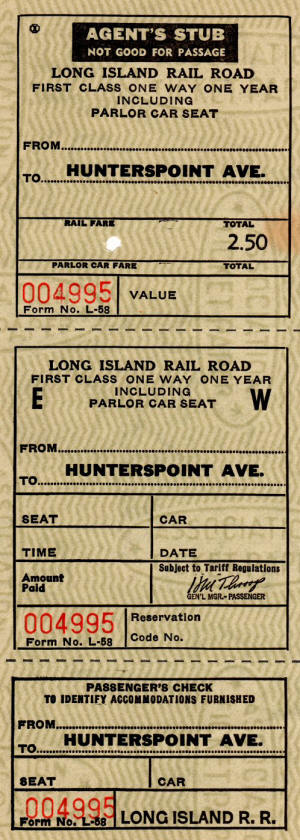 Parlor Ticket & Check Form L-58 -Blank-Hunterspoint Ave. Gen. Mgr. Pass. Throop c.1968 |
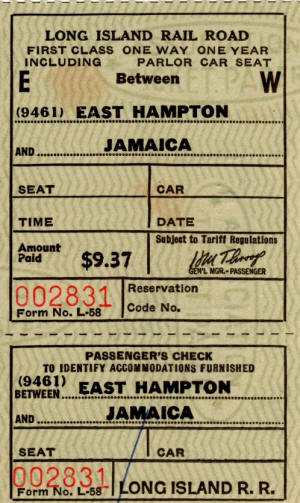 Parlor Seat First Class One Way Ticket/Check - Form L-58 East Hampton-Jamaica - Gen. Mgr. Pass Throop 8/29/1971
|
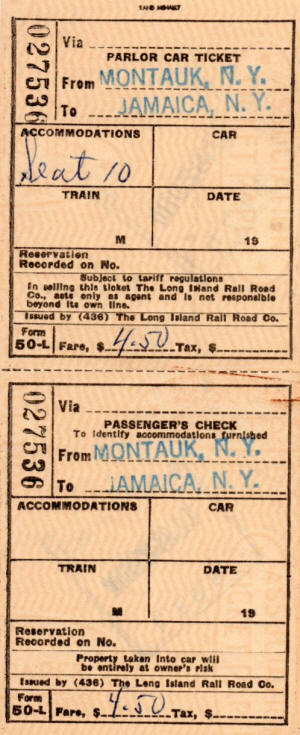 Parlor Ticket/Check - Form 50-L - Montauk to Jamaica 8/29/1971 |
|||||||||
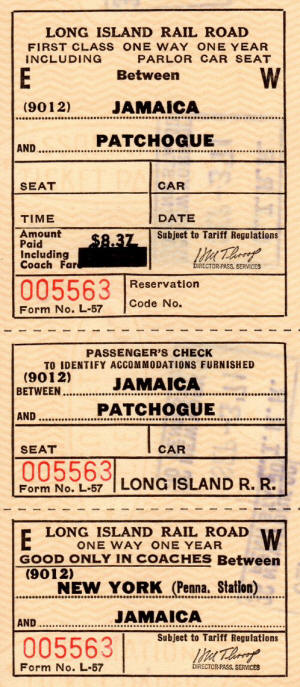 Parlor Ticket & Check Form L-57 - Jamaica-Patchogue Dir. Pass. Services Throop c.1968 |
 Parlor Ticket & Check Form L-57 - Jamaica-Montauk Throop c.1968 |
||||||||||
 Parlor/Coach Mixed Class Ticket - Form MC-100 - Jamaica to blank - GPA Throop c.1968 A mixed class, coach and first class passage, no space. This form originated in the Throop era; perhaps easier to use than the combination of older forms. Used if a passenger had a space ticket only, but needed the rail fare. The coach ticket would be from NY Penn or FBA and the parlor portion east. The auditor’s check is actually superfluous as there would never be a change of trains between the terminals and Jamaica. |
|||||||||||
|
|
|||||||||||
| Note: There were varied trip Pullman First Class ticket options for those who commuted on the parlors. Brad Phillips | |||||||||||
 Pullman Ten-Trip Ticket - Form 210 P - Sample GPA Shaw c.1930's |
|||||||||||
 Pullman Ten-Trip Ticket - Form 211 P - Sample GPA Shaw c.1930's |
|||||||||||
 Pullman Twenty-Trip Ticket - Form 220 P - Sample GPA Shaw c.1930's |
|||||||||||
 Pullman 50-Trip Ticket - Form 251-P - Sample GPA Shaw c.1930's |
|||||||||||
 Form LP-231 Parlor-Sleeping One Way punch ticket from NY Penn GPA: Pennington |
 Form LP-232 Parlor-Sleeping Round Trip punch ticket from NY Penn GPA: Pennington |
|
|||||||||
|
|
|||||||||||
| Parlor Car Seat Charge | |||||||||||
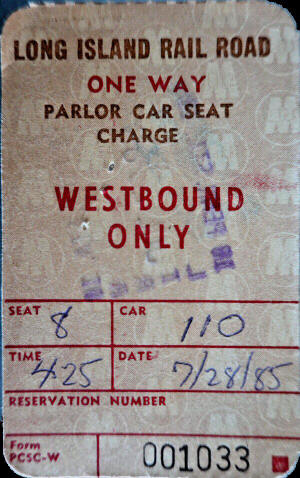
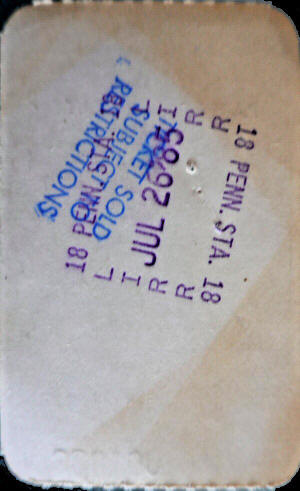 Parlor Car Seat Charge - Form PCSC-W 7/26/1985 - eBay Listing The extra fare required to reserve a parlor seat over and above the regular coach fare. Evidently, they have forms for both EB and WB. |
|||||||||||
|
|
|||||||||||
| MISC TICKET TYPES | |||||||||||
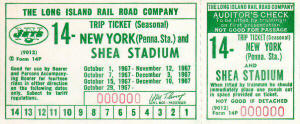 LIRR seven games NY Jets roundtrip NY Penn-Shea Stadium Ticket Form 14P 1967 Season. Interesting feature: you could take 6 people with you to one game, or go to 7 games by yourself, or anything in between. Note the instruction to the trainman on the auditor's stub after you tear this coupon off, don't forget to punch the ticket! Archive: Brad Phillips |
Back then the New York Jets played their AFL (14 game
season) home games at Shea Stadium. The AFL merged with the NFL in 1970.
The home games played at Shea Stadium coincide with the seven dates listed
on this ticket: |
||||||||||
|
|
|||||||||||
| ADL-205 MANUAL OF INSTRUCTIONS TO PASSENGER CONDUCTORS AND COLLECTORS | |||||||||||
|
August 1, 1954 – Cover below along with a supplemental sheet. This publication has everything need to know to handle transportation aboard a train. The ADL-205 (little brother to the PRR AD-205) is about 50 pages of instructions. Great reading (paragraph 1.3 of the attached – "Notify the Police" Archive/Info: Brad Phillips |
|||||||||||
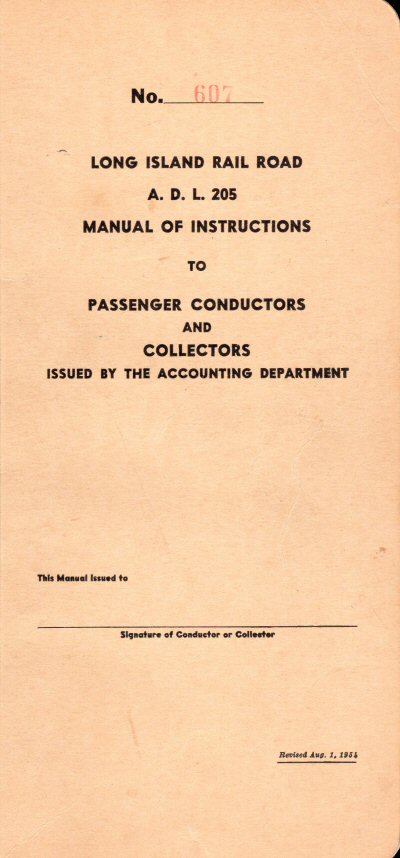
|
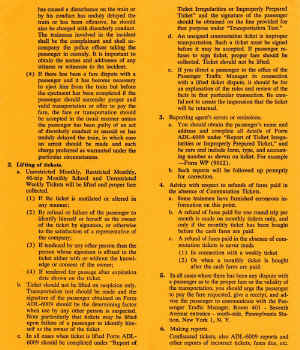
|
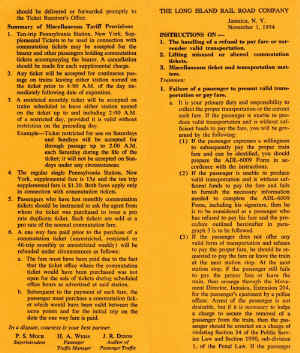
|
|||||||||
| STATION NUMBERS | |||||||||||
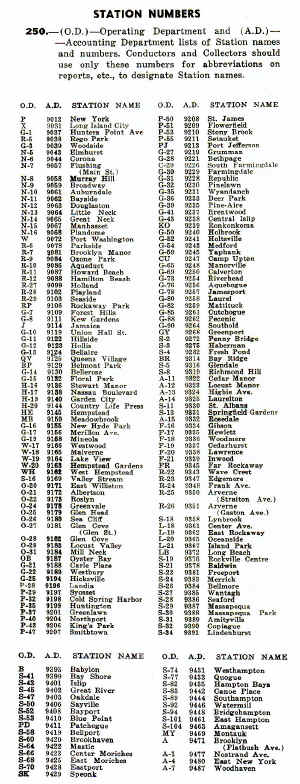 ADL-205 Operating/Accounting Dept's Station Name designations by Branch |
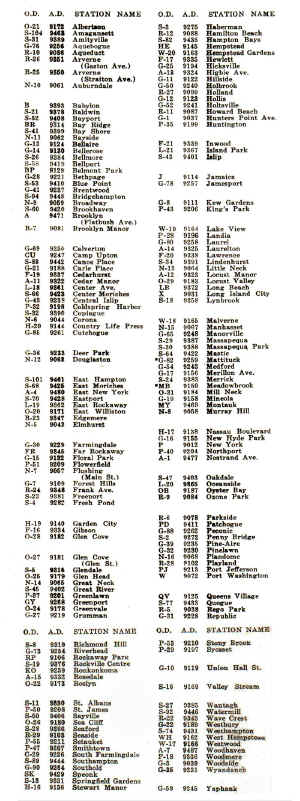 ADL-205 Operating/Accounting Dept's alphabetical Station Name designations |
||||||||||
| CONDUCTOR TICKET PUNCHES | |||||||||||
|
The main supplier to the Pennsylvania Railroad related to tickets, timetables and printing was Allen Lane & Scott, Philadelphia, PA. This LIRR ticket punch (note the LI stamped on the grip) was one of thousands issued to LIRR conductors, brakemen and collectors over the years.
|
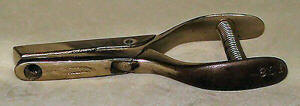 Allen Lane & Scott LIRR punch with serial number/LI stamped on handles, c.1940 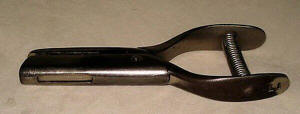 |
 1867 Ticket Punch patent Archive: The LIRR Today
|
|||||||||
|
The dual punch
adopted by the LIRR (right) as noted above. These were impossible to
obtain when they were in use as each one was registered and assigned
to each conductor/trainman. They were retired when the LIRR stopped
using the V cut CFR’s (in, I believe, the early 1970’s). While there
were several railroads that used dual cut punches, the LIRR’s were
unique having the V cut.
|
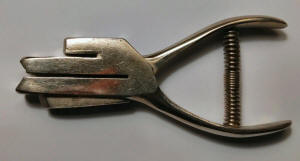 LIRR dual punch 1950's.
|
 LIRR - CFR Form 279 4/06/1963 1st Train to Babylon Temporary Station Archive/Info: Brad Phillips
An example of a V cut cash fare receipt (CFR) if the |
|||||||||
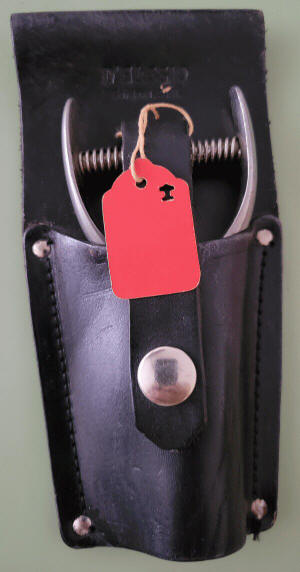 |
This is a pre-1950s LIRR punch in its holster
and a tag showing the specific trainman/conductor punch cut design.
No two were alike in use at the same time as the punch cut designs were unique to identify employees. A trainman/conductor's punch was like a bank tellers teller stamp. Dave Keller
|
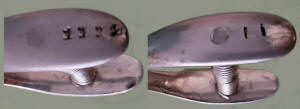 The punch serial number on one handle and "LI" on the other handle.
Photos/Archive: Dave Keller
|
|||||||||
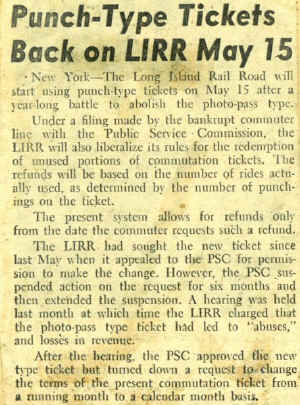 Punch Type Tickets Back - Newsday 5/06/1954 Archive: Dave Morrison |
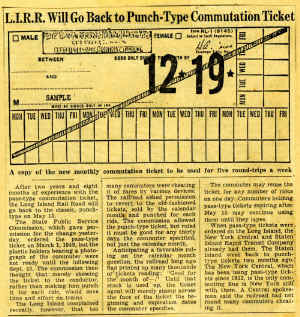 LIRR Punch Type Tickets are back - LIRR Publicity Dept, NY Times 5/07/1954 Archive: Dave Morrison
|
|
|||||||||
| LIRR DATER STAMPERS | |||||||||||
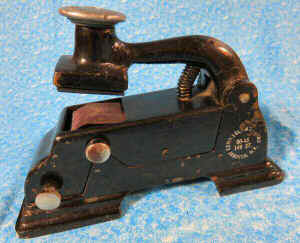 Aurora Dater Stamper c. 1960 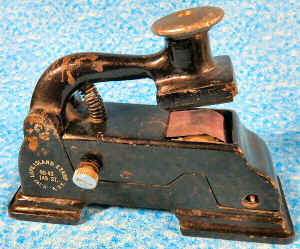
|
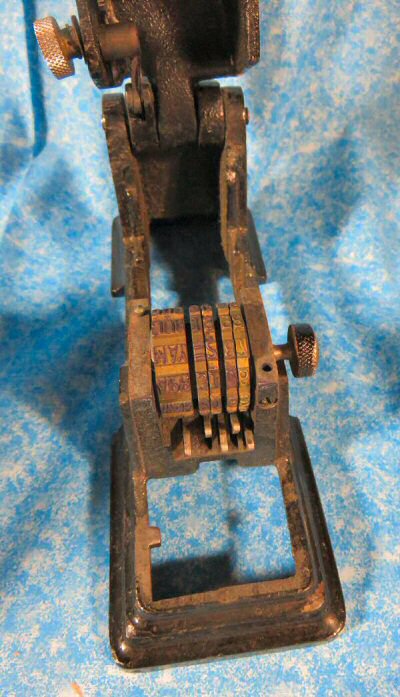 Aurora Dater Stamper- Die Wheel c.1960 |
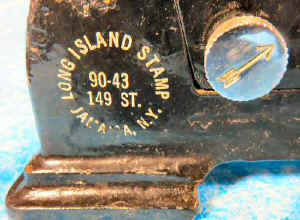 The lettering "Long Island Stamp" on the side was the company that they were purchased from, not the manufacture. It does not indicate that the dater was used on the LIRR or in the Jamaica ticket. In my years of hanging around and eventually working at Jamaica ticket, I don’t recall ever seeing this style of dater being used. It’s POSSIBLE that such a machine was used in Jamaica prior to 1960 of course. I have several LIRR dies that fit this style of machine but they’re very old and are from line stations.' Brad Phillips This was an old Aurora model used up until the late 70's/80's. Then we used a dater made by Ajax that was a piece of crap and went to one made by Cosmo. The problem with the Auroras was the year wheel couldn't go high enough and they had to be replaced. Kevin Fehn |
|||||||||
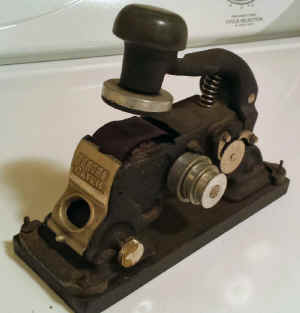 Aurora Dater Stamper - Photo: Brad Phillips
The dates on the Cosmo and Aurora daters were |
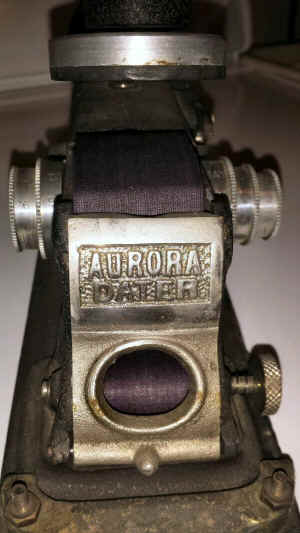 Aurora Dater Stamper front - Photo: Brad Phillips |
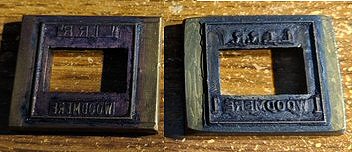 Dater Die plates - Aurora Dater - Woodmere Ticket Office Archive: Kevin Fehn
|
|||||||||
|
The dater (validator) that is shown, above left, is an old Aurora model that was used from the early 1900's up until the late 70s or early 80s. The later Cosmo daters replaced the Ajax daters. The Ajax daters were purchased to replace the Auroras when the year wheel couldn't hit the new dates. The Ajax daters had a slide insert for your IBM number. They were crap and didn't hold up. The worse part was an auditor won the suggestion award for the Ajax. They were a pain to work with. Kevin Fehn |
|||||||||||
|
|
|||||||||||
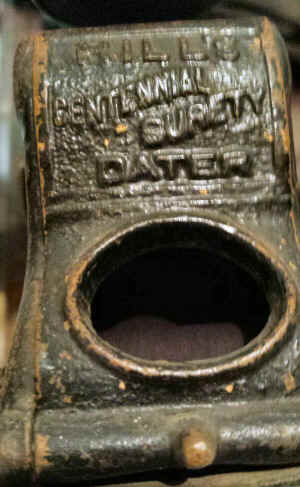 Hills Centennial Dater front - Archive: Brad Phillips
|
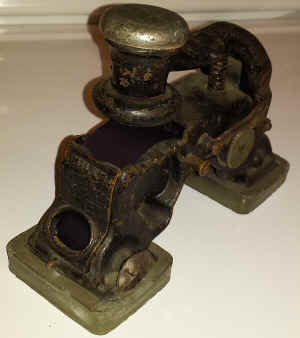 Hills Centennial Dater - Archive: Brad Phillips
|
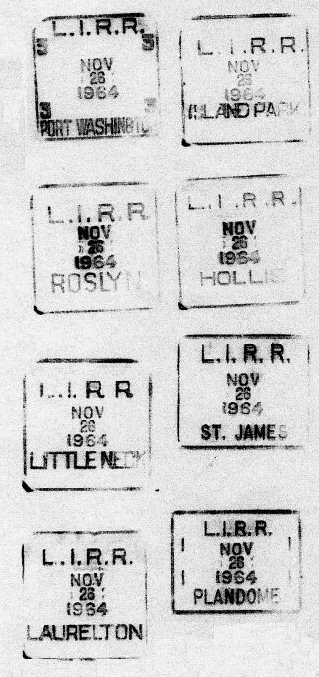 This is the dater used for the round dies, dates arranged vertically. Archive: Brad Phillips
|
|||||||||
|
Ah, the memories … All these daters were very sturdy machines. I never saw one break down and many I used were very old. These things took a real beating over time. Just think, for example, the number of tickets issued at NY Penn. I have tickets issued with the same die decades apart. Of course, they eventually wore down. The great 1960’s die replacement was a result of years with no new dies. Many clerks, most probably, would wait forever to change the inked ribbon and, thus, the die impressions were often very light to non-readable. They did not pay too much attention to where the impression was put on the ticket so many, many tickets had missing station names, dates, etc. Over time the die would cake up with ink and the impression became unreadable. Cleaning was a mess: toothbrush or wire brush with soap and water (or toothpaste which was very effective) was used to clean them. Your fingers were then blue for the next day or two! The dies were locked up with the cash in the safe. If big enough, the entire machine and die were stored there. If not, the die was removed and the dater left on the counter. The “dater die” on the above right, without a numeral, is the old die which was replaced with the die having the number 1. When the railroad started getting rid of all the old Hills Centennial daters (which required periodic replacement of the year wheel) and dies in the early 1960’s they retired many old Aurora dies that had significant wear from use. Thus, many stations saw old Aurora square dies replaced with new ones having the die numbers. So even if a station, like Woodmere, had only one die they still put the number 1 in the lower corners. Unfortunately, I don’t have a ticket issued at Woodmere even though I worked a (single) Monday morning rush hour there. As there was only one dater, the clerk had pre-stamped a large pile of weekly tickets which I sold at the second ticket window while he handled any one ways along with weeklies. I never went back to get a validated ticket for my collection. Oh well. One thing I can add about the daters is that the
regular clerks would never change the ribbon. They would leave a note or
the extra would see that you could barely read the impression and they
would have to change the ribbon. That was a pain since you would get ink
all over your hands and eventually your shirt (pastel colored of course). |
|||||||||||
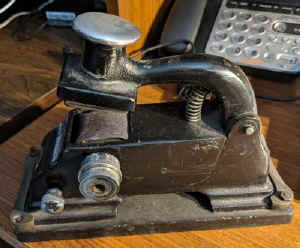 Cosmo Dater Stamper c.1990 Archive: Kevin Fehn The order of usage: |
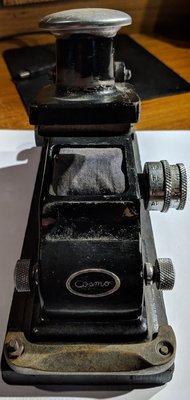 Cosmo Dater Stamper Front c.1990 Archive: Kevin Fehn |
 Cosmo Dater Stamper Date Wheel c.1990 Archive: Kevin Fehn |
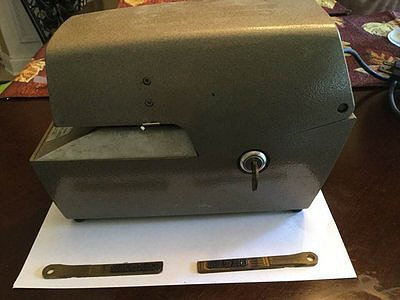 Rapidprint Electric Stamper c.1995+ The photo of the electric dater
shows the right side that is opened with the key visible to change the
date or adjust the ribbon by hand. On the front of the machine above it
reads RAPIDPRINT. The brass insert plate that it has reads 29 PENN STATION
29 with the MTA logo. The plate has a The insert plates are slid in under the two screws visible on the upper side and the notch on the plate helps holds it in place. On the front lower "lip" partially visible is the suppliers name and phone number. On the back is a plate affixed with the manufacturer's name and model information. Info: Mike McEnaney |
||||||||
|
LIRR/MTA official validator plates for Rockville Centre 3 and Penn Station 22 Photo/Archive: Steve Melrose |
|||||||||||
|
Rockville Centre 3 and Penn Station 22
numbers represent a particular Station Agent. Busy stations like Jamaica,
Atlantic Avenue, Mineola, Hempstead, Hicksville, and Ronkonkoma may have
may had 3 or more regular Station Agents. These stations will most likely
have at least one or two EXTRA Station Agents. Penn has the most regular
Station Agents, and therefore more EXTRA Station Agent dater dies; which
are not only on the strip dater dies, but for earlier square and round
dater dies. Info: Steve Melrose |
|||||||||||
|
From what I remember the Ajax
stampers, they did not last long - 1980 to 1982 was the period. I do
recall that some stamps included the seller's IBM number in that short
time span and I believe that some did not want their employee number
openly used in that manner.
The LIRR went with the Rapidprint Electric Stamper (above right) beginning
in 1995 resulting from a suit by an employee that got carpal tunnel in
their forearms from repeated motion of stamping tickets. The Cosmo stamps
had the MTA logo and did not have LIRR as all previous stamps had. RMLI
has one of these stampers along with a few of the die stamp plates used.
Info: Mike McEnaney |
|||||||||||
|
|
|||||||||||
| CFR's (CASH FARE RECEIPTS) | |||||||||||
|
Trainmen had to carry cash fare receipt (CFR) books 3.25" x 10.5" while on duty. CFR's (cash fare receipts) were
purchased on board the train and issued by trainmen, conductors, and
ticket collectors. Issued under the authority Prior to the institution of the “C” series CFR’s there were multiple form variations starting in the Howard Mapes Smith era when appointed LIRR Traffic Manager 4/02/1888 and later to GPA on 4/12/1901. Most all were printed
on flimsy paper which would disintegrate over time unless carefully
preserved. USRA stock continued to be sold until exhausted foe example
CFR’s, Form 19 train orders, ticket office stock, etc.
|
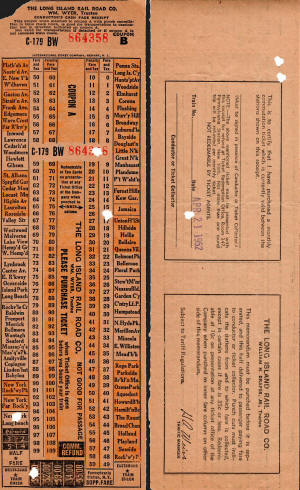 CFR Form C-179 Traffic Mgr. Weiss |
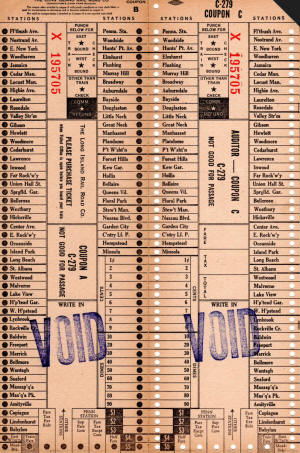 CFR Form C-279 Weiss 1st Version Back of form is blank. |
|||||||||
|
Forms 178 (steam lines) and 179 (electric lines) were
the basic one way CFR’s from the 30’s through the early 50’s. There
were round trip excursion CFR’s (form 123 through 126) as well as
special purpose CFR’s (e.g., local electric service in Brooklyn), but
I won’t deal with them here. At one point, the letter C was added as a
prefix to the form numbers (I didn’t research the date for this
transition). |
|||||||||||
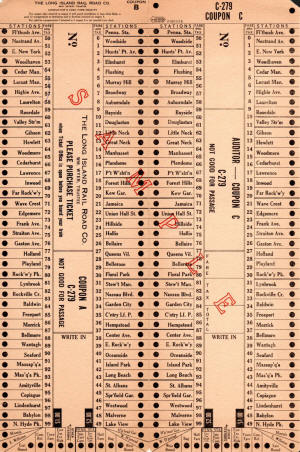 CFR Form C-279 Weiss 1st Version - Proof |
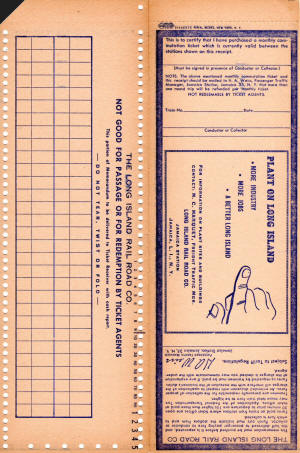 CFR Form C-279 Pass Traffic Mgr: Weiss 1st Version - Revised back of form. |
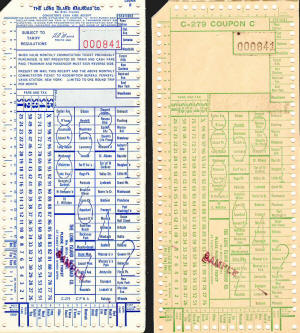 CFR Form C-279 c.1950 Traffic Mgr: Weiss Transition
|
|||||||||
|
Not being satisfied with the first version, what was
the genesis of the long-lived CFR format came next. The first scan
shows a draft of the new form. You’ll note there are no holes in the
conductors portion as this was only a printer’s draft. Note: Wm. Wyer
trustee is shown. The reverse is blank. Apparently everyone was happy
and the form went into regular use. The next scans are
the first “live” versions CFR which became standard through the
1970’s. Note the signature of Weiss as Passenger Traffic Manager on
the reverse dating this to post March 1953. Also, there is no longer
any mention of a trustee so this first version was also post
reorganization (8/12/1954, I believe). |
|||||||||||
|
|
|||||||||||
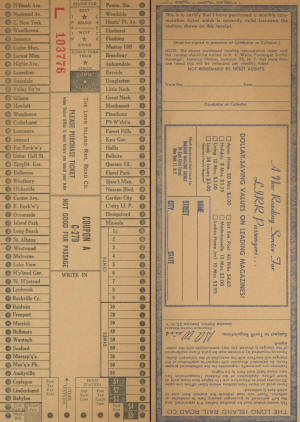 Form C-279 electric territory - c.1960 Passenger Traffic Manager: Weiss
Form C-278 for non-electric territory and Form C-279 for electric
territory. 1955-1960 period for the C-279 because it's signed by H. A.
(Henry) Weiss. Mid-1960s for the C-278 as it's signed by Throop with
the “Travel Easy” ad panel on the back with new MP75s pictured, but no
mention of the World’s Fair. Perhaps from 1966 or 1963, when the MP75s
were delivered? |
 Form 279 back ads- Plant on Long Island Magazine Subscriptions Passenger Traffic Manager: Weiss
|
 CFR Form 279 4/06/1963 1st Train to Babylon Temporary Station Archive: Brad Phillips Considered a receipt if the “Other than Train Check” block is punched (above). A ticket AND a receipt if that block is not punched. In that case the small coupon B at the top is taken by the conductor of the connecting train and the remaining coupon A is the passenger’s receipt. Almost all of these circumstances are when changing in Jamaica, either east or west, but could be a various junction points (Babylon, Mineola, etc.). Archive/Info: Brad Phillips As trips
on the LIRR frequently involved changes of trains (and, thus, ticket
collectors), there needed to be a way to document paid passage when a
CFR was issued on the train. The “train check” blocks accomplished
this. |
|||||||||

 Form 279 back -Travel Easy General Manager-Passenger: Throop 1964-65 |
 Form 279 back -Travel Easy - no refund General Manager-Passenger: Throop c.1965-1967 |
|
|||||||||
|
|
|||||||||||
| FORM CF-1 and CF-1A | |||||||||||
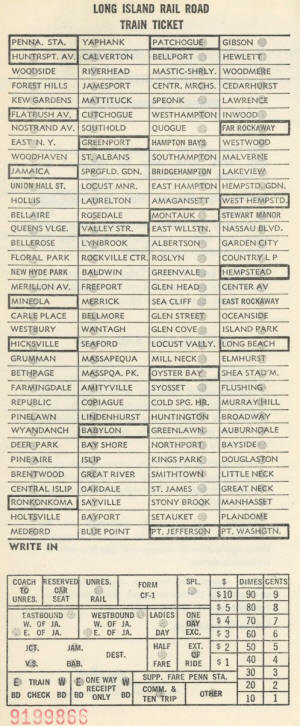 Form CF-1 1969
|
Henry Weiss’s obituary in The NY Times of 12/4/1964 indicated he died while attending a conference in Philadelphia. He was Passenger Traffic Manager from 1953 to 1962 when Throop took over. Note Throop's title in the first group (above section) is General Manager-Passenger, then as Director-Passenger Service 1969-1970 Director-Station Operations 1970-1971. Jeff Erlitz |
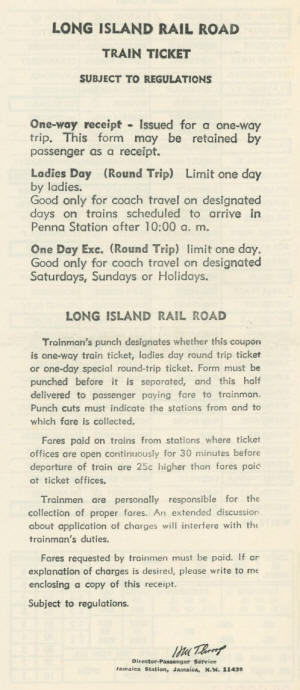 Form CF-1 back - 1969 Director-Passenger Service Throop 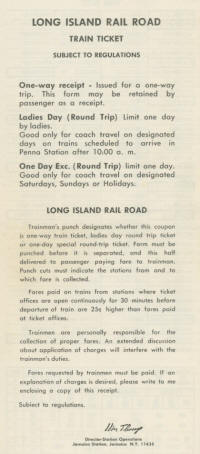 Form CF-1A back 1970-1971 Director-Station Operations: Throop Archive: Jeff Erlitz |
|||||||||
|
Form CF-1 was introduced on 8/15/1969. Based on that, I surmise that
CF-1A came out in 1970 since it still shows Bellaire, which per the NY
Times 6/18/1972 due to low ridership Bellaire, will be closed on June 26, 1972 with issue of new timetable. Archive: Jeff Erlitz |
|||||||||||
|
|
|||||||||||
| CFR Round Trip - form sERIES 120 | |||||||||||
 Form 124 Series A - GPA: Shaw 8/15/1939 |
 Form 124 Series A - GPA: Bannard 1/13/1948 |
 Form 124 Series A back - GPA: Bannard 1/13/1948 |
|||||||||
 Form 125 Series C - GPA: Pennington 2/19/1942 |
 Form 125 Series C - GPA: Pennington 8/24/1942 |
 Form 125 Series A - GPA: Comer 10/08/1945 |
|||||||||
|
Going and Return coupons are handed to passengers
still attached. The
|
. |
Round Trip CFR’s were issued in the Form 120 series starting in the late 1930’s with the transition to PRR style tickets and carried into the 1970’s. |
|||||||||
 Form C-126 first new format Special One Day Round Trip Appointed Passenger Traffic Manager: Weiss 1953+ |
 Form C-126 first new format Special One Day Round Trip back Appointed Passenger Traffic Manager: Weiss 1953+ |
||||||||||
 Form C-126 fare increase w/h added side holes Passenger Traffic Manager: Weiss |
 Form C-126 fare increase w/h added side holes back Passenger Traffic Manager: Weiss |
With the appointment of Henry A. Weiss from Traffic Manager, in 1953, to Passenger Traffic Manager new Form C-120 series versions (a, b, c, etc.) had changed prices and/or a different arrangement of station names on the form.
|
|||||||||
 Form C 126B side holes - 3/22/1963 GPA: Throop |
 Form C 126B side holes back - 3/22/1963 GPA: Throop |
||||||||||
 Form C 126f side holes - 10/08/1968 General Manager-Passenger: Throop |
 Form C 126f side holes back - 10/08/1968 General Manager-Passenger: Throop |
||||||||||
|
|
|||||||||||
 Form 177 9/09/1935 - GPA: Shaw |
Used when a passenger holding a monthly ticket forgets it and has to pay the regular fare. It entitles the passenger to a refund for that fare if turned in along with the expired monthly to the Jamaica traffic dept.
This accommodation was continued through the early 1970’s. You’ll note on the one way CFR’s a shaded punch block for “comm refund.” On the reverse is the certification signed by the customer similar to the wording on this form 177.
|
||||||||||
 Form 178 one way 1909 - GPA: Howard M. Smith from 4/12/1901-1920 |
Note: prior to Penn Station September, 1910 opening so date. It includes the obscure stations east of Amagansett (Fanny Bartlett, etc.). |
||||||||||

 Form 180 - GPA: Shaw, Pennington |
 Form 180: - GPA: Finnegan |
||||||||||
|
A higher fare was charged for trips (commutation, OW and RT) to Penn Station vs. Brooklyn or LI City (Brooklyn and LI City fares are the same). The form 180 was used when a passenger presented a Brooklyn or LI City ticket for a trip to Penn Station. The trainman collected the difference in cash, the amount being preprinted or punched on the receipt. You’ll note that the fare difference was 5 cents in the Shaw era (equivalent today is $1.15). Later, the fare differences changed and new versions of the form 180 were printed to accommodate the various differences. These forms were not called supplemental tickets and were used for OW, RT and commutation tickets. At some point, these CFR’s were discontinued with just the multi-trip supplemental tickets for commutation ticket holders remaining. At that point, trainmen would collect the fare differential for OW and RT passengers using the regular CFR’s (e.g., form C-179). |
|||||||||||
 Form 182 round trip - USRA WW I - GPA: Smith 30 day RT excursion for the “Northside”, i.e., Whitestone and Port
Washington branches. I don’t know why they’re using such a
specialized ticket. Perhaps easier for trainmen not having so many
stations to find when issuing on crowded trains. Note Penn Station is
now in use. As issued under the USRA, therefore the printing date is after
12/28/1917 and prior to 3/1/1920. |
|
Tickets Archive: Brad Phillips |
|||||||||
 |
|||||||||||
|
The amounts are preprinted and are all at five cent intervals. I suspect this was used on the Mitchell field/Salisbury shuttle trains, but I don’t know for sure, as “through tickets” were not used on the shuttle. You had to pay your cash fare to/from Country Life Press each time. There were also multiple ride book tickets for the shuttle. I would venture this could also have been used to collect the Penn Station supplemental fares or fares on the local electrics as well. A mystery lost to time. |
|||||||||||
 Form 185 round trip - GPA: Woodward 1921-1929 |
|
||||||||||
 Form 187 one way - GPA: Woodward |
Regular one way CFR, same comments as form 185, except no dates specified as
not needed on a one way.
Form 215 (right) is the same as Form 187 except they’ve jammed all stations onto a larger
form. Note that this is for a “continuous” trip |
 Form 215 one way - GPA: Woodward |
|||||||||
 Form C-193 "Ticket Honored, But Not Lifted" |
|||||||||||
|
Honored means that the passenger was carried for some segment of the trip covered by the ticket. Not lifted means the ticket was left in the passenger’s possession as the passenger will need the ticket to complete the trip on another train. An example is, in today’s terms, when a passenger has to change trains in Jamaica to go to FBA (Flatbush Ave.) vs. NYP (NY Penn). The trainman on the NY Penn train punches the ticket to indicate a partial trip and the ticket is returned to the passenger to be given to the trainman on the Brooklyn train. The final trainman keeps (“lifts”) the ticket for turn in at the ticket receiver’s office. I had never seen this form prior to
finding it on eBay and cannot find any reference to it in Conductor’s
Instructions. Conceivably, this was used for a defined period of time
to survey traffic patterns and/or perhaps provide input for design of
a new form of ticket. Just conjecture! Brad Phillips |
|||||||||||
 Form B 365 round trip - General Manager-Passenger: Throop 1964-1969? |
This is an obvious test format prepared in the H. M. Throop General
Manager-Passenger time frame (1/01/1964-1969?).
You can see the “cut and paste” for the HM Throop signature and LIRR name. To my knowledge, this was never used in actual service. If it was, we’d see many examples floating around online (internet, eBay, etc.). |
||||||||||
|
|
|||||||||||
| LOCAL ELECTRIC LINES | |||||||||||
| The below receipts (GPA-Shaw 1934) were used on the local electric trains which ran separately from the “long distance” through trains (they ran from FBA to Queens Village and Belmont Park). They used a different series of CFR’s, had separate ticket-office-issued tickets and had separate public timetables. |
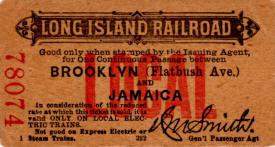 Local Electric Form 322 LOCAL Brooklyn (FBA)-Jamaica c.1915 GPA Smith
|
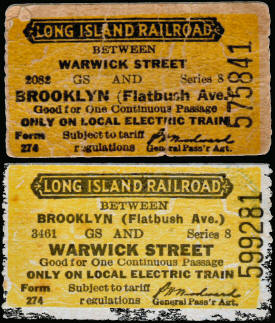 Local Electric Form 274 c.1925 - GPA Woodward |
|||||||||
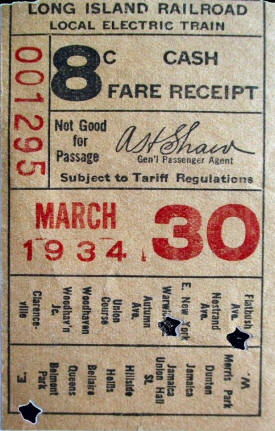
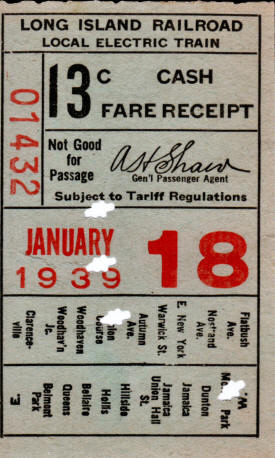 Local Electric Train Cash Fare Receipts 8¢ and 13¢ GPA A.H. Shaw |
|||||||||||
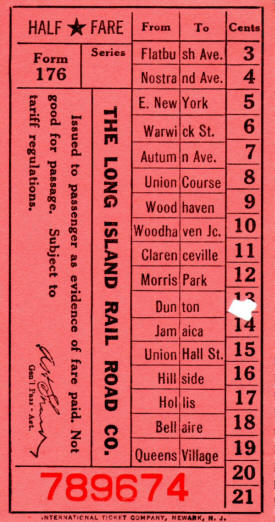 Local Electric Form 176 Half-Fare c.1935 GPA Shaw |
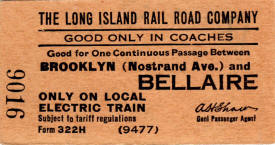 Local Electric Form 322H - Brooklyn-Bellaire c.1940 GPA Shaw
Material Archive: Brad Phillips |
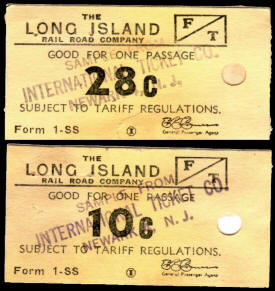 Local Electric Form 1-SS - International Ticket Co. Samples c.1945 GPA E..R. Comer
|
|||||||||
| MAGNETIC TICKETS | |||||||||||
|
NY Times archives – July 2, 1964: The Tristate
Transportation Committee started an experiment yesterday in electronic
ticket punching that could reduce costs through automated ticket
handling. The one‐year experiment is taking place at the Kew Gardens
and Forest Hills stations of the Long Island Rail Road in Queens. The majority of commuters seemed to take the experiment in stride, however, and several were pleased because they felt it might lead to faster ticket handling or cheaper fares through future automation. “I think we've got to eventually automate these commuter lines if they're going to stay in business,” one said. Officials of the railroad and the Tristate Transportation Committee, which covers New York, New Jersey and Connecticut, were on hand at both stations to show commuters how the new system works and to guide them through the turnstiles. The railroad has reduced monthly commuter fares from
$26.50 to $22 at both stations in an effort to make the experiment
attractive and to encourage more commuters to ride the trains instead
of the IND subway, which also serves both points. Transportation
experts have said in the past that both railway stations might be
closed because the majority of commuters use the subway. NY
Times archives – July 2, 1964 |
|||||||||||
|
This was for a one-year experiment sponsored by the Tri-State
Transportation Committee starting on July 1, 1964. The TSTC was
the metropolitan planning organization predecessor of the Tri-State
Regional Planning Commission and, after 1982, New York Metropolitan
Transportation Commission. The turnstiles were installed on the
westbound platforms only and passengers still had to show these
magnetic tickets to the conductors/trainmen/collectors on board the
trains. |
|||||||||||
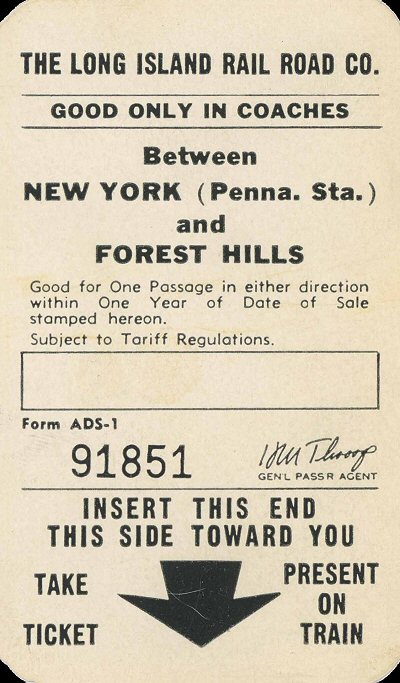 Magnetic Ticket Form ADS-1 Penn-Forest Hills Archive: Jeff Erlitz |
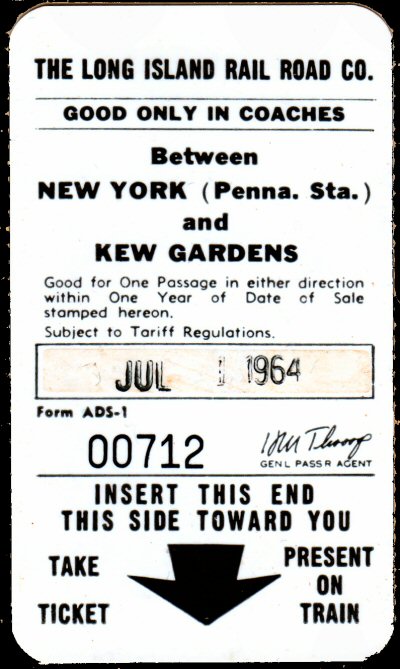 Magnetic Ticket Form ADS-1 Penn-Kew Gardens 7/01/1964 Archive: Brad Phillips |
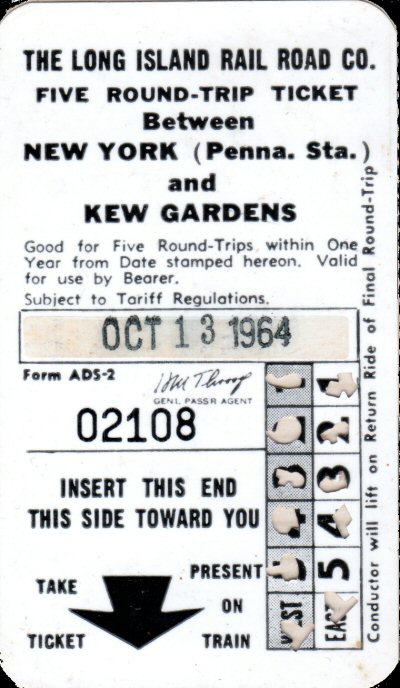 Magnetic Ticket Form ADS-2 Five Round Trip Ticket Penn-Kew Gardens 10/13/1964 Archive: Brad Phillips |
|||||||||
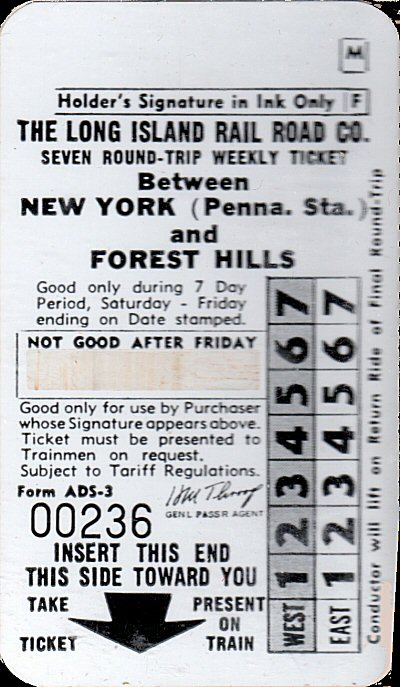 Magnetic Ticket Form ADS-3 Seven Day Round Trip Ticket Penn-Forest Hills Archive: Brad Phillips |
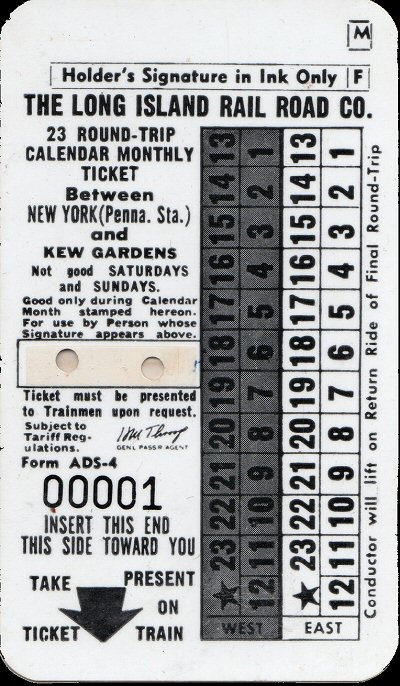 Magnetic Ticket Form ADS-4 Monthly Round Trip Ticket Penn-Kew Gardens 7/01/1964 Archive: Brad Phillips |
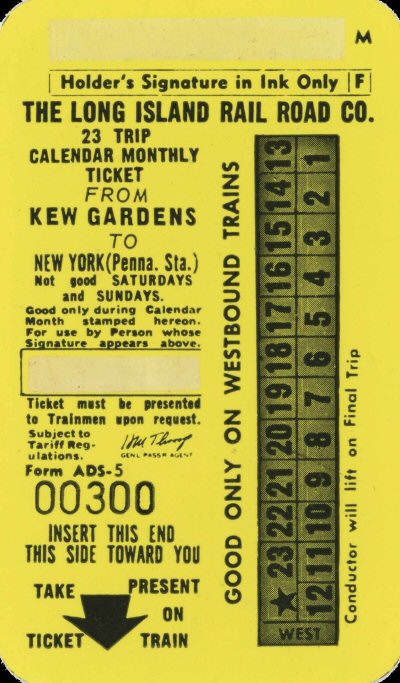 Magnetic Ticket Form ADS-5 Monthly westbound only from Kew Gardens-Penn Archive: Jeff Erlitz |
|||||||||
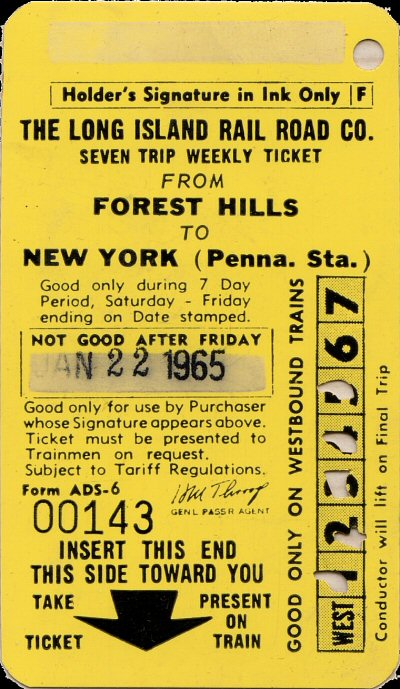 Magnetic Ticket Form ADS-6 Seven Trip Weekly westbound Forest Hills-Penn 1/22/1965 Archive: Brad Phillips |
|||||||||||
| INTERLINE TICKETS | |||||||||||
|
There were many forms of the paper
ticket with preprinted origin and/or destination as well as
multi-coupon “skeleton” (i.e., open with no origin or destination
specified) tickets. The multi-coupon booklet was initiated in the
1950’s under H. A. Weiss, but paper forms were used right up to the
end (evidence HM Throop’s signature on the 1967 paper ticket below).
I have no idea why the paper forms were not totally discontinued.
Perhaps because one-coupon trips were common (on the PRR, New Haven,
etc.) and the paper ticket was cheaper to print than the multi-coupon
book. The LIRR stopped selling these tickets on 12/31/1967. Research:
Brad Phillips |
|||||||||||
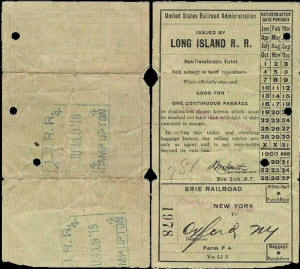 Interline Ticket Form 4 - Camp Upton, NY to Oxford, NY via Erie RR 7/19/1919
This is an interline ticket book used to sell passage over other railroads. The LIRR, much to my dismay, discontinued issuing foreign line tickets and checking baggage on 12/31/1967. |
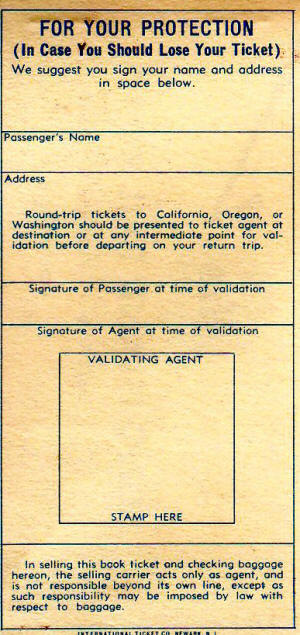 Interline ticket book inside of front cover. The older paper
forms used for off-line trips, and |
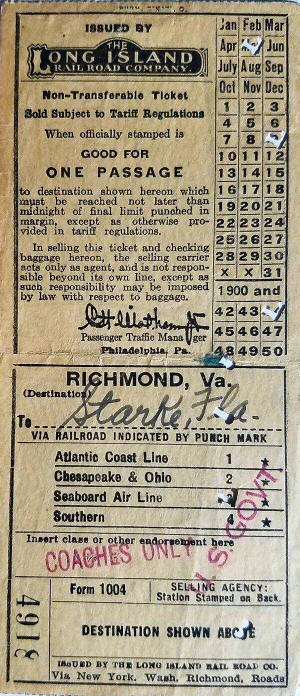 Interline Ticket Form 1004 - Camp Upton, NY to Starke, FL via SAL 5/09/1944 |
|||||||||
 Interline ticket One Way (OW) Form 1005 Archive: Brad Phillips |
 Interline Round trip (RT) ticket Form X-1005 Archive: Brad Phillips |
The LIRR had many different forms covering the railroads to Florida and the south as the bulk of traffic headed that way from NY. Note the date range (1942 -1950) Info: Brad Phillips Interesting to see the connections to the “Fallen Flags” railroads involved in this small selection: PRR, ERIE, SAL, FEC, ACL, C&O, SRR, CRR of NJ, NYC, EL, NYNH&H (via Hell gate), and NYS&W.
|
|||||||||
 Interline tickets Form 1042 and 1043 based on routing destinations. Form 1042 for Ogden, UT via the Southern Pacific Railroad. Form 1043 for St. Paul, MN via the PRR to Chicago. |
 |
Additionally, The LIRR had many different forms covering the railroads westbound from NY. Info: Brad Phillips Interesting to see the connections to the “Fallen Flags” railroads involved in this small selection: CB&Q (Burlington), C&NW, CGW, CMStP&P (Milwaukee Road), IC, CRI&P (Rock Island), SOO Line, GN, Minn. & St. Louis, and NP.
|
|||||||||
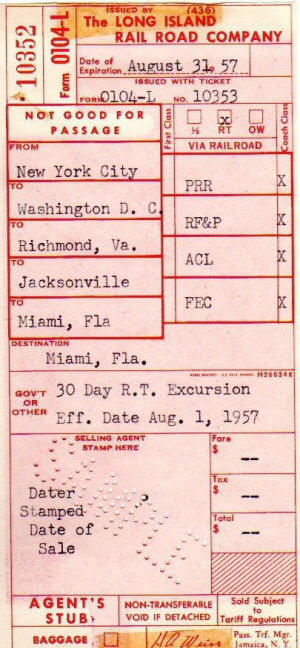 Interline Ticket Form 0104-L - 30 day return trip excursion Penn NY to Miami 8/01/1957 An excursion ticket implies duplicate routing in
both directions. Many railroads had tourist tariffs which enabled
passengers to select different routings to visit different cities,
parks, etc. For example, when I took a circle trip around the US in
1968 the tariff authorized a free side trip to San Diego from LA. This
is an example of a round trip which required 2 books to have enough
coupons for all the railroad involved. Archive: Brad Phillips |
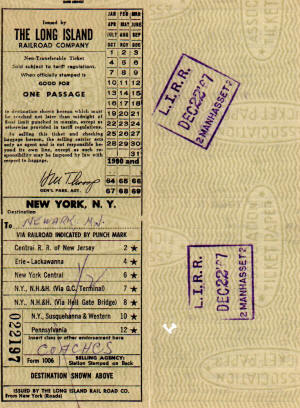 Interline Ticket Form 1006 for one passage Penn NY to Newark 12/22/1967 Archive: Brad Phillips When a station did not have half-fare (kids under 12) printed stock, regular stock was annotated “1/2” and the appropriate fare charged. The slash mark (called a “cut mark”) was put on the ticket by the clerk when he was closing out his books for the day; it indicated that this particular ticket form was accounted for on that day. These forms did not have a LIRR coupon. They were for passage from NYP to NYN (Newark). There are “skeleton” forms of which a coupon could be used for LIRR travel but most clerks would just sell a regular LIRR form 1H OW (one way) to NYP and then issue the interline ticket for the foreign road.
|
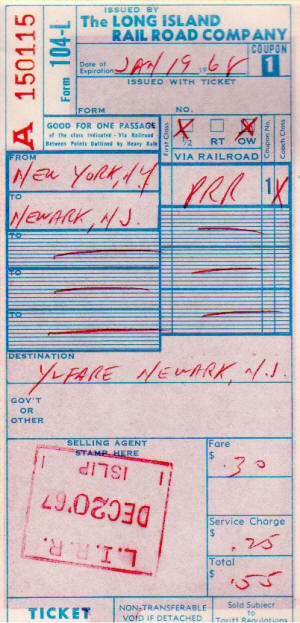 Interline Ticket Form 104-L Penn NY to NJ via PRR 1/19/1968 Archive: Brad Phillips The booklets were multifunction. They could be used for any class of service, length of trip, type of fare, etc. This particular ticket is a regular ½ OW which expired 1 month after issue.
|
|||||||||
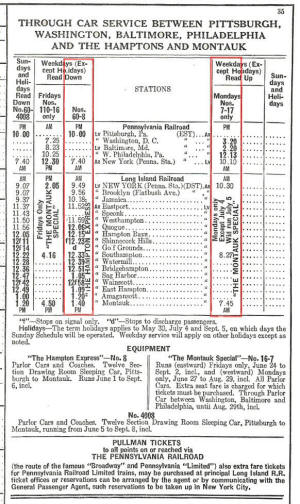 |
An example of when the PRR would have sold Interline Tickets for
Montauk via the LIRR Hampton Express/Montauk Special. Hampton
Express through Parlor Car service between Pittsburgh and the
Hamptons/Montauk LIRR timetable 5/1927, at left. |
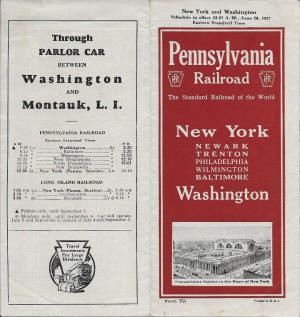 |
|||||||||
|
|
|||||||||||
| Accounting Department Station Codes | |||||||||||
|
When a railroad has been around as long as the LIRR has, you often don't have to look too far to see vestiges of a time long past. While that can often be in physical form (with historic building or station elements holding on through various renovations), or outdated operating practices (LIRR certainly has no shortage of archaic ways of doing things), you can sometimes even come across relics of the old ages in unexpected places. One interesting example of these is the four-digit station codes the LIRR uses in most of its ticket selling systems. These four-digit codes (starting with a 9###) date back to at least the 1940's when they were used by the Pennsylvania Railroad's Accounting Department to organize and keep track of all of the PRR's stations and facilities. These codes are still
used by the LIRR to this day. They are used in the railroad's Central
Support System (CSS) which is the backbone system for the Ticket
Vending Machines (TVM's) and Ticket office Machines (TOM's) through
which most tickets are sold. You can see these codes in use if you
ever look at the top of the receipt you get from a TVM or ticket
window (it lists the station name and the 9xxx station code on the
fourth line):
Note: Metro-North uses a different numbering scheme entirely. Their machines are numbered sequentially with TOM's numbered 200-299, blue card-only CTVM's numbered 300-399, STVM's numbered 400-499, full service TVM's numbered 500-699, and Daily ETVM's numbered 700-899. There is no sequence or order to them, but I have a list of which machines are at which stations available here. TVM numbers are posted on a plaque just below the screen. This machine 38402 is located at Bellmore (station 9384), is a full service machine (fourth digit 0) and is the second full-service machine here (fifth digit 2) (Photo: The LIRR Today) A full list of the 9xxx station codes for the LIRR's current stations can be found here (look in the AD column, fourth from the left). If you try to piece together the old Accounting Department station codes, you'll notice there are quite a lot of gaps. These gaps represent both the dozens of LIRR stations that have been closed since the 1940's as well as gaps that were left in the original numbering scheme for potential future stations down the line (e.g. if the LIRR wanted to build a station between Lindenhurst and Babylon at some point in the future, they could fit it in the numbering scheme between 9391 and 9393 without disrupting the sequential numbering, even though there has never been a station between them before).
These excerpts below are taken from LIRR's
ADL-205 manual printed around the early 1950's and show many of the
codes for stations that are still used today and others that have
been long abandoned (the ADL-205 manual is another thing that still
exists in a similar form to this day): When the temporary Shinnecock Hills station was rebuilt in 2018 for the US Open, the LIRR just reused its old station code for the station that used to exist in that location (Southampton Campus, code 9437). For the other new stations that just opened or currently under construction, the railroad has had to work the new stations into their existing systems. For the new Elmont station that opened just last month, it has been assigned code 9126. This is slightly out of sequence from the other stations in this area. There was no gap left between Belmont Park (9129) and Bellerose stations (9130) in the original number scheme (even amid the opulence in early 20th Century railroading, the PRR never envisioned someone building a new station within walking distance of three others here), but it was inserted into a gap just after Queens Village (9125). NY-Grand Central already appears to be in the CSS system, with a code of 1 (a handful of "NYCT Monthly Uniticket" sales between LIRR stations and NY-Grand Central have wound up in the ticket sales data over the past couple of years). 1 is Metro-North's station code for NY-Grand Central (they just number sequentially starting at 1 for NYG on the Hudson Line, 100 for the Harlem Line, and 200 for the New Haven Line). Since both railroads use the same backend system, I guess we'll have to see whether the MTA keeps the 1 code for LIRR's tickets to/from NY-Grand Central or if they attempt to differentiate the LIRR and Metro-North portions of Grand Central... [This item appeared first on The LIRR Today.] |
|||||||||||
|
|
|||||||||||
| TVM TICKETS | |||||||||||
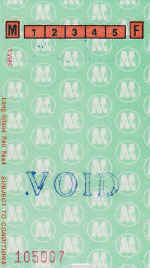
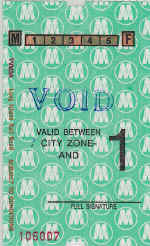 S&B TVM Commutation Tickets 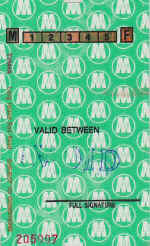
|
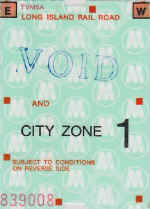 One Way TVM ticket from NY Zone 1. These were used in the old S&B TVMs (1986 to 1996) in Penn Station.
TVM material compliments of Kevin Fehn unless noted. |
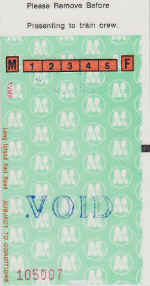 Agent Systems TVM Ticket The black square on the right side was used as a registration mark for cutting.
|
|||||||||
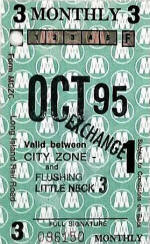
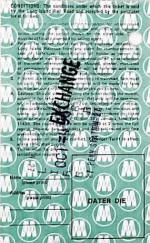 Ticket Form MCZC - Exchange Monthly City Zone 1 to Zone 3 Flushing/Little Neck 10/1995 From eBay material |
An exchange is when a lower price ticket is exchanged for a higher. E.g., the passenger has a Zone 3 ticket and now wants to commute to Zone 4. The difference in fare is collected and the new ticket is stamped “Exchange” so, in the event that a refund is subsequently requested, the refund bureau is aware that an adjustment may be required. Of course, the old ticket is retained by the agent. There’s not an “Exchange Ticket” per se; the endorsement is applied by rubber stamp to the new ticket, as noted. There are passage tickets which have a coupon to be exchanged for another mode of transport, e.g., the Captree fishing tickets. Turn in the stub for the boat ride, etc. There could be (have been) many of those situations over the years. Info: Brad Phillips
|
||||||||||
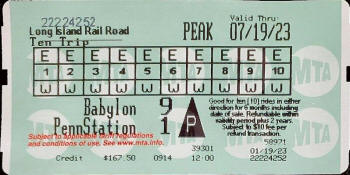 TSM 10 Trip Peak- - Valid for 6 months Babylon-Zone9 and Penn-Zone1 1/19/2023 On the receipt (right) one can see the Accounting Dep't
Station code for Babylon #9393 TSM (Ticket Selling Machines) are the system used by ticket clerks in the station locations. Since 2001, they have been able to dispense pre-encoded MetroCards.
|
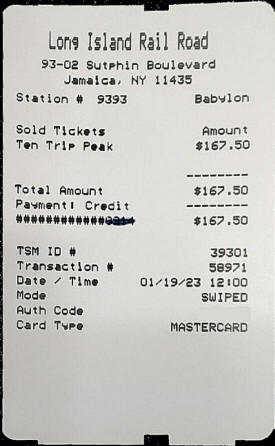 |
||||||||||
|
|
|||||||||||
| TICKET VENDING MACHINES | |||||||||||
|
|
 NY Penn ticket vending machine "AUTOMATICKET" 1949 - Archive: Brooklyn Public Library |
||||||||||
|
TVMs (Ticket Vending Machines) Timeline for the LIRR: From MTA site: On Board Fare
Trains • TVMs are serviced by
Agents/Clerk teams from several headquarters locations. Crews
performed revenue, fingertip maintenance as remedial maintenance is
performed under contract with the manufacturer. On-Board Fares: It is not
charged at Pinelawn and from Yaphank east to Greenport.
All the other stations have TVMs or ticket offices. The Montauk Branch
received TVMs several years ago all the way to Montauk. Info:
Kevin Fehn |
|||||||||||
 TVM manufactured by Auteicia, a Swiss company. Flushing Station - 1985 Photo: Norman Gates Archive: Eugene Powell |
 TVM NY Penn - c.1986 Photo/Archive: Robert Beck |
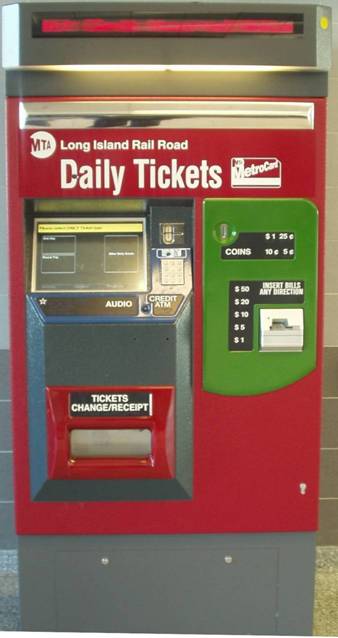 ETVM was the Daily machine that only sold one way tickets. Some called it an Express TVM. The Daily machine number series stated at 70,
i.e. 39070. |
|||||||||
|
|
 Southampton existing S&B (Scheidt & Bachmann) ticket machines 6/2023 - Photo/Archive: The LIRR Today |
|
|||||||||
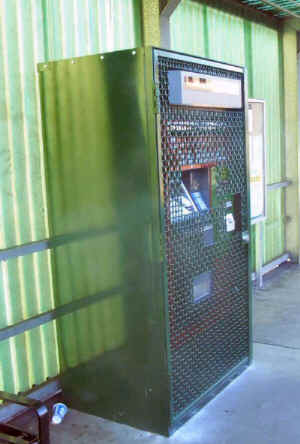 Nostrand Ave TVM Cage 1/10/2002
|
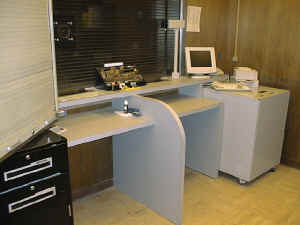 A TOM is the Ticket Office Machine which replaced the old ticket cases and daters. It is basically a TVM built for use by the Agent or Clerk in the ticket office. It replaced around 150 years of manual sales. No more tour books.
|
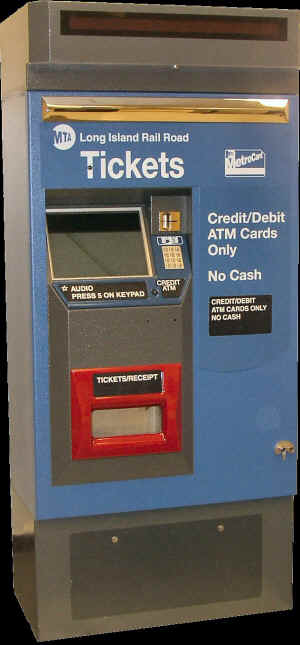 TVM Cards Only - No Cash Introduced around late 2007/ early 2008. The photo is one of the first units built. All
TVMS material compliments of |
|||||||||
 Mineola Station S&B Ticket Vending Machine (TVM) - 8/20/2025 Photo/Archive: Jake Rothman |
|||||||||||
|
|
|||||||||||
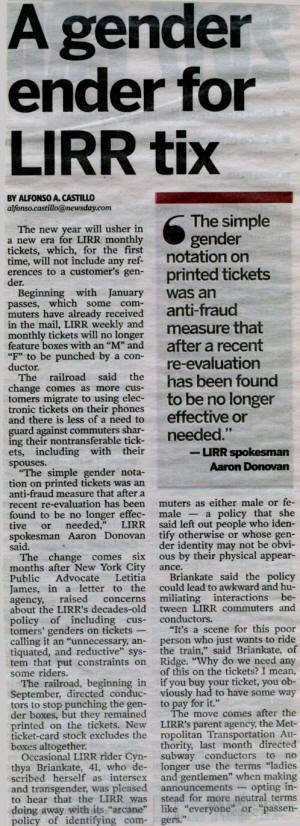 No gender on LIRR tickets - Newsday 12/31/2017 |
|||||||||||
|
Ticket office hours had remained relatively constant until the mid-1950’s. Note: Weekdays included Saturday, so an amazing number of ticket offices were open on Saturday with M-F hours. Arverne-Straiton, Blue Point, Island Park, Seaside all show “closed” on weekdays which could indicate that they had open offices shortly before the date of this list. These could also be offices that are open only “in season” (i.e., Summer) but that doesn’t make sense for Blue Point and, possibly, Island Park. Earlier Employee Timetables (ETT) did not include ticket office hours, so I can only surmise. St. Albans was open until late night
on Sunday (Navy Hospital) and had two meal breaks. Ozone Park
had two lunch breaks. Setauket was only open for one hour, 20
minutes. Pinelawn was open every weekday, but just in the
morning. It is interesting how many small stations were open on
Sunday (e.g., Queens Village, Broadway, Woodmere).
Research: Brad Phillips |
|||||||||||
 LIRR Ticket Offices - 6/03/1968 |
 LIRR Ticket Office Listing - 1999 Compiled: Kevin Wong from archived MTA/LIRR website pages as of 1999 |
||||||||||
|
|
|||||||||||
|
From Trains Magazine Newswire:
The Long Island Rail Road will cut the number of stations
with ticket agents as of Jan. 1, 2020 The Long Island Rail Road will cut the number of stations with ticket agents as of Jan. 1, 2020, while also ending cash ticket sales aboard trains, the blog LIRR Today reported Monday. The changes are part of the Metropolitan Transportation Authority’s comprehensive 2020 Preliminary Budget plan released in July. They are part of a three-year budget plan to address substantial expected deficits. The cuts will leave less than 20 stations with ticket agents; as recently as 1996, there were 100 such locations. The plan is to eliminate seven ticket offices, of which five are currently part-time and two full-time; the stations involved have not been specified. The proposal also includes plans to reduce weekend hours at two additional stations, the number of agents on duty at Jamaica station, and use of a minimum number of agents at the Moynihan Station in New York, slated to open in 2021. Crews will also no longer accept cash payments on board LIRR trains as of Jan. 1. Riders are increasingly using less cash to purchase tickets, opting to pay digitally through electronic transactions. Onboard payment will only be by electronic tickets, credit card, and debit card. Cash payment will remain an option at ticket windows or station vending machines. The new policy will reduce back-office and ticket-remittance personnel, which will result in the closing of three additional offices. Staff changes will come through attrition or assignment to the Moynihan Station when it opens. The moves, expected to save over $1.5 million in personnel and office costs, will be voted on along with the rest of the 2020 budget at the MTA’s December 2019 board meeting. Courtesy: Brad Phillips |
|||||||||||
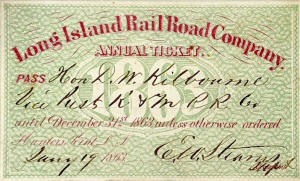


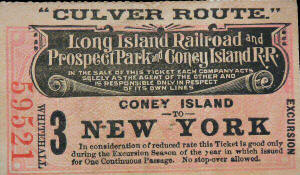



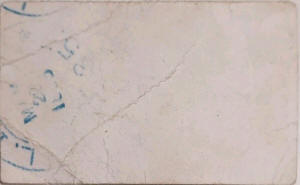
















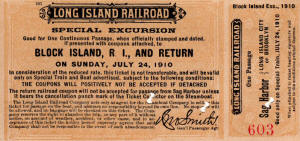
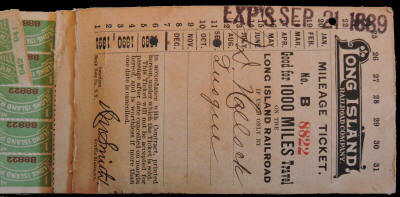

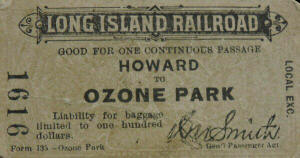
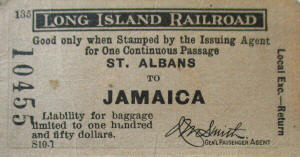
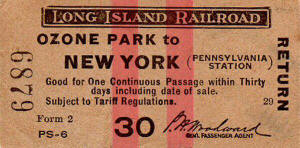
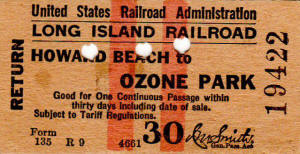
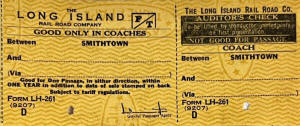
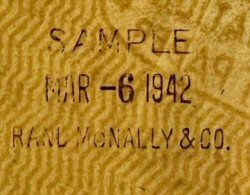
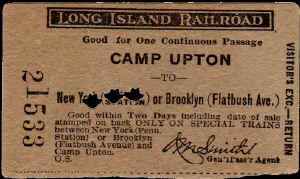
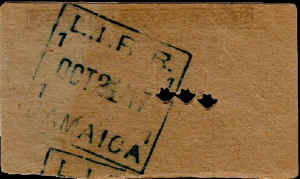
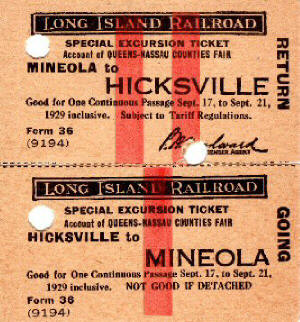
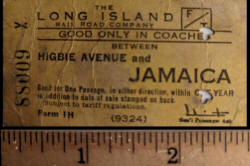
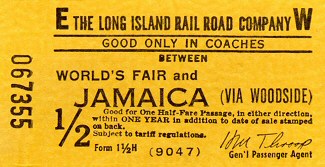
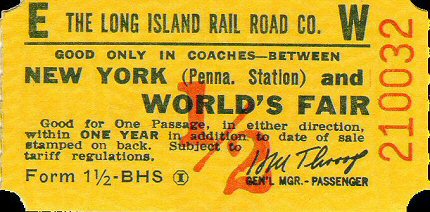


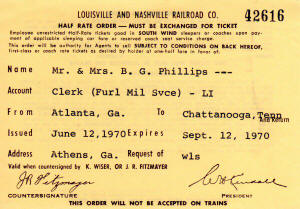
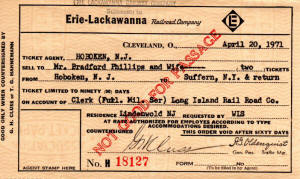
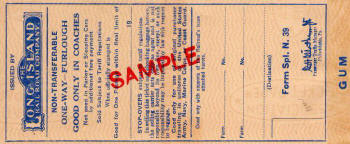



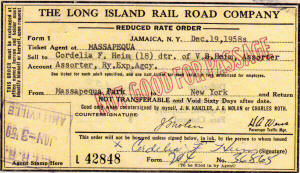
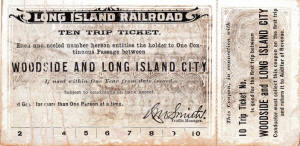
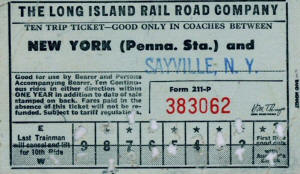
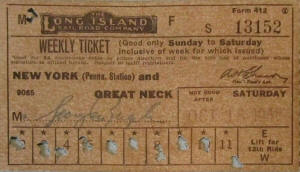


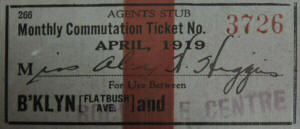

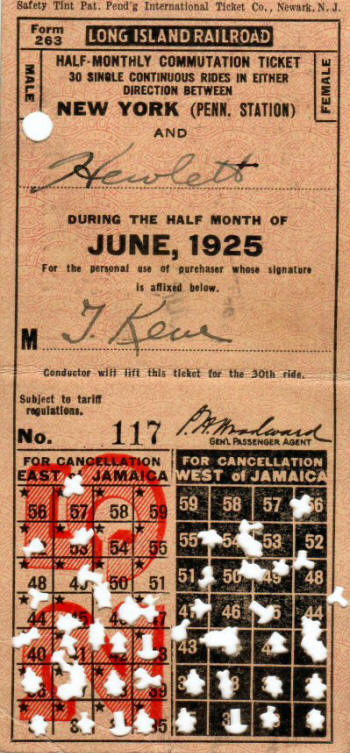
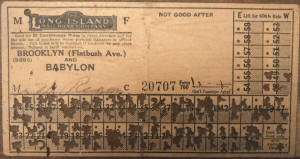
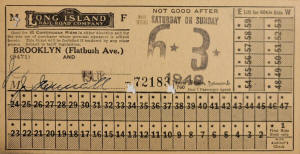
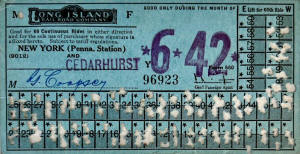
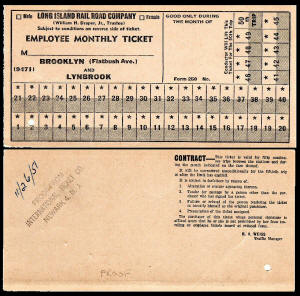



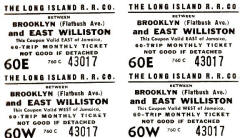

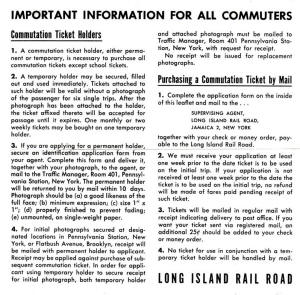

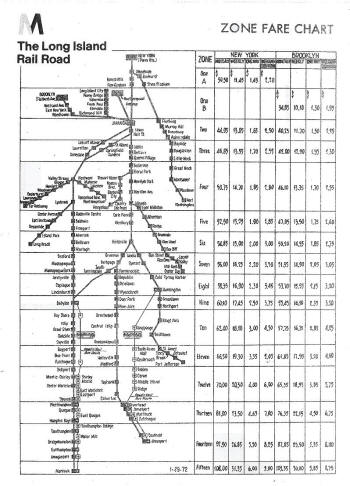
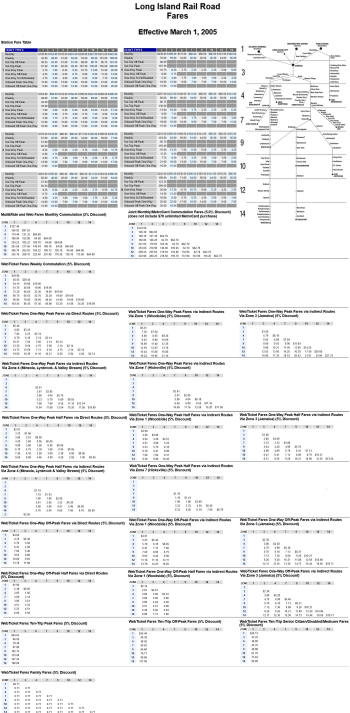
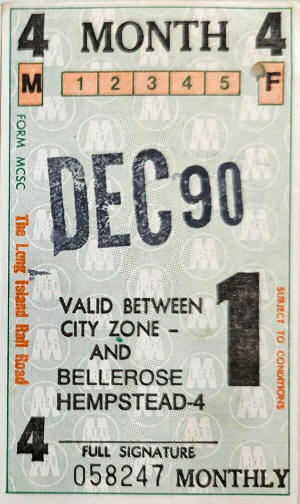
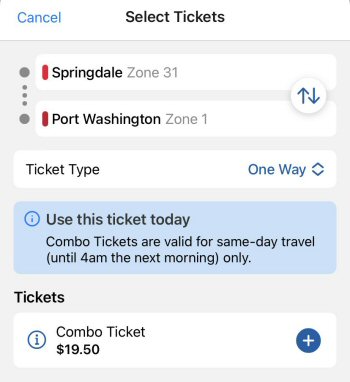
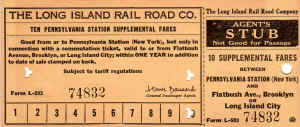
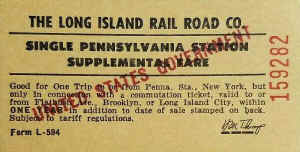
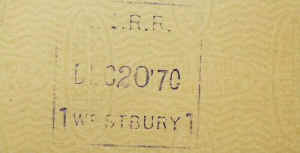




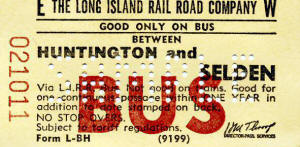
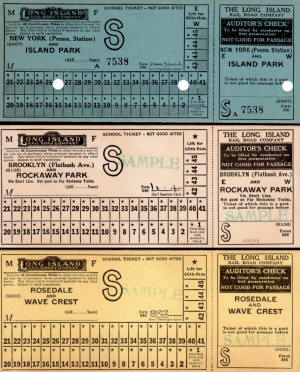
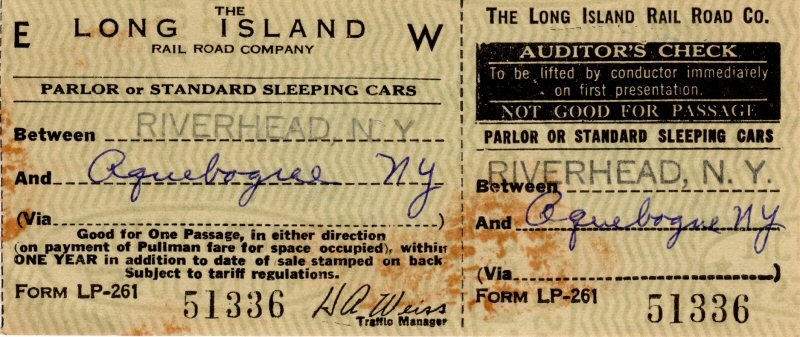

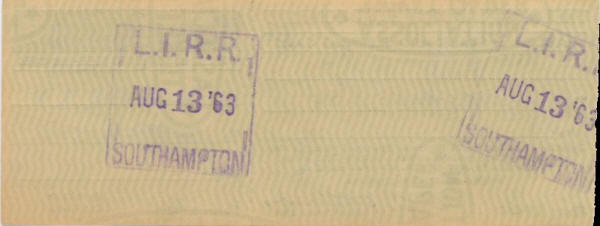

 These
became obsolete in the 1950s when the railroad adopted "V cut"
cash-fare receipts (CFR) where the origin, destination, fare and type
of fare were sidecut into the edge of the heavy paper tickets.
These
became obsolete in the 1950s when the railroad adopted "V cut"
cash-fare receipts (CFR) where the origin, destination, fare and type
of fare were sidecut into the edge of the heavy paper tickets.

